

One Day in Yosemite Itinerary – How to Spend a Perfect Day in Yosemite National Park
While a day trip to Yosemite may be somewhat different compared with the city crawling itineraries regularly found on this website, this departure will hopefully come as a breath of fresh air, both figuratively and literally. A veritable monument to nature ranking among the top 5 most visited national parks in the USA, Yosemite is seen as a place of rest, where visitors can get in touch with nature, heal and escape the burdens of their stressful everyday lives. Somewhat ironically, Yosemite shares its name with the roughest, toughest little man is ever crossed the Rio Grande, even though this National Park is anything but little. On your day trip to Yosemite, prepare to be overwhelmed by dramatic, stunning landscapes filled with granite monoliths, towering waterfalls, idyllic meadows, and pristine forests.

Plan your trip
Yosemite is where you want to go? Here’s everything you need to know about this incredible destination. Plan your Yosemite day trip down to the tiniest detail.
1. WHAT’S THE BEST TIME TO VISIT YOSEMITE? 2. A FEW FACTS ABOUT YOSEMITE 3. One Day in Yosemite Itinerary 3.1. Start Your Day by Visiting Tunnel View 3.2. Head for Yosemite Village 3.3. Pay a Visit to the Ansel Adams Gallery & the Yosemite Museum 3.4. Grab Some Lunch Before Heading Out 3.5. Take the Yosemite Shuttle Bus to Glacier Point 3.6. Check Out Lower Yosemite Falls 3.7. Wind Down with Dinner and Drinks 4. WHERE TO STAY IN YOSEMITE? 5. DAY TRIPS FROM YOSEMITE 6. EXTRA TIPS FOR VISITING YOSEMITE
WHAT’S THE BEST TIME TO VISIT YOSEMITE?
Yosemite is open for visitors year-round , even though most visitors arrive between late spring and early autumn. The winter months, primarily December, January and February, are markedly less popular. It is a shame really, because there are still plenty of things to do at Yosemite during the winter, and the scenery is even more stunningly beautiful, with snow-covered mountaintops and frozen waterfalls forming peculiar snow cones. Not to mention, if you visit then, it will feel like you have Yosemite all to yourself.

On the other hand, the alpine wildflowers of Tuolumne Meadows reach peak bloom in July and August. In addition, Tioga Road, leading to the meadow, is only open seasonally, as soon as the snow has been cleared in the spring. Many other parts of the park are also closed during the off-season. Consequently, the best time to visit Yosemite would be from mid-May through the middle of September . The falls, Bridalveil in particular, reach their peak in May.
A FEW FACTS ABOUT YOSEMITE
A natural wonder covering an area of 747,956 acres, Yosemite was designated a World Heritage site in 1984, although it had inspired and awed visitors for the first time 8,000 to 10,000 years before that.
After visiting Yosemite, John Muir famously called it “by far the grandest of all the special temples of Nature I was ever permitted to enter”, while President Teddy Roosevelt likened a day trip to Yosemite to “lying in a great solemn cathedral, far vaster and more beautiful than any built by the hand of man.”

Today, more than 95% of the park is designated wilderness, with minimal impact from human activities. Before the arrival of European settlers, the Ahwahnechee (″Yosemite Valley People″) lived in the Yosemite Valley . Exploring their cultural heritage is certainly among the best things to do in Yosemite National Park. Their neighbors, the Miwok, thought that they were particularly territorial, calling them Yohhe’meti, meaning “those who kill” or “they are killers”. Somehow, it was this name that caught on after being chosen by Lafayette Houghton Bunnell, the first non-Native American to visit Yosemite Valley.
TIP: Items you should bring with on your trip to Yosemite – Water Sports Shoes – Hiking Boots – Flask Watter Bottle – Backpack – Bug Spray – Sun Shielding Hat or Ball Cap – Sunglasses
Yosemite is located in the western part of California’s Sierra Nevada mountain range, with the drive from San Francisco to Yosemite National Park taking about four to four and a half hours.
One Day in Yosemite Itinerary
Follow this guide and make the best of your trip even if you’re short on time. These are the top sights and things to do on your one day in Yosemite.
TIP: Taking travel insurance is always a good idea, especially if you were planning to go hiking. Stay safe and protect yourself with the help of WorldNomads.com .
Start Your Day by Visiting Tunnel View
When you enter the Yosemite Valley from the west, you should start your visit by making a small detour to Tunnel View, a scenic overlook on State Route 41. Take in the sweeping, iconic views of Yosemite Valley, with many of the well-known things to see in Yosemite right at your fingertips.
As you look towards the east, you will see Bridalveil Fall on the right, El Capitan (a massive 3,000 feet granite monolith) on the left, with Half Dome’s distinct shape trapped in between further in the distance. Most visitors spending one day in Yosemite don’t stray from Yosemite Valley. The 8-mile long valley is open year-round and packed with jaw-dropping scenery.

As you make your way towards your next stop, Yosemite Village, make sure to stop at the base of Bridalveil Fall , only a short drive from Tunnel View. The Ahwahnechee believed that inhaling the mists of Bridalveil Fall increases one’s chances of getting married. Now you know what to do in Yosemite if you’re looking for love or if you are hoping that your significant other will finally pop the question.

Head for Yosemite Village
Tunnel View notwithstanding, when visiting Yosemite, you should make Yosemite Village both your base and your starting point.
Leave your car at the visitor parking as soon as you arrive and explore the rest of the Valley Floor on foot, by bicycle, or by taking advantage of the Yosemite shuttle service , which can take you to all major Valley attractions completely free of charge.

But before we get to that, briefly visit the Yosemite Valley Visitor Center , a veritable treasure trove of information on all things Yosemite. Featuring a bookstore selling maps, Yosemite guidebooks, and souvenirs, the Yosemite Valley Visitor Center is the obligatory first stop on your one day in Yosemite.
Pay a Visit to the Ansel Adams Gallery & the Yosemite Museum
The Ansel Adams Gallery is right next door, featuring some of the most famous works of the accomplished landscape photographer and environmentalist, whose black-and-white photos of the American West have fired up the national imagination through their numerous reproductions on posters, books, calendars, and now the Internet as well.
The Yosemite Valley Museum is also right there in front of the Yosemite Valley Visitor Center. Completed in 1925, the museum was designed by architect Herbert Maier. Since it was the first building in the national park system that was originally constructed as a museum, it served as a model for other parks in the USA. The museum’s original collection consists of priceless Native American baskets, whose unique beauty still wows visitors today. The museum’s layout serves an educational purpose, since visitors are encouraged to view the exhibits in chronological order.
Grab Some Lunch Before Heading Out
For moderate and experienced hikers, there’s never a shortage of things to do in Yosemite National Park. After all, Yosemite features 800 miles of hiking trails. Even if you don’t plan on hiking a single mile, a day at the park often requires quite a bit of walking, and you wouldn’t want to face the challenges of Yosemite on an empty stomach.
Which is why you should stop for lunch before venturing further. For convenience, we recommend Degnan’s Kitchen , a cafeteria style restaurant offering sandwiches, pizzas, soups, and other lunch-type meals. It is a great place to eat if you’re visiting Yosemite with kids, and, best of all, it is next door to the gallery and museum, allowing you to save on time.
Sharing the same building, Degnan’s Loft is a bit more upscale, and is a great alternative if you’re tired of eating fast food and you’d like to go for something healthier. The restaurant opens at noon and serves both western and Asian food, in addition to tacos and nachos. Visitors get free Wi-Fi for an hour.
Take the Yosemite Shuttle Bus to Glacier Point
After lunch, take the first Yosemite shuttle bus to Washburn Point and Glacier Point, two of the park’s greatest outlooks. Enjoy the scenery as the bus makes its way along the scenic Glacier Point Road. Glacier Point itself is famous for its sweeping, top-down views of Yosemite Valley and Yosemite Falls. It also offers the best view of Half Dome in all of Yosemite. Half Dome, named after its distinctive shape, is one of Yosemite’s most recognizable landmarks.

Complete the Four Mile Trail Back to the Valley Floor
Some of Yosemite’s trails are simply too challenging and too time consuming if you’re only spending one day in Yosemite. For example, the Mist Trail to Vernal and Nevada Falls is a 5-hour hike, mostly for moderate to experienced hikers.
Apart from taking the bus, you can reach the aforementioned Glacier Point by completing the Four Mile Trail starting from the base of the Sentinel Rock. Instead, we recommend taking the Yosemite shuttle bus when going up, and then hiking down the trail, which is less strenuous, but still lets you enjoy all of the stunning sights you wouldn’t be able to see otherwise. As you descend, you will find yourself on the opposite side of Tunnel View, allowing you to admire the already familiar Yosemite Valley landmarks from a new perspective , normally not seen on postcards. Even if you take your time, completing the trail shouldn’t take more than two hours, and it’s definitely worth it, since there is arguably no better way to truly understand what’s so special about Yosemite Valley.

Check Out Lower Yosemite Falls
After you make your way back to the Valley floor, take a short walk east towards the Swinging Bridge Picnic Area. Cross the Swinging Bridge and follow the hiking trail until you reach the Lower Yosemite Falls Trailhead.
Yosemite Falls is the tallest waterfall in North America, but it flows in three sections, which can be seen from various vantage points, including the Four Mile Trail. Climbing all the way to the Upper Falls would take up an entire day, but getting a good view of the Lower Yosemite Falls should take less than an hour, with no climbing involved. Due to its atmosphere, the spot where the trail crosses the Yosemite Creek is a good place to take a short break if you’re visiting Yosemite with kids. Continuing along the trail will take you back to where you started, in front of the Yosemite Valley Visitor Center.

Wind Down with Dinner and Drinks
In the evening, there aren’t too many things to do in Yosemite in terms of going out, partying, and so on. And understandably so. However, there are a couple of places where you can enjoy a great dinner and have a few of drinks after a day of hiking.
For example, the Mountain Room Restaurant , part of the Yosemite Valley Lodge, will charm you with its rustic glass-and-wood front and warm yellow lights.
The Majestic Yosemite Hotel , on the other hand, knocks it out of the park with its awe-inspiring historic dining room and large windows overlooking a meadow. The hotel bar is open until 10 PM, with a decent selection of drinks. Formerly known as the Ahwahnee Hotel, the facility was built in the late 1920s for rich socialites visiting the area. It was used as a wartime hospital during World War II.
WHERE TO STAY IN YOSEMITE?
TIP: Click here to find the best accommodation near Yosemite Park.

Best Western Plus Yosemite Way Station
4999 Highway 140, Mariposa, CA 95338
Located in Mariposa , a quaint small town not far from the Yosemite West Gateway on Highway 140, and an hour’s drive from the Yosemite Valley, the Best Western Plus Yosemite Way Station features spacious, comfortable, air-conditioned rooms with amenities such as satellite TV and free Wi-Fi. Breakfast is included, while guests can take advantage of the hotel’s fitness center, hot tub, and seasonal outdoor swimming pool.
BOOK A ROOM HERE

Château du Sureau
48688 Victoria Lane, Oakhurst, CA 93644
Château du Sureau is Yosemite’s most exclusive experience , surpassed only by visiting the national park itself. It is located in Oakhurst, not far from Yosemite’s South Entrance on Highway 41 from Fresno. Although smaller than some of the other options, this place is a literal castle that will make you feel like royalty. All rooms come with a balcony.

Yosemite Westgate Lodge
7633 Highway 120 at Buck Meadows, Buck Meadows, CA 95321
If you’re coming from San Francisco to Yosemite National Park, you will probably be taking California’s State Route 120, known as the Big Oak Flat Road during the Gold Rush. If so, there’s no better place to stay than the Yosemite Westgate Lodge at Buck Meadows. Apart from the prime location right outside of Yosemite National Park, the Yosemite Westgate Lodge features comfortable, contemporary rooms, an outdoor hot tub, and a great restaurant next door.
DAY TRIPS FROM YOSEMITE
Finding a Yosemite day trip from San Francisco, Lake Tahoe, or Los Angeles is like shooting fish in a barrel. But what about the other way around? Say, if you ever run out of things to do in Yosemite, as unlikely as that may be? In that case, consider one of the following day trips from Yosemite to spice things up after a day at the park.
Visit the Nearby Sequoia Groves
As you may know, giant sequoias grow only in a limited area of the western Sierra Nevada. It would be a real shame to visit Yosemite without seeing the giant sequoias. The Giant Sequoia National Monument is about three and a half hours away, but there are several sequoia groves within the park itself.
The Mariposa Grove sees the most visitors , with its 1,800-year-old Grizzly Giant and the Wawona Point overlooking Wawona Valley. Other groves include the Merced Grove, the Nelder Grove, and the Tuolumne Grove. While still in Yosemite, these groves are a bit further away from the Yosemite Valley, so you should visit them either when you’re on your way there, or you should dedicate a whole day to seeing them all.

Go Fly Fishing in the Sierras
There are several companies that offer fully guided and instructional fly fishing tours in Yosemite and the surrounding High Sierra backcountry. If you are into that sort of thing, it can be one of the best things to do in Yosemite with kids and a great bonding experience. So, grab your fishing rods and head out to the Merced river, the mighty Tuolumne river, the endless Stanislaus river, or the beautiful Mokelumne river.
Book a Guided Tour
If you want to get the most out of Yosemite, your best bet is to book a guided Yosemite tour with experienced guides who know the area well. The guides are always flexible and will take your wishes and capabilities into account. Options include hiking, backpacking, sightseeing , and other adaptive adventures.

EXTRA TIPS FOR VISITING YOSEMITE
-Seeing as millions visit Yosemite each year, if you want to avoid crowds, you should steer clear of weekends if you can. Additionally, the best time to visit Yosemite National Park is early in the morning. That way, you will avoid parking issues.
-Take public transportation. YARTS is Yosemite’s public bus system, serving all of the park’s surrounding communities . For example, visitors can leave their cars in Sonora or Fresno and take the bus to Yosemite. This makes visiting the park easier – no fuss with parking, and the park entrance fee is included in the bus ticket price. The bus tickets are free for children.
-If you’re driving, you should drive slowly due to the wildlife, abundant throughout the park. Black bears are especially common. If you come across a bear, you should stay at a safe distance . If you’re carrying food, make sure it is stored properly.
PIN FOR LATER!
If you have any other propositions for this One Day in Yosemite Itinerary feel free to share it in the comments below!
Make sure you have everything you need
What to pack for your next trip.
Make your next trip as simple and as enjoyable as possible by packing smart. It’s amazing how much stress top travel items can save you, so choose carefully. Things like lightweight travel backpacks, for example, are ideal for short trips and allow you to move around with ease, and a passport holder will make sure you keep your documents safe at all times. Check our travel checklist guide for 2021 to make sure you haven’t missed anything, and travel to your next destination in style and with maximum comfort.
Related posts:

Anca is a travel writer and the founder of One Day Itinerary - the biggest collection of travel itineraries for those who are time-limited or just want to maximize their time while traveling. Although she easily becomes homesick for Croatia, she thinks travel is essential to her happiness. She has traveled to more countries than she is years old and doesn’t plan on changing that fact. In her travel guides she aims to inspire people to travel whenever they have a spare day (or two).
One comment
[…] I’d had enough of the cities, and the Pacific coast seemed too crowded. But after a bit of Googling I found the perfect destination: Yosemite! […]
Leave a Reply Cancel reply
Your email address will not be published. Required fields are marked *
Save my name, email, and website in this browser for the next time I comment.
Notify me of follow-up comments by email.
Notify me of new posts by email.
How To Spend 1 Day In Yosemite National Park (Itinerary)
Yosemite was one of the first national parks established in the United States, and in my opinion it’s one of the most beautiful places in the world.
If you only have one day in Yosemite National Park, the best way to spend it is in the valley, where you can enjoy the spectacular waterfalls, viewpoints, and hikes. Most of these are located pretty close to each other.
A side trip to the Mariposa Grove is also worthwhile to see the ancient Sequoia trees. Some of these giants are more than 3,000 years old!
You won’t see the whole park in a day, because it covers almost 1,200 square miles, but you’ll have enough time to see a lot of the main highlights.
We spent 2 weeks at Yosemite, and in this guide, I’ll show you all of the top sights to knock out on a short visit to the park!
About This Itinerary
Here’s a quick summary of all the places in this itinerary:
- Swinging Bridge Viewpoint
- Sentinel / Cook’s Meadow Loop Trail
Lower Yosemite Fall
- Cathedral Rocks Viewpoint
El Capitan Meadow
Yosemite Valley View
Tunnel View
- Washburn Point
- Glacier Point
- Big Trees Loop Trail
I’ll cover each of these places in detail, and then share a map and timeline you can follow for your itinerary.

Yosemite Falls reflection during the springtime flood
Best Things To See & Do
• swinging bridge viewpoint.
For your first stop in Yosemite, make a quick visit to the Swinging Bridge picnic area. This spot has one of the best views of Yosemite Falls in the park.
Better yet, when we visited in June, we were lucky to see an amazing reflection in the water because of the historic flooding. The Merced River had turned into a lake!
In most months you won’t see that, but it’s still worth a quick stop here to get your first good view of Yosemite Falls. This is the park’s biggest waterfall, and it’s one of the world’s tallest, at 2,425 feet (739 meters).

Another picture from the same spot at midday
• Mist Trail
Next, drive to the parking lot for the Mist Trail. This is one of the busiest hikes in Yosemite, so you’ll want to get there early to beat the crowds and secure a parking spot.
You can park at Curry Village or the Yosemite Valley Trailhead Parking . The latter is closer and saves you 10 minutes of walking, but the former has a cafe if you want to grab something to eat before or after the hike.
The Mist Trail is a wonderful hike with two big waterfalls: Vernal Fall and Nevada Fall. If you’re a fit hiker, it’s well worth going at least to the top of Vernal Fall. Otherwise, you can enjoy a nice rainbow below the waterfall.

Vernal Fall rainbow

Above Vernal Fall. There’s a safety fence so you can take pictures like this without worrying.
The Mist Trail is a moderate hike with plenty of elevation gain, even if you stop before Nevada Fall. If you’re not up for that, you can substitute this hike for Mirror Lake, which is all flat and easy.
When you reach the top of Vernal Fall, if you continue for a short distance you’ll get a nice peek at Nevada Fall and the Liberty Cap without adding much to the hike.
Or, you can hike up to Clark Point for an even higher view of Vernal Fall, and then circle back down to the start via the John Muir Trail. Either way, you’ll get a nice variety of scenery in 2 or 3 hours of total hiking.
Remember to bring water, snacks, and sturdy hiking shoes. A poncho can also be handy so you don’t get too wet at the waterfall. That’s how the Mist Trail got its name!

The Liberty Cap and Nevada Fall

Vernal Fall as seen from above near Clark Point. See the tiny people?
• Sentinel / Cook’s Meadow Loop Trail
After you finish the Mist Trail, it’s time to see more of the valley. Drive to the Yosemite Falls Vantage Point and find parking. Here’s a map .
From here, you can walk the Cook’s Meadow loop trail, which is flat, easy, and mostly paved or boardwalked, making it accessible for strollers and wheelchairs.
Anyone can and should do this trail, because it’s so relaxed and it has some of the best views of Yosemite Falls and the valley!
If you walk the whole trail, it takes up to 1 hour, but you’ll get to see some great scenery even if you turn back after 15 minutes. If you’re lucky, you might see deer or other animals along the way, like we did.

• Lower Yosemite Fall
It’s time to go see another waterfall up close! Drive to the Lower Yosemite Fall trailhead , park, and hike to the waterfall.
As you’ll notice, Yosemite Falls is actually a three-part waterfall, with upper, middle, and lower falls. This hike gives you a great view of the bottom waterfall.
It’s another short, flat, easy, and accessible hike, and it takes about 30 minutes roundtrip. Anyone can do it.
Along the way, you’ll get peeks of the Upper Yosemite Fall through the trees, and the hike ends at the Lower Fall, which you can see up close.

Yosemite Falls peeking through the trees

• Yosemite Valley Lodge
If you need to grab lunch at this point in the itinerary, you can do that at the nearby Yosemite Lodge Food Court , which is just a 2 minute drive or a 5 minute walk from where you parked for the lower falls.
While you’re at it, there’s also a gift shop and Starbucks, so you can pick up a shirt, mug, magnet, or other souvenirs from the park.
If you packed a picnic lunch for the day, there are plenty of spots in the valley where you can enjoy your meal with a view. The next one you’ll pass driving west is the El Capitan picnic area.
• Cathedral Rocks Viewpoint
This is an unmarked and unnamed viewpoint, but I have to mention it because it’s worth stopping for pictures.
As you continue driving west on the valley loop road, after you pass the El Capitan picnic area, and before you reach a curve in the river called the Devil’s Elbow, there’s a pull-off spot with epic views of the Cathedral Rocks.
I’ve marked the coordinates on the map here . There’s a small parking space with room for a few cars.

Cathedral Rocks viewpoint

Incredible cliffs
• El Capitan Meadow
The El Capitan meadow is right by the road, and it’s one of my favorite spots in the whole park.
It has beautiful views of the Cathedral Rocks across the meadow, and you can look straight up at El Capitan, the sheer granite monolith that was climbed by Alex Honnold without any equipment in the Free Solo documentary.
People like to come here with lawn chairs so they can sit and watch the climbers going up the side of El Capitan. It’s a great place to visit in the afternoon.

• Yosemite Valley View
This is another viewpoint that’s right by the road, and it’s one of the last places you’ll stop in the valley.
It has excellent views of the Merced River, El Capitan, Cathedral Rocks, and Bridalveil Fall. We even saw a big rainbow at Bridalveil in the afternoon.

Bridalveil Fall rainbow
• Tunnel View
The Tunnel View is one of the most iconic views of Yosemite because you can look straight through the valley, all the way to Half Dome.
So why save it until later in the day? Simple: early in the morning, it’s completely backlit and hard to take photos. Afternoon is the perfect time to see it.
Yes, there will be crowds, but parking is usually easy to find because there’s a lot of turnover. People snap their pictures and leave pretty quickly.

• Washburn Point
Now that you’ve seen the Yosemite valley from below, it’s time to see it from above!
Drive out of the valley and up to Glacier Point, the best overlook of the park. The drive from Tunnel View to Glacier Point will take about 45 minutes.
Along the way, you’ll pass Washburn Point, which is worth a stop too. It has similar but slightly different views of the park, and you can see the whole Mist Trail from above, including Vernal and Nevada Falls.

Views of Yosemite on the way to Glacier Point
• Glacier Point
Up next is Glacier Point, where you can see more of the famous Yosemite icons from above!
This overlook has great views of Yosemite Falls and the sheer face of Half Dome , which almost seems close enough to reach out and touch. You won’t be able to see the hikers scaling the cables on Half Dome since that’s all on the opposite side of the peak.
If you want to do more exploring at Glacier Point, there are some great hiking trails here, such as Taft Point or the Panorama Trail.

Half Dome as seen from Glacier Point
• Big Trees Loop Trail
The last stop on this itinerary for Yosemite is the Mariposa Grove of Giant Sequoias, where you can see some of the world’s oldest and biggest trees.
From Glacier Point, it’s a 1 hour drive to the Mariposa Grove Welcome Plaza, where you can hop on one of the free shuttle buses that runs every 15 minutes. The shuttle ride to the sequoia grove only takes 5 or 10 minutes.
Here, you’ll want to hike at least part of the Big Trees Loop Trail, which is spectacular. It’s also relatively flat and easy.

Bachelor And Three Graces

Roots of the Fallen Giant
If you’re short on time, you should hike at least as far as the Grizzly Giant and the Tunnel Tree, which takes about 1 hour roundtrip. Most people turn around at this point.
These are two of the most notable and impressive trees in the park. The Grizzly Giant is the oldest sequoia in the grove, and one of the oldest trees in the world. It’s currently estimated to be more than 3,000 years old!
The Tunnel Tree is a short distance past the Grizzly Giant, and it’s a fun photo op since the base is hollow. That was done in 1895 so horse drawn stagecoaches could pass through the tree.
This is the end of your itinerary for one day in Yosemite National Park. You’ve now seen many of the best highlights of the park!

The Grizzly Giant is a huge tree

Grizzly Giant

Tunnel Tree
Map Of Things To See & Do
Here’s a map of all the sights and activities listed in this Yosemite itinerary. You can click on the icons for directions and other information.
Timeline For Your Visit
Here’s a suggested timeline you can follow for your itinerary in Yosemite.
The park is extremely popular and usually starts to fill up by 8 AM, so I’d highly recommend starting early in the morning if you can.
This will allow you to secure parking and beat the worst of the crowds, and the valley is also extra nice at dawn.
- 6:00 AM – Leave Oakhurst or Mariposa and drive to Yosemite National Park (if you’re staying in the valley, you can start later).
- 8:00 AM – Arrive in Yosemite valley and start hiking the Mist Trail.
- 9:30 AM – Reach the top of Vernal Fall on the Mist Trail, and start hiking back to the parking.
- 10:30 AM – Finish the Mist Trail and arrive back at the parking lot. Drive to the Yosemite Falls Vantage Point and find parking.
- 11:00 AM – Walk the Sentinel / Cook’s Meadow loop trail.
- 11:30 AM – Drive to the Lower Yosemite Fall trailhead , park, and hike to the waterfall.
- 12:00 PM – Grab lunch at the nearby Yosemite Lodge Food Court .

Mirror Lake lives up to its name
- 12:30 PM – Continue driving the loop road, stopping at the viewpoints for the Cathedral Rocks, El Capitan Meadow, and Yosemite Valley View, in that order, and then stop at the Tunnel View on the way out of the valley.
- 1:30 PM – Exit the valley and start driving to Glacier Point. Along the way, stop at Washburn Point for the views.
- 2:30 PM – Arrive at Glacier Point and look around at the viewpoint.
- 3:00 PM – Start driving to the Mariposa Grove Welcome Plaza.
- 4:00 PM – Arrive at the Mariposa Grove and grab a shuttle to the grove.
- 4:15 PM – Hike the loop trail as far as the Grizzly Giant and the Tunnel Tree, then back to the shuttle area.
- 5:15 PM – Grab a shuttle back to the Mariposa Grove Welcome Plaza.
- 5:30 PM – Arrive back at the Mariposa Grove Welcome Plaza. Leave the park and start driving back to Oakhurst or Mariposa.
- 6:00 / 6:30 PM – Arrive back at your accommodation in Oakhurst or Mariposa in time to grab supper.

Other Tips For Visiting Yosemite
- Reservation: Remember to check the NPS page to see if reservations will be required during your visit.
- Entrance Fee: A park pass is always required at Yosemite. You can find more info on the NPS page .
- Navigation: The road inside the valley is a loop road, and it’s not always easy to backtrack if you miss something. It’s a good idea to plan your route ahead of time so you can see everything you want.
- Parking: Parking can be a challenge, especially during peak season. The valley has a free shuttle system, but we found it to be pretty slow and inefficient. If you start early, you can drive your car everywhere on this itinerary and the shuttle won’t be needed.
- Clothing: Dress in layers. Even summer mornings can be chilly in Yosemite, but the weather warms up during the day.
- When To Visit: In my opinion, the absolute best time to visit Yosemite is in the spring months of May and June. The waterfalls are big because of the ongoing snowmelt, the weather is still cool, and the crowds aren’t at their peak yet. We went in June and it was perfect. I wouldn’t change anything.
- Where To Stay: The best hotels are in the valley, at The Ahwahnee or Yosemite Valley Lodge . If those are out of your budget then you can try to secure camping in the valley , or there are hotels in Oakhurst and Mariposa , outside the park. We stayed in Oakhurst.

A view of Half Dome from Yosemite Valley
How To Spend More Than One Day In Yosemite National Park
If you have more than one day in Yosemite, there are lots of other great things to do, especially if you’re a hiker.
For the second day, do the strenuous hike to Upper Yosemite Falls and Yosemite Point. Even if you don’t go all the way to the top, it’s still a great experience to see the waterfall up close.
Better yet, try to get permits for the Half Dome hike , which is the most thrilling hike in the park! It has a scary cable section at the end that leads you to panoramic views of the entire Yosemite valley.
For the third day, go to any places in the valley you missed on the first day, such as Bridalveil Fall and Mirror Lake. Both of these are short and easy hikes. Then do the scenic drive on Tioga Road to see Olmsted Point, Tenaya Lake, and the Tuolomne Meadows.

Upper Yosemite Falls is an awesome hike, especially in the springtime when it looks like this!
More Travel Guides For Yosemite National Park
Thanks for reading! I hope you enjoyed this itinerary for how to spend one day in Yosemite National Park.

You may also like
How to visit khao sok national park in thailand, how to visit ciletuh geopark: waterfall valley in west java, how to visit tanjung puting national park in indonesia, lower antelope canyon tour review & photos, coron vs el nido: which is better all differences explained, banggai islands travel guide & itinerary for sulawesi, leave a comment cancel reply.
Save my name, email, and website in this browser for the next time I comment.
- FREE NP ebook
- Hiking Basics
- Backpacking
- Gear Guides
- Gift Guides
- New Hampshire
- North Carolina
- West Virginia
- National Park Planning
- Bryce Canyon
- Capitol Reef
- Cuyahoga Valley
- Death Valley
- Great Sand Dunes
- Great Smoky Mountains
- Joshua Tree
- New River Gorge
- Shop Itinerary Guides & Digital Products
- Refund and Returns Policy
- Work With Me
- About Brooke In Boots
- Privacy Policy and Disclaimer
- FREE NP EBOOK
How to Spend One Epic Day in Yosemite National Park [2024 Updated]
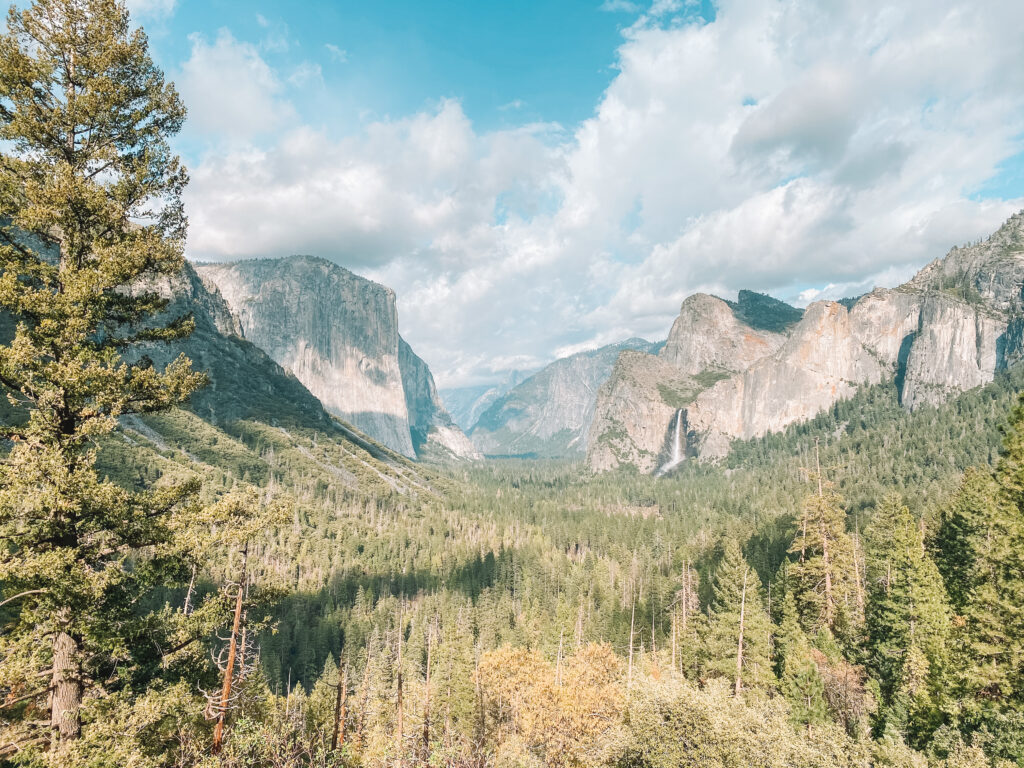
Can you actually do Yosemite in a day? The answer is absolutely yes – but if you only have a one day to spend in Yosemite, you’re going to need an expertly planned Yosemite 1 Day Itinerary!
Over the past 30something years I’ve been lucky enough to visit Yosemite at least 20 times. I’ve learned the ins-and-outs of this incredible National Park, and put together the ultimate list of must-see stops, perfect for day trips to Yosemite.
This Yosemite one day itinerary will take you to iconic sights like Yosemite Falls , hike the challenging but rewarding Mist Trail , and drive Glacier Point road for an epic sunset.
This one day Yosemite itinerary is perfect for your first trip to Yosemite. You’ll want to use this guide if you’re visiting between late-spring and late-fall, when Glacier Point Road is open.
You’ll also find helpful information below on where to stay, getting around, and important must-know details about the new 2024 reservation system .
Disclosure: This page may contain affiliate links where I earn a small commission from any purchase – at no extra cost to you. This commission helps keep Brooke In Boots up and running. As always, all opinions are 100% honest and my own!
Table of Contents
What to Do in Yosemite in One Day
If you only have one day to spend in Yosemite National Park, here are my favorite must-do activities I recommend:
- Bridalveil Falls
- Hike the Mist Trail to Vernal & Nevada Falls
- Lunch Yosemite Village
Yosemite Falls
- Tunnel View
- Glacier Point Road
- Taft Point & Sentinel Dome
Sunset at Glacier Point
This guide covers all of these stops in tons of detail, below, plus some more suggestions for how to spend an absolutely epic one day in Yosemite National Park. This itinerary assumes that you’ll be visiting when Glacier Point and Tioga roads are open, usually late spring to late fall.
I’ve also included important things to to know about planning your trip to Yosemite , below, including where to stay, how to get there, and important tips for traveling around Yosemite.
IMPORTANT YOSEMITE UPDATE: Yosemite National Park now requires day-use and peak-hours reservations to enter Yosemite for dates in February & April – October 2024. Learn more about these new changes, here.

Can You Do Yosemite in A Day?
Yosemite National Park is huge . At over 1,160 square miles, Yosemite National Park is basically the same size as the entire state of Rhode Island, and most of it is wilderness. You won’t be able to see all of Yosemite in 1 day, and frankly you wouldn’t want to!
Over the past 33 years I’ve been lucky enough to visit Yosemite at least 20 times, including some very epic day trips from San Francisco.
If you only have one day in Yosemite, I recommend picking one or two areas of the Park and exploring those areas. In this 1 day Yosemite itinerary, I suggest sticking to Yosemite Valley and Glacier Point road areas of the Park.
Have more time? Check out these 2 Day and 3 Day itineraries and spend a little more time exploring this favorite National Park.

Important Things to Know About Yosemite National Park
Before planning your 3 day Yosemite itinerary, there are a few important things you need to know.
Where is Yosemite National Park?
Yosemite National Park is in the Sierra Nevada Mountains, in east-central California.
An important thing to remember is Yosemite is huge – about 748,000 acres, or about the size of the state of Rhode Island! There are also multiple entrances to the Park , some of which close Winter to late-Spring.
How to Get to Yosemite National Park
The closest major airports near Yosemite are San Francisco, Oakland, and Sacramento International Airports.
The cities of San Francisco and San Jose, California are approximately 4 hours drive from Yosemite Valley, depending on which Yosemite entrance you use . Los Angeles is about 7 hours from Yosemite.
Whatever airport you fly into, I recommend renting a car for your visit to Yosemite. Driving a car means you’ll have way more flexibility and won’t waste precious time waiting for a shuttle bus. You don’t need a 4×4 or high-clearance vehicle in Yosemite, any sedan can manage the roads fine during the summer months.
You can also take public transportation to Yosemite via the YARTS bus system. Buses run seasonally making stops from Fresno, Merced, Sonora, and Mammoth Lakes. You can fly or take the train to one of these towns and hop on the YARTS to Yosemite. It’s a long process, and not one that I’d recommend for time, but it is possible!
Always check the Yosemite NPS website before traveling to the Park for updated road, traffic, and reservation information.
Getting Around Yosemite
If you are staying outside the Valley, you can, park in one of the designated day-use parking lots:
Parking Lots fill to capacity early during late Spring to early Fall, especially on weekends and holidays. Plan to arrive before 9AM for day-use parking lots.
Once you’ve parked in Yosemite Valley, use the massively convenient Yosemite Valley Shuttle system.
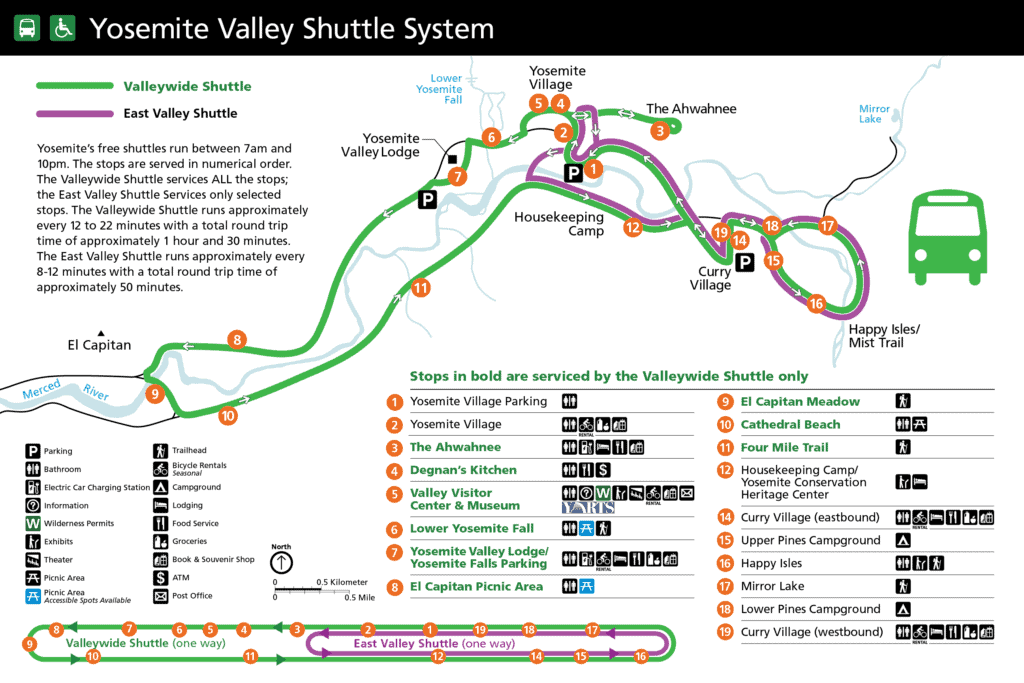
Two shuttle lines run in Yosemite Valley: the East Valley Shuttle; and the Valleywide Shuttle. Shuttles are free to use, run between 7am and 10pm, and arrive every 8 to 22 minutes.
Most major sights and trailheads within Yosemite Valley are serviced directly by a shuttle stop, and the rest are just a short 10 or 15 minute walk away.

There is no free shuttle between Yosemite Valley and Glacier Point or Tuolumne Meadows on Tioga Road. For shuttle service within the Tuolumne Meadows area you can use the Tuolumne Meadows shuttle . Parking is available at all trailheads along Tioga Road. If you get there early, you usually won’t have a problem finding a spot.
The Tuolumne Meadow Hiker shuttle picks up at the Yosemite Valley Lodge and Curry Village, with scheduled stops at popular trailheads in the Tuolumne Area. Reservations can be made online, here.
Is Yosemite Dog Friendly?
Surprisingly, Yosemite is one of the more dog friendly National Parks in California, although you’ll still be very limited where you can bring a dog here.
Dogs are permitted on fully paved roads, sidewalks, and bicycle paths, in campgrounds, and on Wawona Meadow Loop trail. Some lodging allows pets, and a seasonal kennel is available for day-use in Yosemite Village. Check out these easy hikes in Yosemite for ideas on where to bring your pooch during your visit!
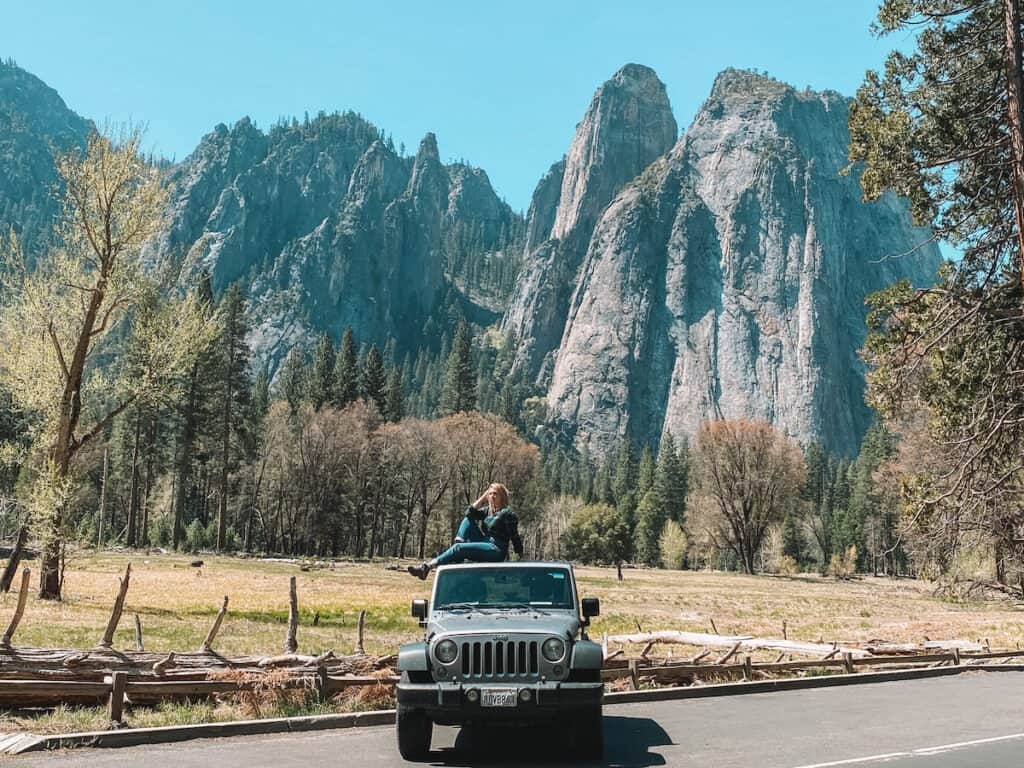
Entrance Fees & Reservations in Yosemite (Updated 2024)
There is an entrance fee of $35 per vehicle (or $20 per person if entering by foot bike or horse) for all visitors to Yosemite National Park.
Do I need a reservation for a day trip to Yosemite? Starting in spring of 2024 everyone entering Yosemite National Park will require a park entry or lodging reservation .
These new Yosemite reservations apply even if you are just driving through Yosemite or only visiting for a day.
The good news is that you don’t need an additional reservation if you have a hotel or campground reservation. Learn more about these new reservation requirements and dates, here.
Traveling to more than 2 National Parks or National Forests this year? Purchase an America the Beautiful National Parks Pass for $80, which covers entrance fees at all National Parks and NPS managed sites.
Yosemite National Park is Indigenous Land
Yosemite Valley is the ancestral home to the Ahwahneeche. From the 1800’s through the 1960’s, indigenous residents of the Valley were killed and driven from the area by disease, settlers, militia forces, and even the National Park Service. The Miwok and Paiute continue to live in and around the central Sierra Nevada.
Today, many Yosemite landmarks pay tribute to the original indigenous owners of this land, including Tenaya Lake and the grand Ahwahnee Hotel.
Want to learn more about planning an epic National Parks trip? Grab my free Ultimate National Parks Planning Guide , including 70+ pages of National Park packing checklists, planning tips, and everything you need to know to start planning a trip to all 63 National Parks!
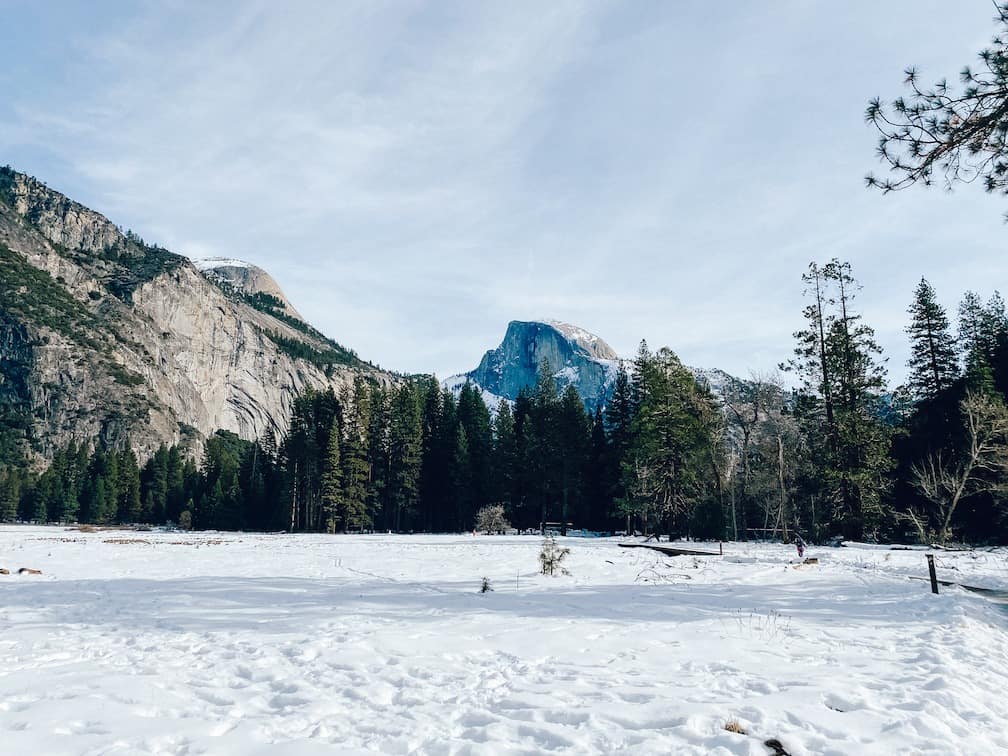
The Best Times to Visit Yosemite National Park
Park conditions change dramatically by season here, so deciding when to visit Yosemite is super important.
If this is your first visit to Yosemite, I suggest planning your trip during late-spring through late-fall. During that time most of the Park’s trails, roads, and sights are open.
Summer (June – September) is by far the most popular time to visit Yosemite National Park. If you are able to reserve a coveted hotel, campground, or reservation to enter the park, expect hot days in the valley and lots of crowds. All major roads in the park are usually open by mid-June. In early summer, waterfalls are flowing, but nearly dry up by late summer.
Most high sierra areas like Glacier Point and Tioga Road remain open until the first major snowfall in late-Fall, usually mid-November, but sometimes much later.
Glacier Point Road, Tioga Road, Mariposa Shuttle road close for winter, and dining and lodging options are limited. In exchange, you get to experience a winter wonderland, and snow play options, including Badger Pass Ski Area.
As snow melts in Spring (April – May), Yosemite’s waterfalls become roaring cascades. Tioga Road and Glacier Point usually open mid-May to early-June.
Seasonal Road Closures in Yosemite
Check out the historic road and trail opening dates to get an idea of when roads typically close and open for the winter season. While these dates give a good approximation, it is impossible to know when exactly the high Sierra roads in Yosemite will open and close every year. Late spring snow storms are extremely common in this area.
The following is a rough approximation of winter road closures in Yosemite:
- Tioga Road: closes by mid-November and reopens by early June.
- Glacier Point Road: closes by mid-November and reopens by mid-May.
- Mariposa Grove: closes by late November and reopens in May.
Take this itinerary to go! The printable Yosemite Itinerary Guide has your perfect 1, 2, or 3 day Yosemite trip completely planned for you! With over 20 pages of detailed hiking guides, printable daily itineraries, lodging and dining suggestions and more, you can spend less time planning and more time making epic memories! Check it out, here .
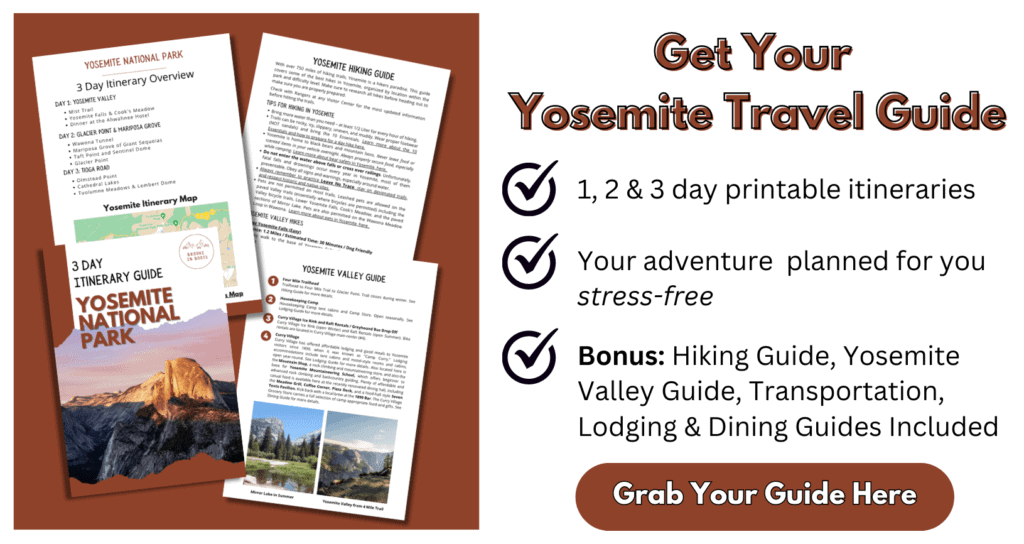
Yosemite 1 Day Itinerary
Spending 1 day in Yosemite means making the most of your short time. This itinerary is intended as an action-packed full day, meaning sunrise to sunset.
This itinerary assumes that you’ll be visiting when Glacier Point road is open, usually late spring to late fall.
If you’re entering or leaving the Park through Tioga Road (East Entrance) , you’ll want to add in a couple of hours extra driving time. If you’re traveling through Tioga Road, I highly recommend skipping Glacier Point and exploring a few stops or short hikes near Tuolumne Meadows. Read a full Tioga Road / Tuolumne Meadows itinerary on my 3 Day Yosemite Itinerary, here.
If you only have a few hours, consider picking a few activities that don’t involve too much driving – for example spending a few hours inside Yosemite Valley, or on the Glacier Point corridor.
Warning: No Cell Service!
When driving to and around Yosemite National Park, don’t expect any cell service. WiFi may be available at some lodges inside the Park, but it’s not reliable or fast. Make sure to download your driving directions and hiking maps BEFORE you enter the Sierra Mountains.
Need a map? Don’t forget to download your map and save it to your phone or GPS device before your hike! Get AllTrails+ (the most used trail app on my phone!) to download all your trail maps for offline use. Use my promo code brookeinboots30 to get 30% off your annual AllTrails+ subscription!
If you’re looking for a place to stay overnight before or after your one day in Yosemite, I’ve included some suggestions for my favorite places to stay in Yosemite at the end of this post.
Yosemite 1 Day Itinerary Map
This map shows the must-see stops on your one day in Yosemite itinerary.
How to Use This Map: Click the Icons on the map to see more information about each location. Click the star at the top of the map to add the map to your Google Maps account.
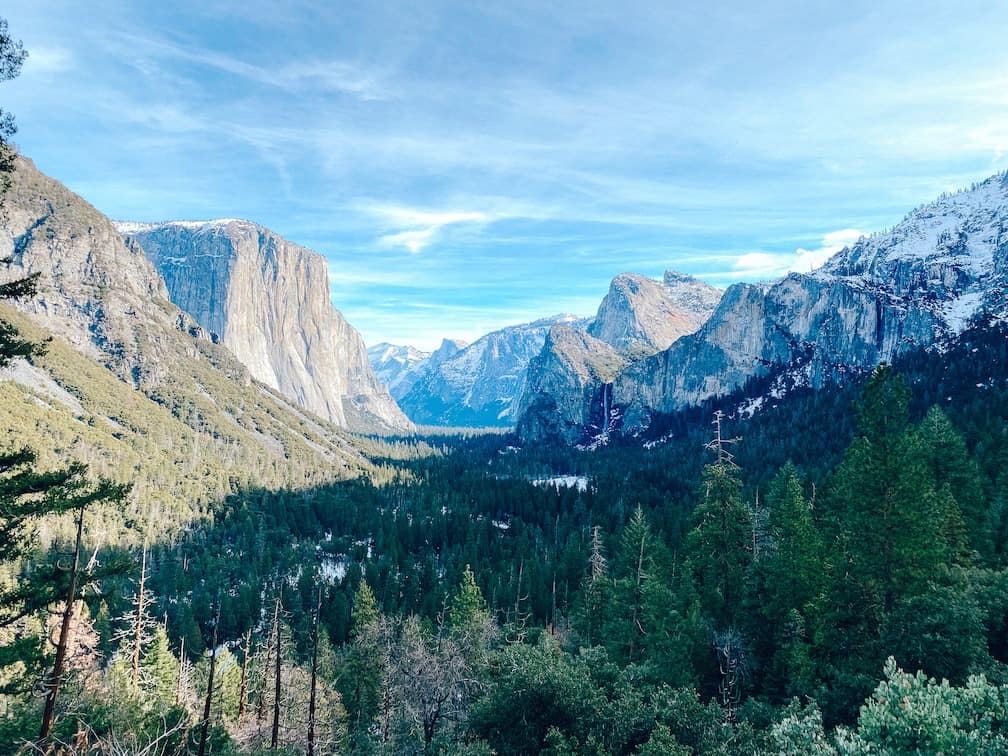
Arriving in Yosemite Valley
If you are’t staying in Yosemite the night before, you’ll want to drive into the Park as early as possible!
I suggest arriving at the Park entrance by 7am, or even earlier in the summer.
Don’t forget, remember that it takes 30 to 45 minutes to reach Yosemite Valley once you’ve entered the Park.
If you’re entering via the South/Wawona/Highway 41 Entrance, you’ll pass over Wawona Pass after entering the Park and descend via a windy road down to the Valley. Don’t miss stopping at the Wawona Tunnel Viewpoint, immediately after passing through the long Wawona Tunnel.
It’s impossible not to be totally awestruck by the view of Yosemite Valley below you from this spot. Park in the lot and grab a photo before continuing your drive.
For visitors entering from all other entrances – don’t worry, you’ll come back for this view later!

A Quick Stop at Bridalveil Falls
Bridalveil Falls cascades 620 feet into Yosemite Valley, and is often the first waterfall visitors encounter when entering the Park. Stop and park and walk the short 1/4 mile trail to the viewing platform. Enjoy the view – but don’t stay too long – you’ve got lots more to see!
The Bridalveil trail and parking area is closed until 2024 for construction of a new boardwalk, parking area, and trailhead facilities. If you are visiting during construction, skip this stop.
Park Your Car & Grab Breakfast
The best parking is in the large day-use parking area, conveniently located near Yosemite Village, Yosemite Falls, the Shuttle, and the Visitor Center.
If you skipped breakfast this morning, head into Yosemite Village, the commercial and social hub of the Park, and grab a breakfast sandwich at Degnan’s Deli .
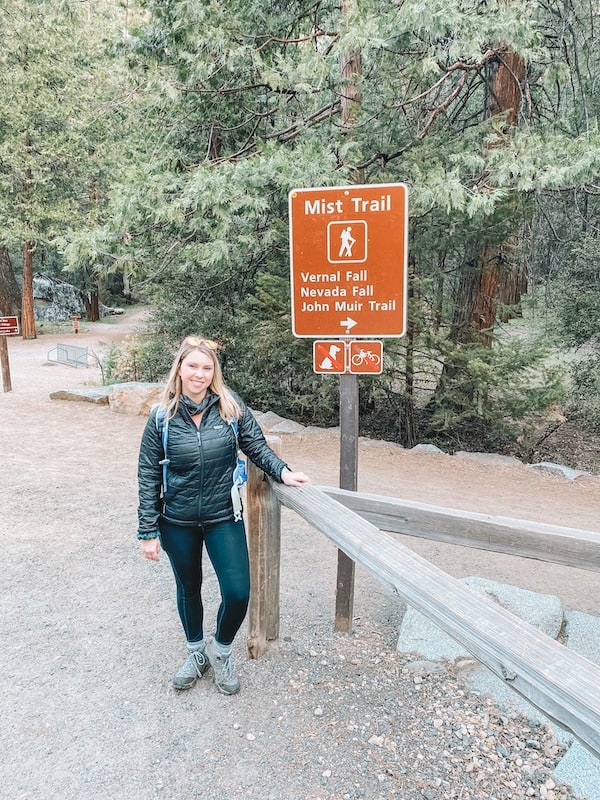
Take the Shuttle to Happy Isles
From Yosemite Village, walk to Shuttle Stops #1 (located on the east side of the day-use Parking Lot) or Shuttle Stop #2 (in front of the Village Store in Yosemite Village). Board the East Valley Shuttle to stop #16, Happy Isles.
If you are grabbing breakfast at Degnan’s or visiting the Visitor Center, you can also board the Valleywide Shuttle at Stops #4 (Degnan’s) or #5 (Visitor Center), which will take you to Happy Isles, but will take a little longer.
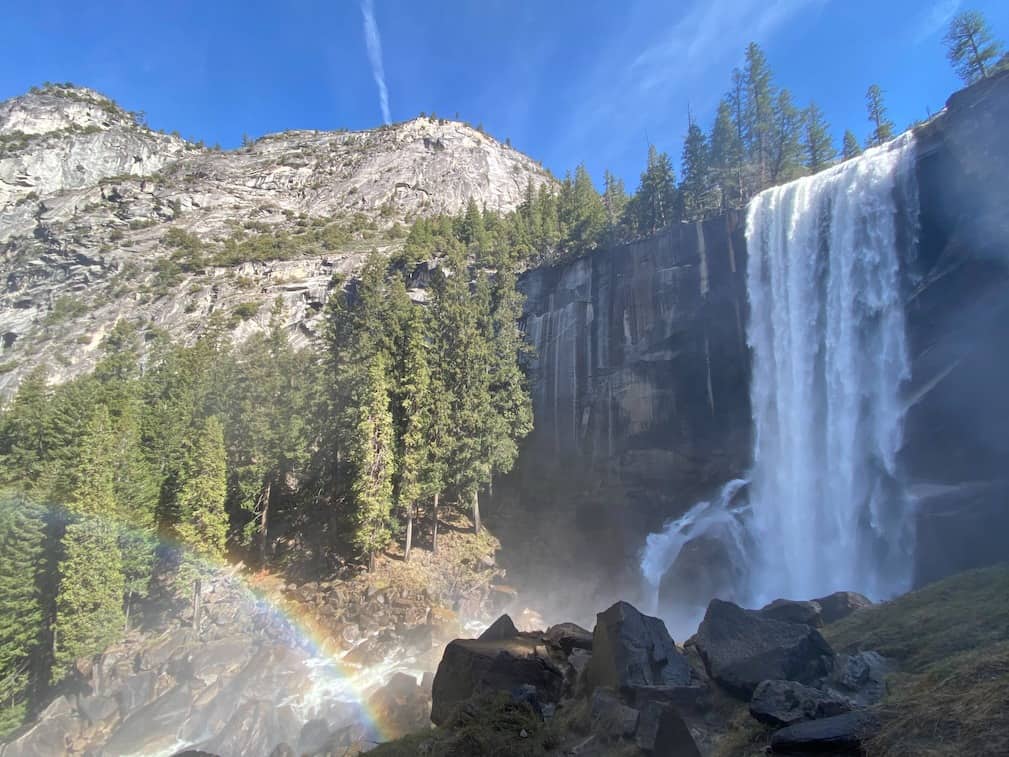
Hike the Mist Trail to Vernal or Nevada Falls
If there is one hike I absolutely insist you must do while visiting Yosemite, it is the “Mist Trail” to Vernal and Nevada Falls. This trail is one of my favorite day hikes of all time, and while it is strenuous, the reward is worth the effort !
Depending on your fitness level, and how much time you have, this trail has an option for everyone. Expect breathtaking views, a butt-blasting climb, giant waterfalls, and soaring granite cliffs.
From the trailhead, a steep but mostly paved trail climbs just under 1 mile to a wooden footbridge with views of Vernal Falls. From here you can snap photos and take a look at just how far you have to climb to the top.

Families with young kids and anyone who doesn’t want to commit to the longer hike can turn around here, but if you can, I absolutely suggest you keep going!
From the footbridge, the trail splits into the Mist Trail and the John Muir Trail. Follow the Mist Trail to Vernal Falls.
Along the way, you’ll climb more than 600 stone steps carved into the side of a spectacular waterfall. When water levels are high, you’ll definitely want a rain jacket! The “mist” trail gets its name from the constant spray off Vernal Falls soaking you on the trail.
Once you reach the top of Vernal Falls, take a snack break and catch your breath. Here you have the option of returning the way you came, or taking a worthy detour to Clark Point for spectacular views of distant Nevada Falls and the granite dome of Liberty Cap.
If you have the stamina, I suggest going all the way to Nevada Falls for unrivaled views and the feeling of being a total bad-a$% for climbing 2 massive waterfalls in one day! Return to the trailhead via the longer but more gentle John Muir Trail.
Mist Trail to Vernal and Nevada Falls ( 1-5 Hours)
Difficulty: Moderate to Strenuous
Depending on your fitness level, and how much time you have, there are several routes along the Mist Trail to Vernal Falls and Nevada Falls:
- Vernal Footbridge : 1.6 Miles round trip / 1 Hour / Moderate / Elevation gain 400’
- Vernal Falls Via Mist Trail : 2.4 Miles round trip / 3 Hours / Hard / Elevation gain 1,000’
- Vernal Falls via Mist Trail and Clark Point via John Muir Trail : 4.2 Miles round trip / 4 Hours / Hard / Elevation gain 1550’
- Vernal and Nevada Falls Via Mist Trail and Clark Point via John Muir Trail: 6.7 Miles round trip / 5-6 Hours / Strenuous / Elevation gain 1900′
Trail directions on All Trails . Check current conditions on NPS website, here .
Hiking the Mist Trail to Vernal and Nevada Falls is a serious adventure. Make sure you are prepared with the proper day hiking essentials , including sturdy waterproof hiking shoes, and rain gear.
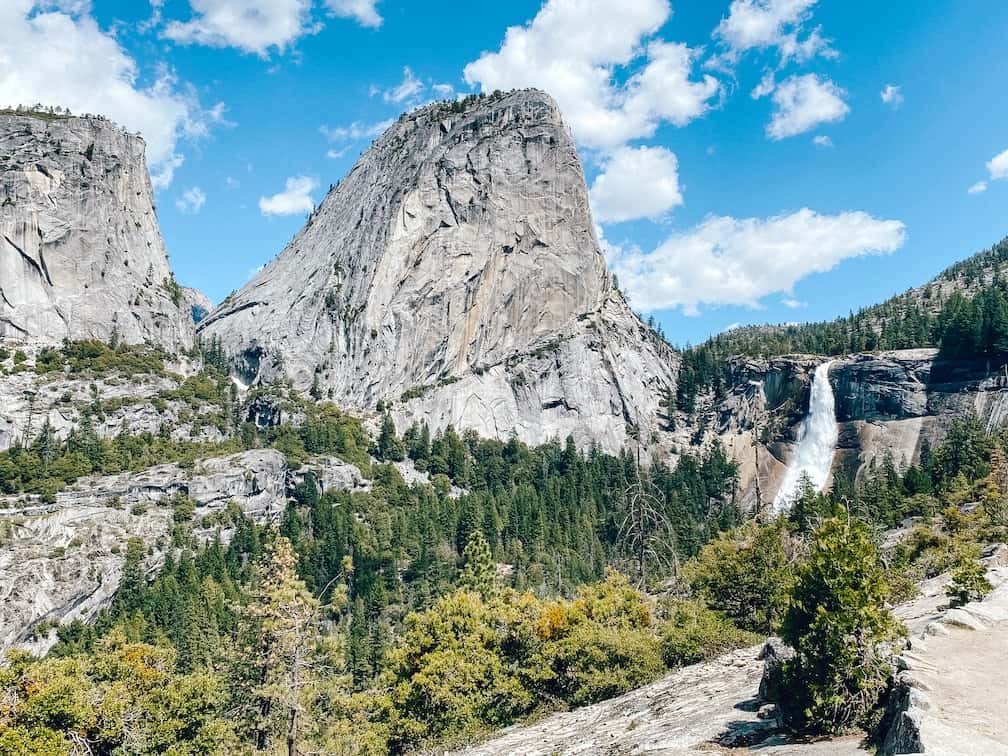
Lunch at Yosemite Village
Your legs are probably shaking thanks to the many, many stone stairs you just conquered. Enjoy sitting on the shuttle ride back to Yosemite Village.
Since you’ve probably worked up an appetite, grab quick snack or lunch in Yosemite Village at Degnan’s Deli (sandwiches, pizza, and other to-go options), The Loft at Degnan’s (pizza, BBQ and other casual lunch and dinner), or the Village Grill (summers only).

Once you are refreshed, it’s time for an easy walk to Yosemite Falls. At 2,425 feet, Yosemite Falls is the tallest waterfall in North America, and an iconic sight you can’t miss if you only have 1 day in Yosemite.
To access the Lower Yosemite Falls Trail, head west of the Yosemite Valley Visitor’s Center and follow signs for Yosemite Falls and the Lower Yosemite Falls trailhead. A fully paved and wheelchair-accessible path winds to the base of the falls.
Lower Yosemite Falls Trail
Difficulty: Easy / Wheelchair Accessible
1.2 Miles / Loop / 50 Feet Gain / 1 Hour
Trail directions on All Trails. NPS website information
The falls are actually 3 separate cascades, Upper Yosemite Falls (1,430 feet), the hidden middle cascades (625 feet), and Lower Yosemite Falls (320 feet).
The falls flow year-round, although they are little more than a trickle during late summer. During the peak spring snowmelt (May – June) an astounding 2,400 gallons PER SECOND flow over the top.

Drive to Glacier Point
It’s time to leave Yosemite Valley, but don’t worry, the views only get better from here! After visiting Yosemite Falls, return to your car and head west, out of the Valley on Northside Drive to Glacier Point Road.
On the way, stop at El Capitan Meadow. Here, you can admire “El Cap.” the 3,000′ tall granite monolith that dominates the West-end of the Valley. If you look carefully, you may be able to spot climbers high up on the wall.
Follow Northside Drive until the junction with Southside Drive and El Portal Road. Follow signs for Wawona / Fresno / Highway 41 and continue onto Wawona Road.
If you skipped the Tunnel View on the way into the Valley this morning, don’t forget to stop here now and enjoy the view made famous by photographers like Ansel Adams.
After approximately 16 miles, turn left, following signs for Glacier Point Road. Follow Glacier Point road as it winds and ascends into the high sierras.
Drive carefully and obey all traffic signs – this road is winding with very steep drop offs and few railings. The total drive to Glacier Point takes 1.5 Hours from Yosemite Valley.
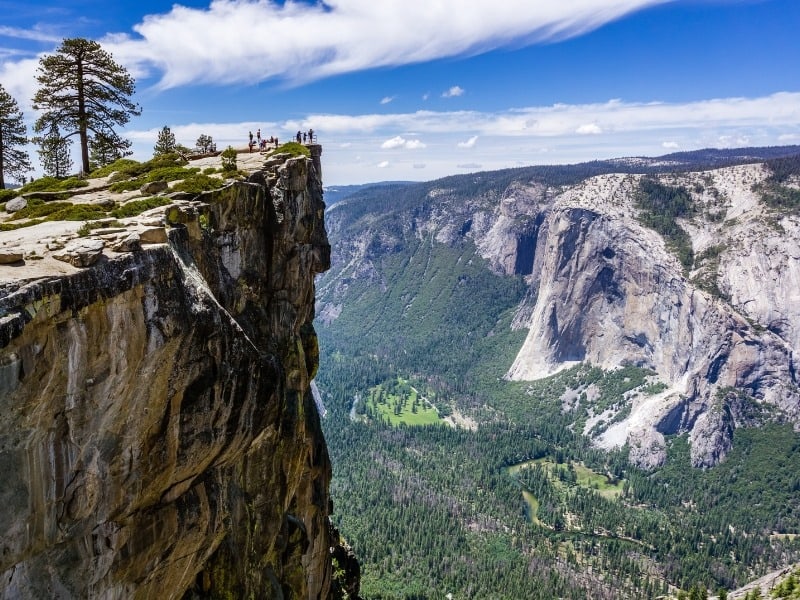
If you have time, consider hiking the short trail to Taft Point.
Taft Point is a large granite promontory with simply stunning views of Yosemite Valley and vertigo-inducing drops to the Valley Floor. “The Fissures” along the way are giant cracks in the granite that drop all the way down to the Valley Floor, nearly 2,000′ feet below.
Park in the small lot for Taft Point on the left hand side of the road. This area can get pretty crowded, especially around sunset, so you may need to park along the side of the road, where permitted.
Hike the short trail to Taft Point – just watch your step! 👀
Taft Point Trail
Difficulty: Easy
2.3 Miles / 360′ Elevation Gain / 1 Hour
Trail Directions on All Trails . NPS Website Information
Take care when hiking in this area, obey all signs, stay inside the railings, and closely watch children near exposed cliffs and fissures.
Past Taft Point, Glacier Point Road continues to wind higher and higher. Don’t miss pulling off for a few of these awesome viewpoints, like Washburn Point, where Glacier Point road makes a hairpin turn with views of Half Dome.
At the end of the road, you’ll arrive at the newly renovated Glacier Point parking area.
With breathtaking views of Yosemite Valley and the surrounding Sierra high country, its no wonder that Glacier Point is one of the most photographed spots in the entire Park.
While sunset here is crowded, there’s simply nothing better than watching the light glow off the granite cliffs and peaks. What a way to end a truly epic 1 day itinerary in Yosemite National Park!

Restrooms, and a small gift shop are available at Glacier Point. If you are staying in the Park tonight, return to your hotel or campground and grab some dinner (and a well-earned dessert).
Dinner is available at The Loft at Degnan’s , the cafeteria-style Basecamp Eatery at the Yosemite Lodge, the Mountain Room at the Yosemite Lodge, and the Curry Village Pavilion and Pizza Deck at Curry Village.
If you are able to splurge, consider making reservations for the grand Ahwahnee Dining Room (dress code) – one of the best dining experiences in any National Park! Learn more about dining options in Yosemite, here .
Planning a trip to Yosemite National Park? The Yosemite Itinerary Guide has your perfect 1, 2, or 3 day Yosemite trip completely planned for you! With over 20 pages of detailed hiking guides, printable daily itineraries, lodging and dining suggestions and more, you can spend less time planning and more time making epic memories! Check it out, here .
Where to Stay in Yosemite National Park
Unlike many National Parks, Yosemite has dozens of in-Park lodges, hotels, and 13 popular campgrounds, many open all year. But if you only have 2 days to spend in Yosemite, I strongly recommend staying inside Yosemite Valley.
Why? Yosemite is huge. But most places you’ll be visiting – Half Dome, Yosemite Falls, the Mist Trail, El Capitan, Cooks Meadow – are within a small area called Yosemite Valley. With traffic, you might waste hours of your Yosemite weekend driving from lodging outside the Park to the Valley.
Hotels and Lodges Inside Yosemite Valley :
- Yosemite Lodge – Family-friendly hotel, plenty of food and drink options, great location.
- Curry Village: “Glamping” style tent-cabins, some cabins and motel-style rooms, with great food and drink options, great location.
- Housekeeping Camp: Bare-bones “glamping” in the Valley
- The Ahwahanee Hotel : Widely considered the crown jewel hotel of the National Parks system. Presidents have stayed here. The Queen has stayed here. You will need to sell your firstborn to pay for a room. Not a Rockefeller? 100% come for a dinner reservation at the historic dining room (check the dress code), or grab a post-hike drink at their casual bar (my favorite!).
Hotels and Lodging Outside Yosemite Valley (But Still in the Park)
- Wawona Hotel : Victorian-era hotel near South Entrance, Glacier Point Road and Mariposa Grove.
- Redwoods in Yosemite , Yosemite West Rentals : Vacation rentals inside the National Park, near the Wawona Hotel. Great for large families, groups, and many are pet-friendly!
- High Sierra Camps : Backcountry high Sierra hike-in and horseback camps, coveted reservations are available via an annual lottery.
- White Wolf Lodge : Canvas tent-cabins and rustic cabins 30 Miles from Yosemite valley in a quiet corner of the Park.
- Tuolumne Meadows Lodge : Canvas tent-cabins and rustic cabins, great for exploring Tioga road and high-sierra.
- Glacier Point Ski Hut : Ski-in, Winter only backcountry hut.
Where to Stay outside Yosemite
Can’t get a reservation inside the Park? There are several towns with hundreds of hotel options within driving distance of Yosemite.
Check out these nearby lodging options, and set your alarm nice and early to avoid long lines at the entrance stations during peak visitor hours. Don’t forget! Yosemite now requires peak-hours reservations to enter if you are staying outside the park boundary. Learn more about these new changes, here.
Some of my favorite spots to stay outside the Park are:
- Evergreen Lodge at Yosemite (Groveland / Big Oak Flat Entrance): A lovely resort located about 1 hour from the Valley. This is a great spot if you’re coming from San Francisco, San Jose or other points west of the Park.
- Tenaya Lodge at Yosemite (South / Wawona Entrance): Built into the mountains just outside the Wawona entrance, the Tenaya Lodge is a family and pet-friendly luxury lodge with tons of amenities and less than 15 minutes from the park entrance (1 hour to the Valley).
- Best Western Plus Yosemite Gateway (Oakhurst / Wawona Entrance): A great mid-range chain hotel with classic “parkitecture” design located in the convenient town of Oakhurst, the closest mid-sized city to the park, where you’ll find grocery stores, restaurants, and lots of lodging options.
Want to compare rates? Check out this map for more suggested spots to stay near Yosemite National Park
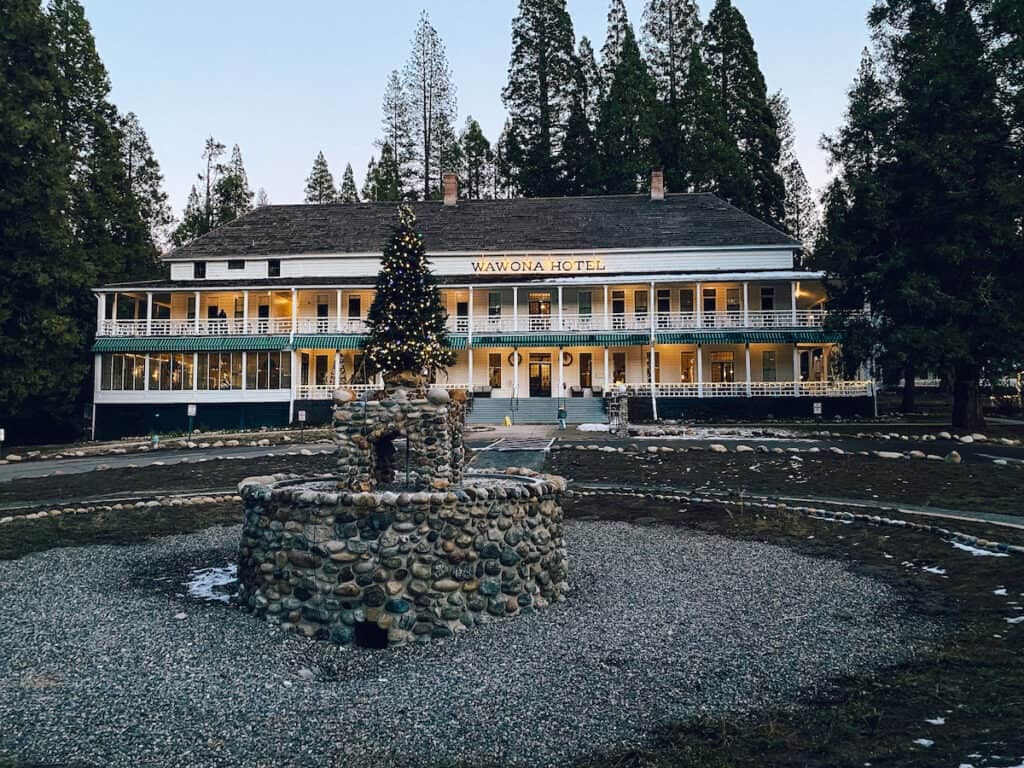
Camping in Yosemite National Park
Camping is immensely popular in Yosemite, with over a dozen front-country campgrounds, many open year-round.
Book your campground reservations as soon as possible. Yosemite campground reservations often sell out within seconds (yes, you read that right) of going online.
Reservations are all managed through Recreation.gov . Campground reservations become available 5 months in advance, on the 15th of each month at 7AM Pacific Time. Camp 4 offers one day in advance reservations by lottery, available on Recreation.Gov.
The following campgrounds are located inside Yosemite Valley: Upper Pines (Open All Year); Lower Pines (April-October); North Pines (April-October); Camp 4 (Open All Year).
The following campgrounds are located outside Yosemite Valley (but still inside Yosemite National Park): T amarack Flat Campground (Seasonal, Tioga Road Corridor); White Wolf Campground (Seasonal, Tioga Road Corridor); Yosemite Creek Campground (Seasonal, Tioga Road Corridor); Wawona Campground (Open All Year); Bridalveil Creek (Seasonal, closed 2022); Hodgdon Meadow (Open All Year, North Yosemite); Crane Flat (closed 2022, North Yosemite); Porcupine Flat (closed 2022); and Tuolumne Meadows (Seasonal, Closed Until 2024 -2025).
Learn more about Campgrounds and Campground reservations in Yosemite National Park, here .
Backcountry camping is also available to wilderness permit holders only. Learn more about these competitive wilderness permits, here .
More Things to Do in Yosemite National Park
This 1 day itinerary barely scratches the surface of Yosemite National Park. If you have more time, you can explore areas like the Mariposa Grove of Giant Sequoias or Tuolumne Meadows .
If you have more time to spend in Yosemite, check out my 3 day Yosemite Itinerary guide for more suggestions on how to plan an extended Yosemite itinerary.
More Yosemite Resources to Plan Your Next Trip
17 Amazing Easy & Short Hikes in Yosemite National Park
13 Iconic Yosemite Waterfalls & Waterfall Hikes in Yosemite National Park
Book Lodging In Yosemite National Park
Yosemite Reservations and Permits 2024: Everything You Need to Know
Best Entrance to Yosemite National Park & Tips for Driving to Yosemite
Closest Airports to Yosemite
Hiking the Mist Trail to Vernal and Nevada Falls in Yosemite
- 17 Amazing Easy & Short Hikes in Yosemite National Park
- 15 Best National Parks to Visit in Fall
- Closest Airports to Joshua Tree National Park & How to Get There
- Best Entrance to Yosemite National Park & Tips for Driving to Yosemite
Epic 3 Day Yosemite Itinerary: Ultima...

Epic Yosemite 2 Day Itinerary for Fir...
Welcome, Login to your account.
Recover your password.
A password will be e-mailed to you.
Yosemite in a Day: The Best One-Day Park Itinerary
If you've found yourself with limited time to explore the wonders of Yosemite National Park, there's a carefully crafted itinerary that allows you to make the most of your day.
Whether you're a first-time visitor or looking to maximize your experience, following this one-day plan will ensure you see the park's highlights without feeling rushed.
With a mix of iconic landmarks and lesser-known gems, this itinerary promises a well-rounded glimpse into the natural beauty of Yosemite.
But what exactly does this jam-packed day entail?
You'll want to discover the best way to navigate the park, uncover the must-see attractions, and learn how to optimize your time.
Best Time to Visit Yosemite in a Day
For the best experience visiting Yosemite in a day, plan your trip during late spring or early summer when the waterfalls are at their peak and the days are longer. This time of year offers the most spectacular views of the waterfalls as they gush with the snowmelt, creating a breathtaking sight.
The longer days also allow you to make the most of your visit, with more daylight hours to explore the park's beauty. While summer and holiday weekends draw large crowds, early fall is a great alternative, providing warm weather and fewer visitors.
Late fall and winter showcase a different kind of beauty, but road closures and dried-up waterfalls can limit your experience.
To make the most of your day trip, be sure to pack essentials such as breakfast and snacks, a reusable water bottle, sturdy shoes for hiking, sunscreen, a small first aid kit, sunglasses, a hat, a backup phone battery, and a camera to capture the stunning scenery.
Transportation Options for Yosemite Day Trip
When planning your Yosemite day trip, consider your vehicle rental options, public transportation routes, and the shuttle service availability within the park. This will help you determine the best mode of transportation for your visit.
Keep in mind the factors of convenience, cost, and flexibility as you make your transportation arrangements.
Vehicle Rental Options
Renting a car for your Yosemite day trip offers the convenience and flexibility to explore the park at your own pace. When considering vehicle rental options for your one day in Yosemite, keep in mind that all-wheel-drive isn't necessary. Use platforms like Expedia to find the best flight prices and rental car deals for your trip to Yosemite.
Here are some vehicle rental options to consider for your visit to Yosemite National Park:
- Standard Car : Opt for a standard car rental for a cost-effective and comfortable way to navigate the park.
- Compact Car : Consider a compact car for easy maneuvering on Yosemite's winding roads and limited parking spaces.
- Hybrid Car : Choose a hybrid car rental for an eco-friendly and fuel-efficient option to explore the park.
- SUV : If you prefer a larger vehicle, renting an SUV provides ample space for passengers and outdoor gear during your Yosemite adventure.
Public Transportation Routes
Consider utilizing the YARTS bus services for convenient public transportation options during your Yosemite day trip. YARTS provides affordable and comfortable transportation to Yosemite Valley and other areas within the National Park.
The bus service operates from gateway communities like Merced, Fresno, and Mammoth Lakes, allowing you to enjoy the scenic journey without the hassle of driving.
Once inside the park, take advantage of the free shuttle system, which offers easy access to popular spots such as trailheads, visitor centers, and iconic landmarks.
Planning your day to start early is essential, especially during peak seasons, as parking can be limited.
Shuttle Service Availability
To explore Yosemite National Park conveniently, take advantage of the park's shuttle service, providing easy access to popular areas without the hassle of driving. Here's why the shuttle service is the ideal choice for your one-day Yosemite trip:
- Free shuttle buses are available to Mariposa Grove, Tuolumne Meadows, and Glacier Point.
- Using the park shuttle allows for convenient access to key attractions without the stress of parking.
- Driving your own vehicle is an option, but parking can be challenging, especially during peak season.
- It's recommended to start your day early to secure parking, particularly from June to September.
Yosemite Valley Self-Guided Walking Tour
Exploring Yosemite Valley on a self-guided walking tour provides an immersive experience of the park's natural beauty and iconic landmarks. This 3-mile hike covers attractions such as Lower Yosemite Falls, Cooks Meadow, and Sentinel Bridge. The path is flat and paved, ideal for a leisurely stroll while taking in the breathtaking scenery.
Lower Yosemite Falls is best seen in late spring to early summer when the snowmelt swells the waterfall to its fullest. Cooks Meadow offers panoramic views of the valley and the iconic Half Dome. The self-guided walking tour allows you to set your own pace and immerse yourself in the tranquility of the valley, providing ample opportunities to capture stunning photographs and appreciate the diverse flora and fauna.
With its ease of access and the opportunity to witness some of Yosemite's most renowned landmarks, the self-guided walking tour of Yosemite Valley is a must-do for anyone looking to experience the park's natural wonders up close.
Notable Points of Interest in Yosemite
Immerse yourself in the grandeur of Yosemite by visiting its notable points of interest, each offering unique and awe-inspiring experiences.
- Tunnel View: This iconic viewpoint offers a breathtaking panoramic scene of Yosemite Valley, featuring prominent landmarks such as El Capitan, Half Dome, and Bridalveil Falls.
- Mariposa Grove: Take a trip to witness the awe-inspiring giant sequoias and embark on the Grizzly Giant Loop Trail for a picturesque hike amidst these towering natural wonders.
- Sentinel Dome: Hike to the top for a 360-degree vista of Yosemite Valley, El Capitan, Yosemite Falls, Half Dome, Clouds Rest, and the High Sierra peaks, providing an unparalleled perspective of the park's beauty.
- Glacier Point: Revel in stunning views of Half Dome, Yosemite's high country, and Yosemite Falls from this renowned vantage point, offering an unparalleled experience of the park's grandeur.
When planning your day trip to Yosemite, be sure to include these notable points of interest to make the most of your visit. Each location provides a unique and enriching experience, allowing you to truly appreciate the natural wonders of Yosemite Valley.
Essentials for Your Yosemite Day Trip
When planning for your day trip to Yosemite, there are a few things you should keep in mind. First, be sure to pack layers and a warm sleeping bag for the colder weather. This will ensure that you stay comfortable throughout your trip.
Next, you'll want to consider your transportation options. Look for affordable flights to San Francisco or Oakland airports, as these are the closest airports to Yosemite. Once you arrive, it's a good idea to rent a car for easy transportation around the park. This will give you the freedom to explore at your own pace and make the most of your time there.
Another important tip is to start your day early. Yosemite can get quite crowded, especially during peak times, so starting early will help you avoid the crowds and find parking. Be sure to pack breakfast, snacks, and a reusable water bottle to keep you fueled throughout the day. Lastly, don't forget to wear comfortable shoes and pack a daypack for all of your essentials.
Packing for Yosemite
When planning your day trip to Yosemite, it's essential to pack warm clothing in layers, including a warm sleeping bag for colder weather. Here's a checklist to ensure you have everything you need for your Yosemite itinerary:
- Pack warm clothing in layers and a warm sleeping bag for colder weather.
- Bring a reusable water bottle and snacks in your daypack for convenience.
- Wear sturdy, comfortable shoes suitable for walking and exploring.
- Essentials to bring include sunscreen, a small first aid kit, sunglasses, a hat, backup phone battery, and a camera.
Be sure to check the weather forecast and be prepared to layer. Consider bringing a lightweight rain jacket to stay dry and comfortable during your Yosemite adventure.
Day Trip Logistics
Ensure that you pack all essential items for your day trip to Yosemite, including warm clothing, a reusable water bottle, and sturdy shoes.
When planning your day trip logistics, consider the best time to visit Yosemite National Park to avoid heavy visitor traffic. Research transportation options and parking to streamline your journey to and around Yosemite.
Follow a suggested itinerary for a one-day trip, ensuring you visit key attractions and partake in recommended activities.
Once at Yosemite, explore the valley attractions and familiarize yourself with available amenities, such as lodging, dining, and visitor centers.
Additionally, understand accommodation options and essential tips for a Yosemite day trip, such as camping choices, reservation procedures, and important considerations for a smooth visit.
Overnight Accommodation Options
For overnight stays in Yosemite, various accommodation options are available, including cabins, canvas tents, tent camping, and RV camping, providing diverse choices for visitors.
- Yosemite Valley Lodge: This iconic hotel offers comfortable rooms and is conveniently located near Yosemite Falls and the trailhead to the Mist Trail and Half Dome.
- Curry Village: This option provides a mix of accommodations including canvas tent cabins, wooden cabins with private bathrooms, and standard hotel rooms, catering to different preferences.
- Upper Pines Campground: Ideal for those seeking a more traditional camping experience, this campground in Yosemite Valley offers tent and RV camping options, providing a closer connection to nature.
- Airbnb Properties: In addition to the accommodations within the park, Airbnb properties are available in Yosemite National Park and nearby towns, with the best selection in towns like El Portal or Groveland, offering a wide range of choices for lodging.
When planning your overnight stay in Yosemite, consider booking accommodations at least 3 months in advance, especially if you plan to stay at a hotel like Yosemite Valley Lodge or Curry Village, due to the competitive reservation processes. This ensures you secure the best option for your visit.
Tips for Making the Most of Your Day
Consider the following tips to maximize your day in Yosemite, making the most of your time after a restful overnight stay in the park.
Following these tips will help you make the most of your one day in Yosemite. Starting early will allow you to avoid crowds, find parking, and make the most of your time. Dressing in layers will ensure you are prepared for any weather conditions you may encounter throughout the day. Whether you choose to use the park shuttle or your own vehicle, planning your transportation method ahead of time will save you time and stress. Lastly, planning your visit during the optimal times will ensure you get to experience Yosemite's natural beauty at its best. By following these tips, you can enhance your Yosemite itinerary and create lasting memories in just one day.
Yosemite Day Trip FAQs
Wondering about the logistics of visiting Yosemite in a day?
Let's start by addressing some common questions about trip duration and park access. Understanding these key points will help you plan a smooth and enjoyable day trip to Yosemite.
Trip Duration
To make the most of your day trip to Yosemite National Park, plan to visit during mid-spring to mid-fall for the best experience. Yosemite Valley is easily accessible from major cities, making it feasible for a one-day itinerary. Utilize park shuttles or your own vehicle to get around, but be mindful of parking challenges during peak season. Consider staying in nearby towns like El Portal or Groveland, with accommodation reservations opening on a rolling 5-month basis. Additionally, be aware of the park entrance fees, including options for private vehicle fees, walking or biking fees, and the America the Beautiful Pass.
- Visit Yosemite during mid-spring to mid-fall for the best experience.
- Yosemite Valley is accessible from major cities for a one-day itinerary.
- Utilize park shuttles or your own vehicle for transportation.
- Consider staying in nearby towns and be aware of park entrance fees.
Park Access
If you're planning a day trip to Yosemite National Park, gaining park access and navigating the available options for transportation is essential.
Yosemite Valley is around 4 hours from San Francisco and 6 hours from Los Angeles, making it feasible for a one-day Yosemite adventure.
Look for cheap flights to San Francisco (SFO) or Oakland (OAK) airports if you're flying in. Once you're there, you can get around using the park shuttle or your own vehicle.
It's crucial to start your day early, especially during peak season (June to September), to secure parking.
Consider using Expedia to find the best flight prices and rental car deals, which can make your one day Yosemite trip more convenient and enjoyable.
Planning Your Yosemite Day Trip
Arriving early and securing parking is crucial for planning your Yosemite day trip, especially during the peak season to avoid crowds. To ensure a smooth and enjoyable visit, consider the following tips:
- Choose the Right Time: Select mid-spring to mid-fall for the best weather and access to the park's amenities and attractions.
- Transportation Options: Utilize the park shuttle for convenient access to various areas, or consider driving for more flexibility in exploring different parts of Yosemite National Park.
- Pack Wisely: Dress in layers to prepare for varying temperatures throughout the day, and don't forget to bring essentials such as a reusable water bottle and sunscreen to stay hydrated and protected from the sun.
- Resource for Planning: Consider using the Best of Yosemite guidebook by Moon Guides for comprehensive trip planning and itinerary suggestions to make the most of your visit.
Scenic Highlights and Activities
Discover stunning views and a variety of outdoor activities, including hiking, biking, and photography, at Tunnel View, Sentinel Bridge, and Glacier Point in Yosemite National Park.
At Tunnel View, marvel at the iconic panoramic vistas of Yosemite Valley, including El Capitan and Bridalveil Fall.
Sentinel Bridge offers the perfect vantage point for capturing the breathtaking reflections of Half Dome and Yosemite Falls in the Merced River.
Make sure to visit Glacier Point for an unparalleled panoramic overlook of Yosemite Valley, Half Dome, and the high country.
Additionally, consider taking a guided Valley Floor Tour led by park rangers to gain insightful knowledge about the park's history and geology while enjoying the scenic beauty.
For an awe-inspiring experience, explore the ancient sequoias at Mariposa Grove, where you can encounter the renowned Grizzly Giant Tree.
Don't miss the opportunity to capture memorable photos and immerse yourself in the tranquility and grandeur of this natural wonder.
When planning your trip, aim for late spring to witness the peak waterfalls, or early fall for pleasant weather and fewer crowds.
Be mindful of potential road closures during late fall and winter.
Frequently Asked Questions Can You Do Yosemite in 1 Day?
Yes, you can do Yosemite in one day. Start early to avoid crowds and visit highlights like Lower Yosemite Falls and Sentinel Bridge. Consider renting a car or using park shuttles for getting around.
What Is the Best Route Through Yosemite National Park?
For the best route through Yosemite National Park, take the Tioga Pass entrance for stunning views. Aim to arrive early to secure parking and use the park shuttle for convenience. Visit a Sequoia Grove and Tunnel View, then explore by foot.
How Can I See Yosemite in One Day by Car?
To see Yosemite in one day by car, start early to secure parking. Take a self-guided walking tour of Yosemite Valley, use the free shuttle to access popular areas, and dress in layers for changing weather.
What Is the Best Way to See Yosemite National Park?
To see Yosemite National Park in a day, start early and prioritize the must-see attractions like Lower Yosemite Falls, Cooks Meadow, and Sentinel Bridge. Rent a car for easy access and flexibility in exploring.
So, whether you're marveling at the towering cliffs of El Capitan or feeling the mist from Lower Yosemite Falls, there's no shortage of awe-inspiring moments in Yosemite.
With careful planning and the right itinerary, you can make the most of your day trip and create memories that will last a lifetime.
Yosemite in a day is like a whirlwind romance – intense, breathtaking, and unforgettable.
Don't miss your chance to experience its beauty for yourself.
Farrukh Khurshid, Editor and Founder of Exploring Leisure is a seasoned traveler and writer with a passion for exploring the world's many wonders. With a keen eye for the beauty and diversity of different cultures, Farrukh brings a wealth of experience to the Exploring Leisure blog. His love for journeying to new destinations is matched only by his eagerness to share insights and stories with fellow travel enthusiasts. Whether it's the bustling streets of a city or the serene landscapes of the countryside, Farrukh's vivid descriptions and practical tips inspire readers to embark on their own adventures. Join him on Exploring Leisure as he continues to traverse the globe, one incredible place at a time.
Savannah to Charleston: Crafting the Perfect Road Trip
Roger's Gardens: A Bewitching Halloween Boutique Visit
Your email address will not be published.
Save my name, email, and website in this browser for the next time I comment.

1-3 Days Yosemite National Park Itineraries: How To Plan A First Visit
by Mark and Kristen Morgan
Published: July 29, 2020
Updated: August 27, 2024
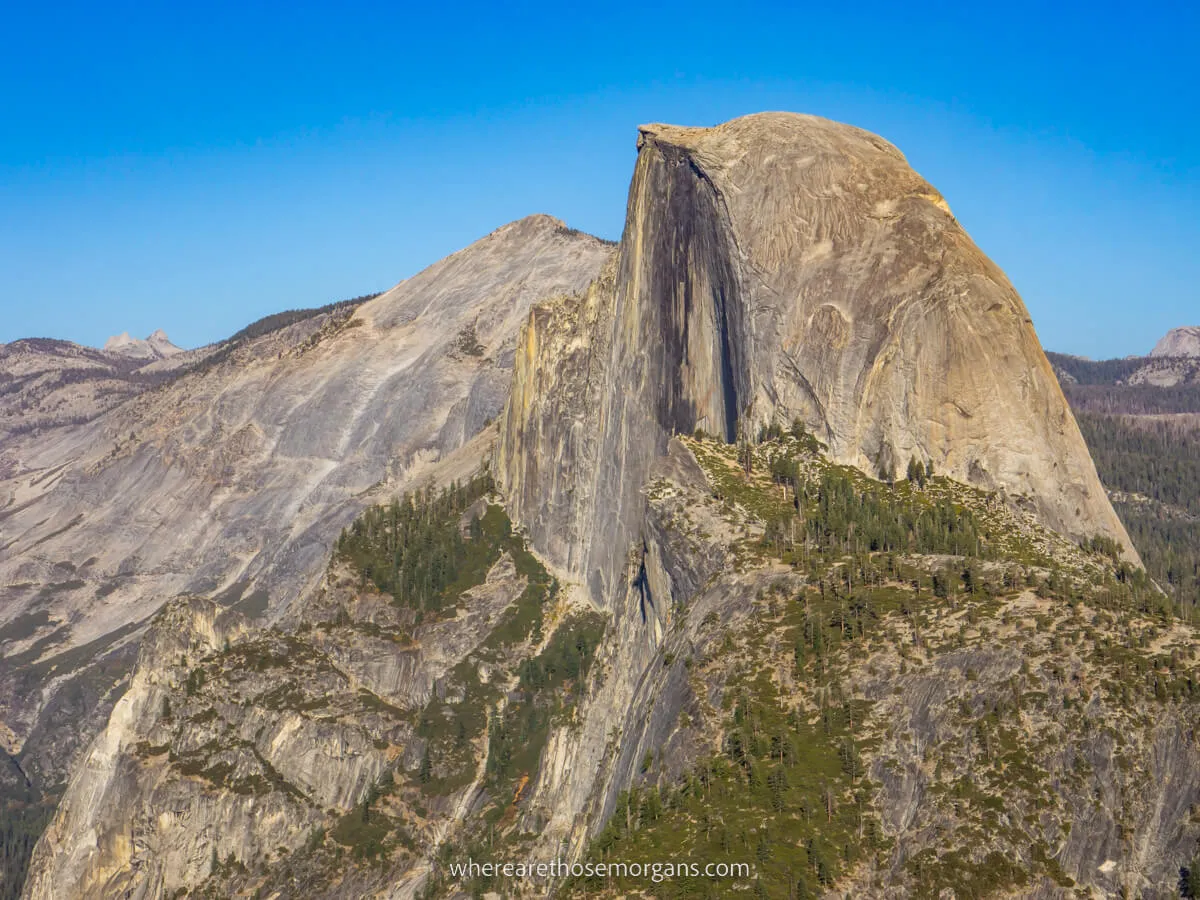
Yosemite is a treasure trove of natural beauty. We were blown away by spellbinding landscapes, smooth granite domes and majestic valley views during our 3 day Yosemite trip, and we think it has to be considered one of the crown jewels in America’s national park network. Just like the great writers and photographers who immortalized Yosemite before our time, we know you’ll be swept off your feet by the stunning waterfalls, monoliths, sequoia groves and hiking trails on display. In this guide we explain everything you need to know about planning the perfect Yosemite itinerary for a first visit, including the park’s regions and entrances, what you can’t miss, and itineraries for one, two and three days.
Our Experience
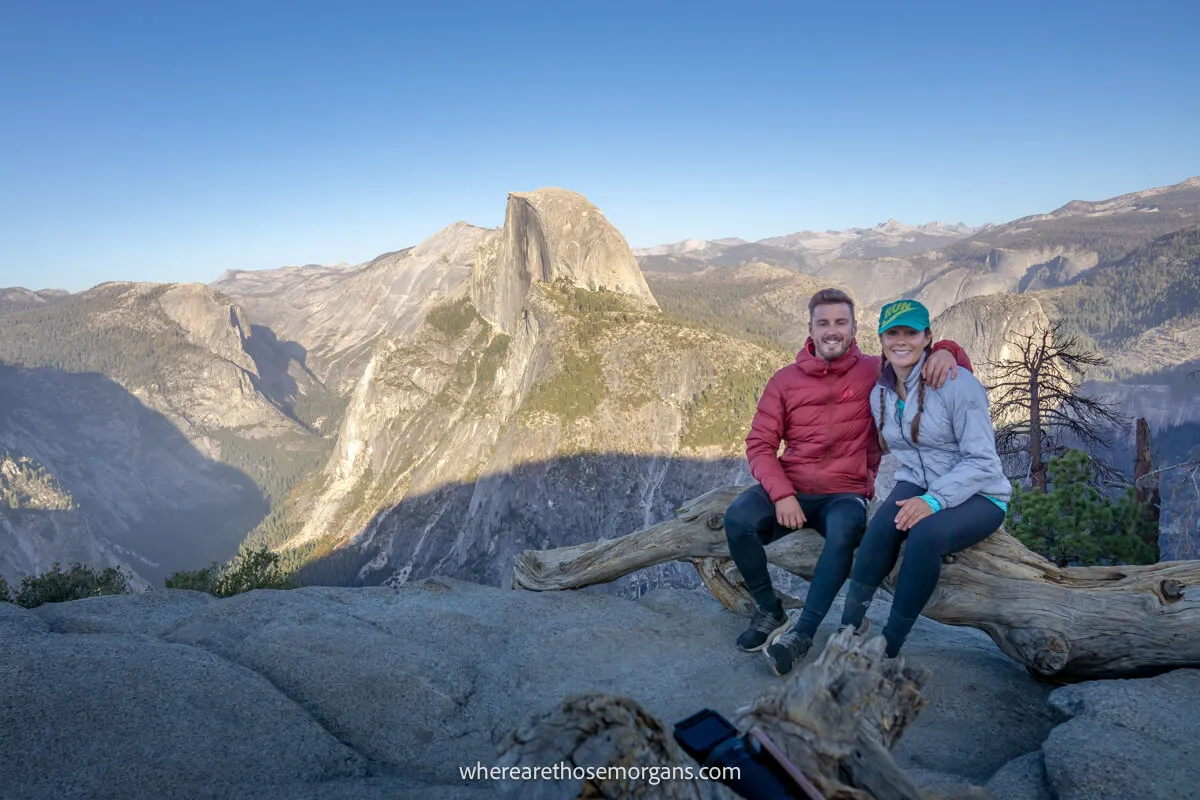
We spent 3 unforgettable days exploring the main regions of Yosemite during our first 3 month US road trip. We’re hikers and photographers, so a place as adventurous and picturesque as Yosemite was inevitably going to become a favorite of ours. We didn’t win a Half Dome permit, but we hiked Mist Trail instead and it was still awesome. Plus, we were out with our camera for sunrises and sunsets to capture Yosemite’s unbelievable beauty during the golden hours.
We entered through the northeast and spent a day on Tioga Pass Road, then we spent a full day in Yosemite Valley, before finishing with half a day in the valley and half a day on Glacier Point Road before leaving through the south. It was an action packed 3 days and we were exhausted when we left, but we’re glad we filled up our Yosemite itinerary with activities because it’s a magical place. Read more about us .
READ : Our favorite US national parks
Park Information
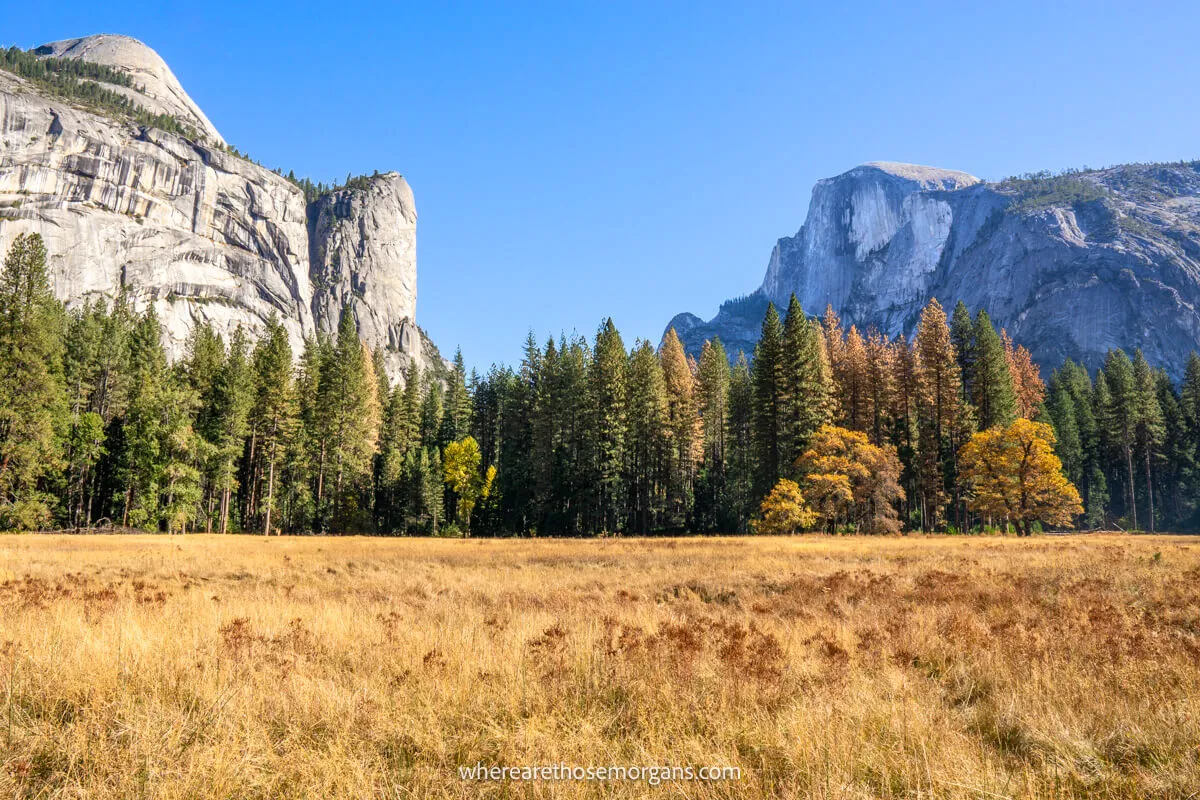
- Website : nps.gov/yose
- Hours : All day, every day
- Fees : $35/vehicle
- Permit : Required April-October
- Backcountry camping : Allowed with permit
- Accommodation : Hotels, lodges, cabins, campgrounds
- Annual visitors : 4 million
- Peak season : May-October
- Size : 759,620 acres
Yosemite is open year round but around 75% of the park’s 4 million annual visitors plan trips for the peak months between May and October. Entry to Yosemite costs $35 for a 7-day pass, which covers your vehicle and all passengers. Alternatively, you can gain free entry with an America the Beautiful Pass . You also must obtain a permit to enter Yosemite on certain dates between April and October.
What we love the most about Yosemite is that it has something for every type of visitor. It doesn’t matter if you’re a hiker, photographer, couple or family, you’re going to be wowed by what’s on offer for lovers of the great outdoors. El Capitan and Half Dome were even more impressive than we’d expected, and even just driving around Yosemite Valley made it worth the effort.
How Many Days Do You Need In Yosemite?
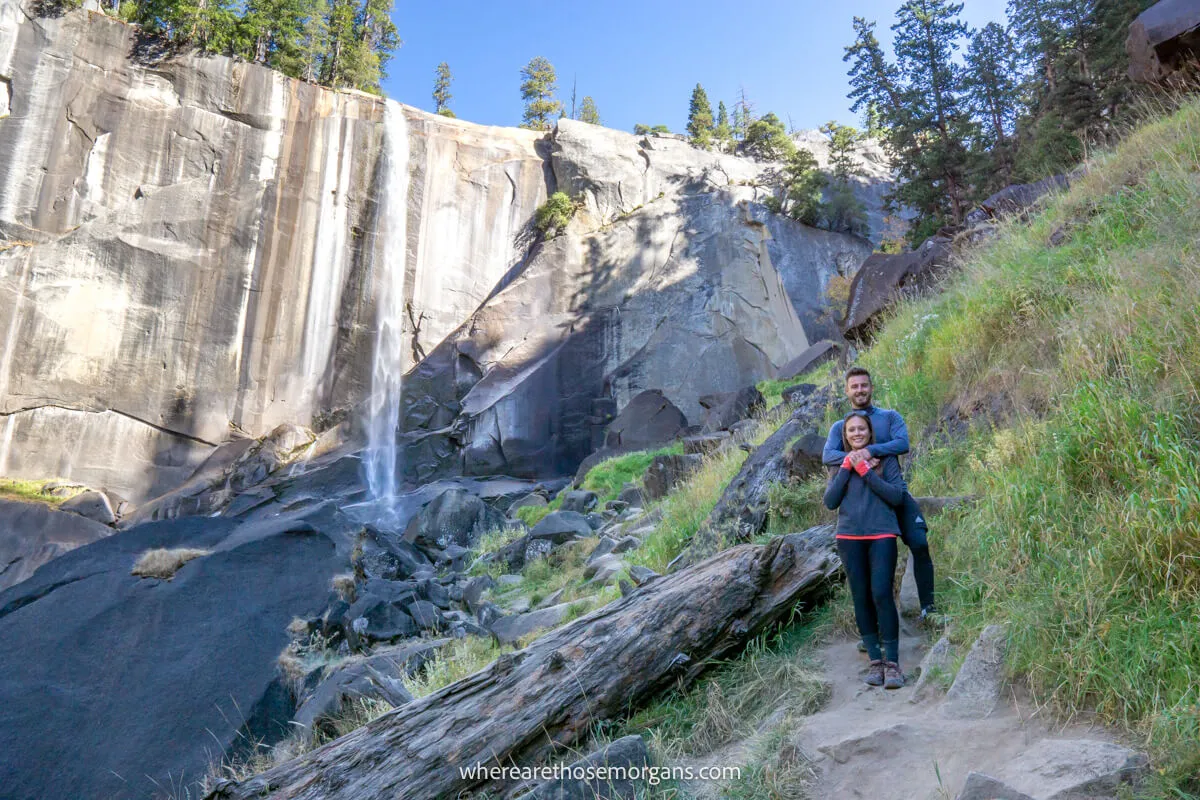
The first thing you need to decide is how many days you’ll spend in Yosemite. It might depend on factors like how many days you have off work, your travel budget or accommodation availability. But to answer the question, we think 3 days is the perfect amount of time for a first visit to Yosemite National Park, and that’s based on our own 3 day trip to the park.
Here’s the way we see it:
1 Day – You might be surprised by how much you can do with just one full day in Yosemite. We recommend either spending the day driving Yosemite Valley and Glacier Point Road so you can see more of the park, or choosing a few hikes in the valley. There’s a lot you’d miss but one day is better than no days!
2 Days – You can quite easily see Yosemite’s highlights in two days if you normally explore quickly or if you don’t plan to hike very much. We recommend focusing on the valley but also spending half a day in the south and half a day in the north. You’d see most of the park and keep costs to a minimum.
3 Days – We think three days in Yosemite offers the best balance between costs, how much you can see and going at a reasonable pace. It gives you time to hike some trails and see each of the park’s main regions, without costing too much or taking up too much time. When we go back for another visit, we’ll be planning a 3 day Yosemite itinerary.
4 Days – You can absolutely stay for an extra day if you prefer to travel slowly. You’d be able to explore at a much calmer pace, add in extra hikes or photo spots, and enjoy the landscapes for another 24 hours. But it’ll be getting very expensive by this point, it’s another day off work and unless you’re a big hiker we don’t think there’ll be enough to keep you entertained.
Regions Of The Park
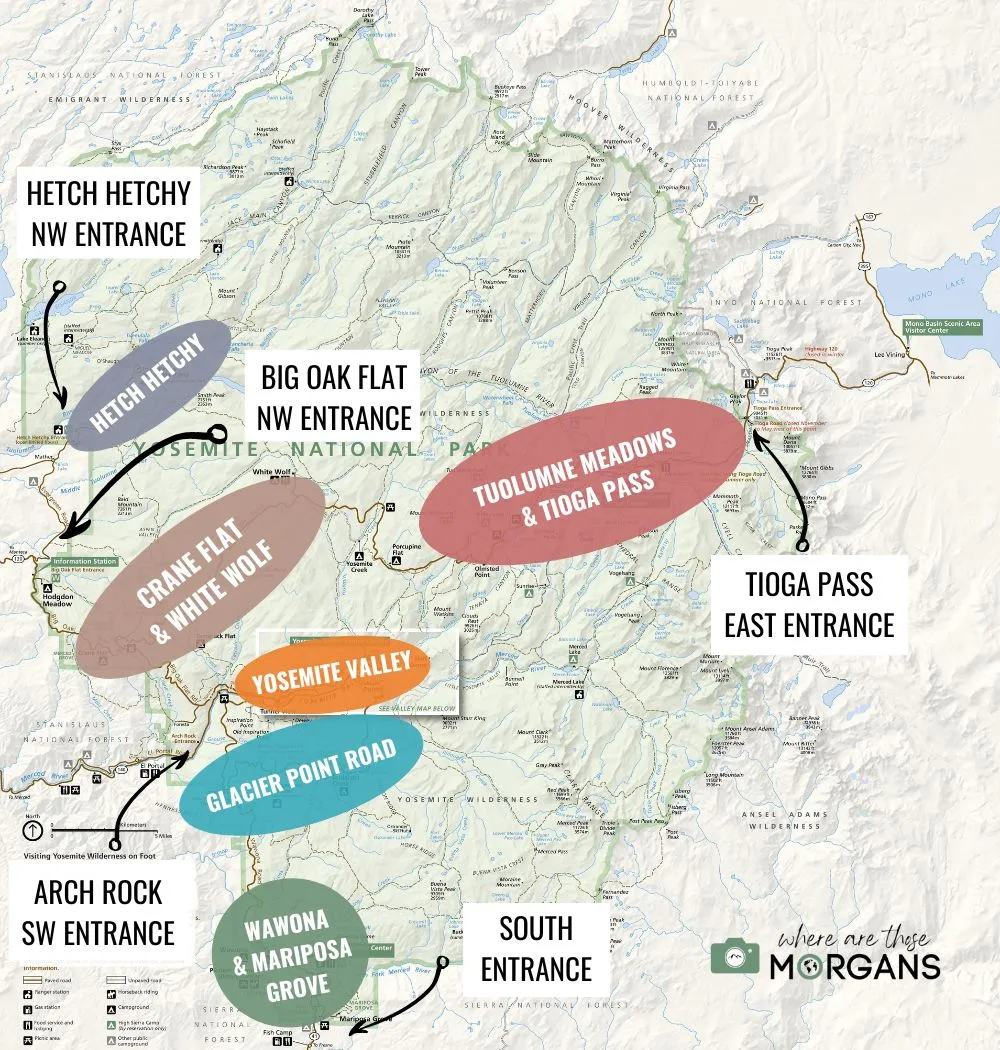
We don’t think Yosemite is the hardest US national park we’ve planned (that title goes to Yellowstone ), but it’s certainly not the easiest either. Yosemite has 6 regions and 5 entrances, so you need to think carefully about what you want to see and which entrances you’ll use on the way in and out.
Here are Yosemite’s 6 regions (as you can see in our map above):
- Yosemite Valley
- Glacier Point Road
- Crane Flat and White Wolf
- Wawona and Mariposa Grove
- Tuolumne Meadows and Tioga Road
- Hetch Hetchy
If you’re planning a first time Yosemite itinerary, we highly recommend you prioritize Yosemite Valley and Glacier Point Road. Next, add in either Crane Flat and Mariposa Grove, followed by Tuolumne Meadows and lastly Hetch Hetchy. We didn’t visit Hetch Hetchy, and we only recommend it for return visitors because it’s a long way out and it doesn’t have the same striking beauty as the main regions.
The reason we suggest planning a 3 days in Yosemite itinerary for your first visit is because it gives you enough time to easily visit Yosemite Valley, Glacier Point, Crane Flat, Mariposa Grove and Tuolumne Meadows at a reasonable pace. It might sound overwhelming, but it’s actually a lot easier than it seems.
Need help planning your trip to Yosemite?
Our popular Yosemite travel guidebook helps you with planning every aspect of your visit, including what to see, the best hikes, where to eat and stay, itinerary ideas and map!
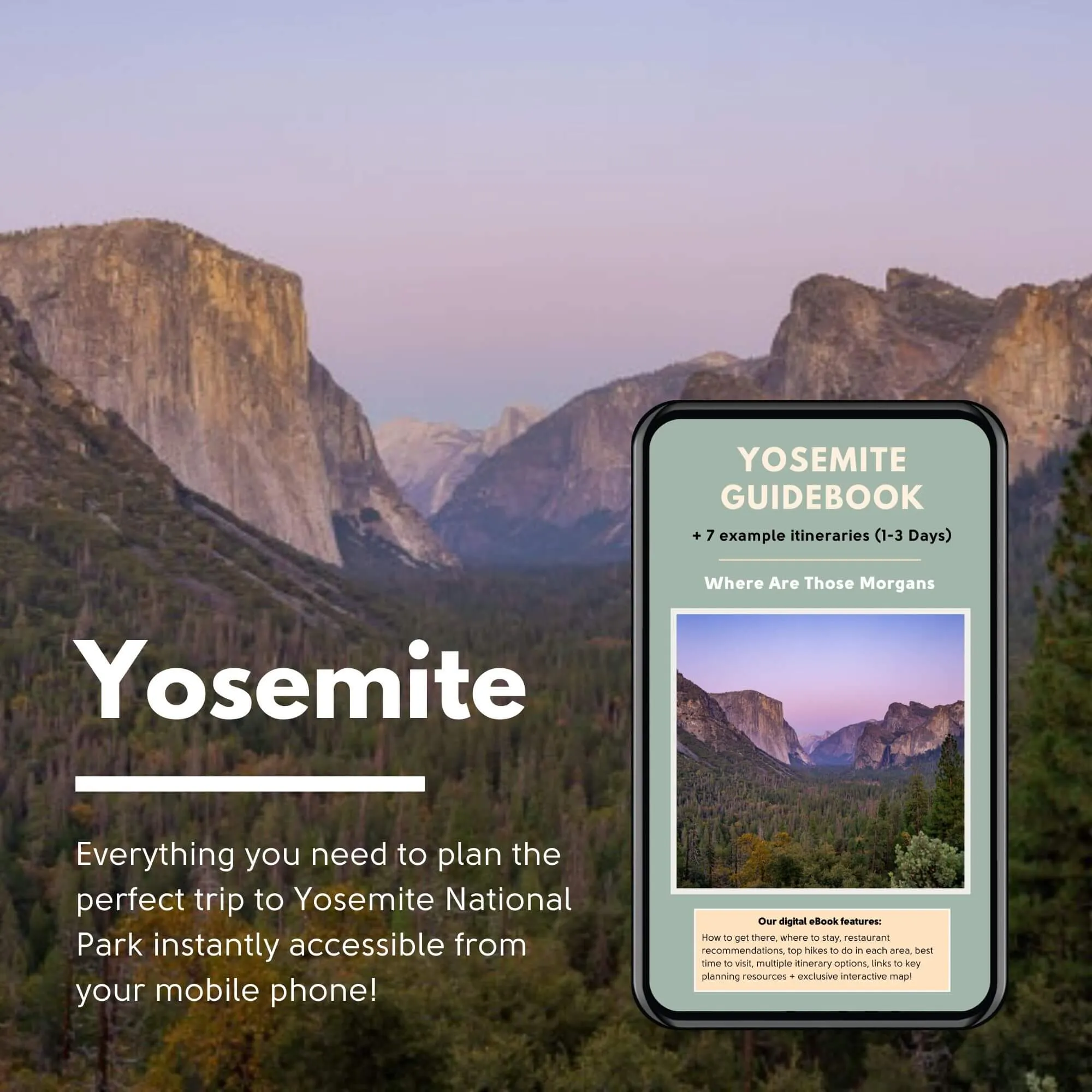
Yosemite National Park has 5 entrances:
- Tioga Pass (East) – Lake Tahoe, Death Valley
- Oakhurst (South) – Los Angeles, Sequoia
- Arch Rock (Southwest) – Mariposa, San Jose
- Big Oak Flat (Northwest) – Oakland, San Francisco
- Hetch Hetchy – Separate entrance to secluded area
We planned the most efficient 3 days Yosemite itinerary possible by entering the park through Tioga Pass and leaving through Oakhurst. This allowed us to see Tioga Pass, Crane Flat, Yosemite Valley, Glacier Point and Mariposa Grove in that order from north to south without having to drive back on ourselves at any point. But that’s only because we were already on a wider US road trip. We’d previously been in Death Valley and our next stop was San Francisco , so it worked perfectly.
It isn’t the end of the world if you don’t do it the absolute most efficient way because Yosemite isn’t enormous. We know most people are going to fly into and out from one of the major airports west of Yosemite, so your best bet is to use Big Oak Flat on the way in and Arch Rock or Oakhurst on the way out of the park. Tioga Pass Road is the only region of the park you’d have to drive back on yourself, if you decided to visit at all.
Travel Tip : The closest airports to Yosemite include Fresno, Reno, Oakland, Sacramento, San Jose and San Francisco.
Things You Can’t Miss
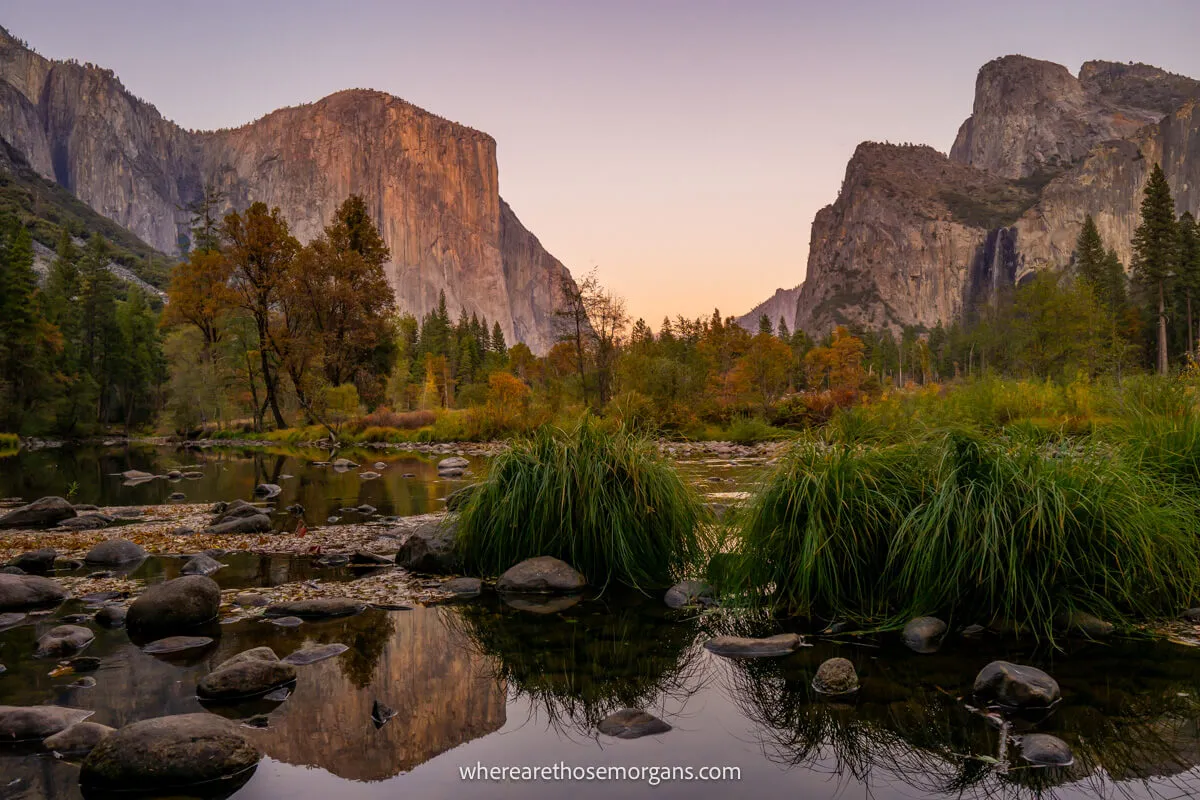
There are so many fun things you can do in Yosemite, including hiking, photography, rock climbing, rafting, biking and sightseeing. But there are some things you absolutely shouldn’t miss when you visit. Here’s what we recommend:
Sightseeing:
- Bridalveil Falls
- Lower Yosemite Falls
- Mariposa Grove
- Tuolumne Grove
- Tuolumne Meadows
- Tunnel View
- Valley View
- Glacier Point
- Olmsted Point
- Mist Trail (John Muir Loop)
- Four Mile Trail
- Yosemite Valley Loop
- Upper Yosemite Falls
As far as we’re concerned, they are the unmissable things to do any first time Yosemite itinerary. Make sure you take a good look around our Yosemite map at the end of this guide to see where these places (and more) are located.
Next, we’re going to walk you through itinerary examples for how to spend one day, two days and three days in Yosemite, incorporating many of these great views and hikes. Our itinerary examples are based on how we would plan our days. Note that none of the itineraries include hiking Half Dome. If you win a permit and hike Half Dome, it will take up a full day.
READ : Unmissable photo spots in Yosemite
One Day Yosemite Itinerary
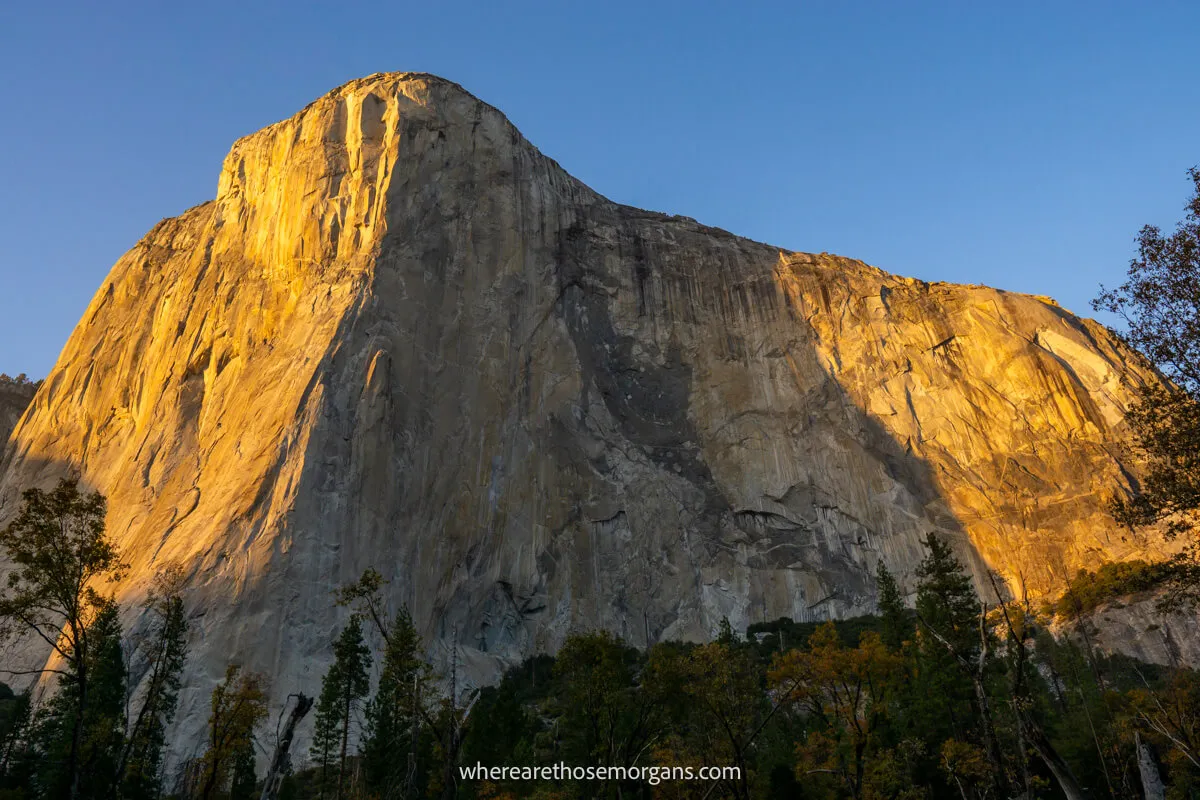
With just one day you’ll need to be quick and get straight to the point. It doesn’t matter which entrance you use, drive straight to Yosemite Valley and start with stunning morning views from Tunnel View. If you can make it there for sunrise you’re in for a real treat. Next, park at the nearby Bridalveil Falls Trailhead and hike the short trail to see the waterfall from below.
Drive the one-way Yosemite Valley Loop and take the first left to see El Capitan from a gorgeous meadow. If you’re early enough you might see its famous walls lit up beautifully by the sun. Stop next at Cathedral Beach or Sentinel Beach to see trees and granite monoliths reflecting in the Merced River, then park at the main visitor center to take a look around.
Hike Mist Trail to Vernal Falls or Nevada Fall depending on your hiking ability and time available. No matter how much of the trail you hike, stop at Lower Yosemite Falls next to see the tallest waterfall in North America. If you have time, stop at El Capitan and walk to its base so you can appreciate the scale of the climb. On the way out of the valley, make sure you stop at Valley View for a stunning vista. Finally, drive all the way up to Glacier Point to see sunset over Half Dome.
Note : Watch your time and maybe cut out the Mist Trail hike if you’d prefer to take things a bit slower. You’ll also have to drive out of Yosemite in the dark if you stay up at Glacier Point for sunset.
2 Days Yosemite Itinerary
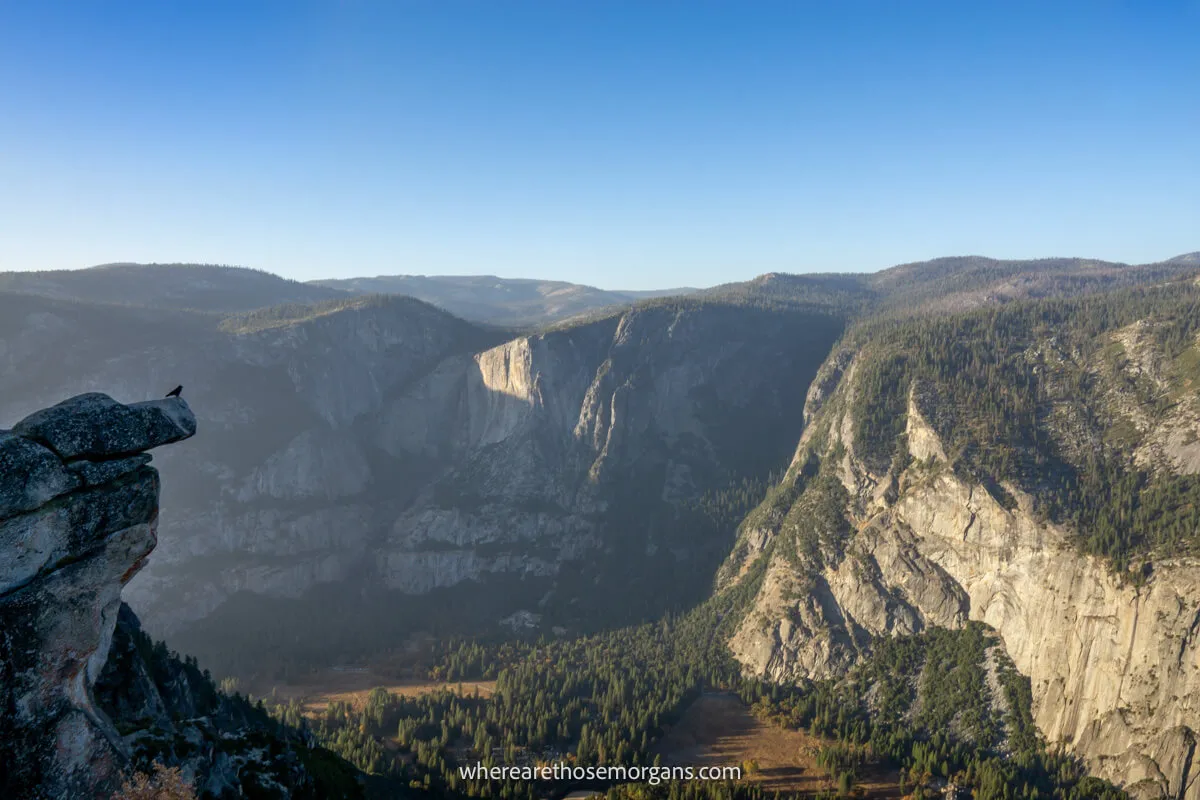
Start at Tuolumne Grove to see Giant Sequioas, then drive down into Yosemite Valley and stop at Bridalveil Falls. Next, stop at El Capitan Meadow and each of the pullovers along the loop road until you reach Mist Trailhead. Hike up to Vernal and Nevada Falls, then loop back around on John Muir Trail.
Stop next at Cook’s Meadow Loop. We took some great photos here so don’t miss it. Walk over to see Lower Yosemite Falls, then walk to the base of El Capitan. When it’s getting later in the afternoon, stop at Valley View and then head up to Tunnel View for sunset.
Get an early start and hike to Upper Yosemite Falls or go even further to El Capitan summit if you’re a very strong hiker. It’ll be amazing in the spring and early summer when water volumes are higher. This would take up your whole morning and not everyone will want to do this, so the alternative is to spend the morning walking around the visitor center, Ansel Adams gallery (we bought an astrophotography book here) and spend more time enjoying the beauty of Yosemite Valley.
Drive through Wawona Tunnel (stop at Tunnel View again) and head all the way up to Glacier Point to enjoy spectacular views over Half Dome. Stop at Taft Point for amazing views if you have time, then drive south and hike the Grizzly Giant Loop in Mariposa Grove to see Giant Sequoias.
3 Days Yosemite Itinerary
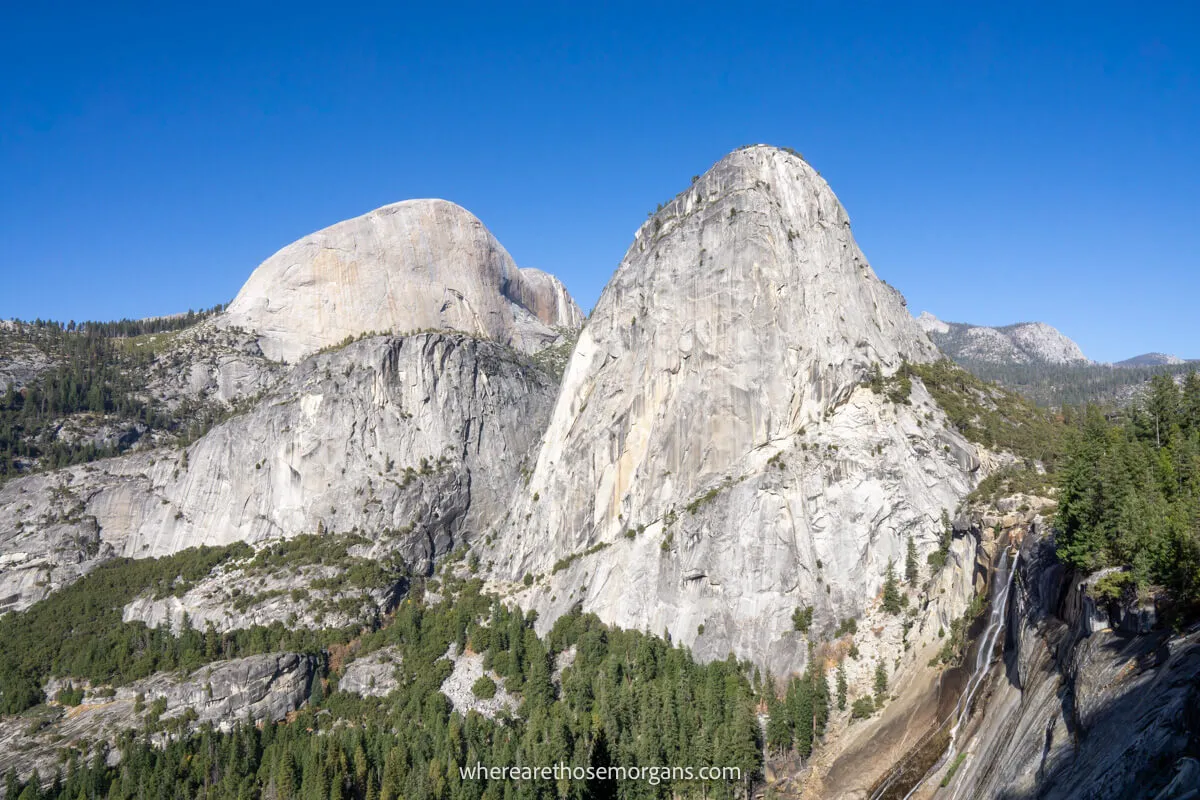
Start on Tioga Pass with a hike to Cathedral Lakes or a hike to Dog Lake and Lembert Dome. We had Lembert Dome to ourselves and it was awesome! Stop to see Tenaya Lake and Olmsted Point to see Half Dome. Next up is Tuolumne Grove to walk around Giant Sequoias, then drive down into the valley and walk to the base of Bridalveil Falls.
Stop at El Capitan Meadow, Cathedral Beach and Sentinel Beach, then hike Four Mile Trail to Glacier Point. This would take up the rest of your day and you’d need to be a strong hiker, so the more relaxing alternative is to walk around the visitor center, gallery and Cook’s Meadow Loop.
Start with a morning hike up Mist Trail to Nevada Falls, and loop back down on John Muir Trail. This really is worth doing if you can manage it, but it’s a steep hike. If you don’t do whole thing, just go up to Vernal Falls and back down. Or, you could hike an easier alternative called Mirror Lake Trail.
Next, walk around Cook’s Meadow Loop, see Lower Yosemite Falls and walk to the base of El Capitan. We stayed for 20 minutes or so to watch rock climbers taking on El Cap, which was cool. Later in the afternoon, head over to Valley View and Tunnel View for some truly stunning photo opportunities.
Spend the morning hiking the steep and challenging trail to Upper Yosemite Falls (strong hikers can continue to El Capitan summit). It’s a bit of a beast but it leads to incredible views. After the hike, drive all the way up to Glacier Point to see Half Dome (consider also hiking to Taft Point) and finish with a walk around Mariposa Grove to see Giant Sequoias.
If you don’t want to do the tough morning climb, consider walking the easy and scenic Yosemite Valley Loop Trail instead. Or you could try one of the other activities on offer like biking, rafting and ranger led programs. However you spend the morning, we recommend spending the afternoon at Glacier Point and finally Mariposa Grove.
Accommodation
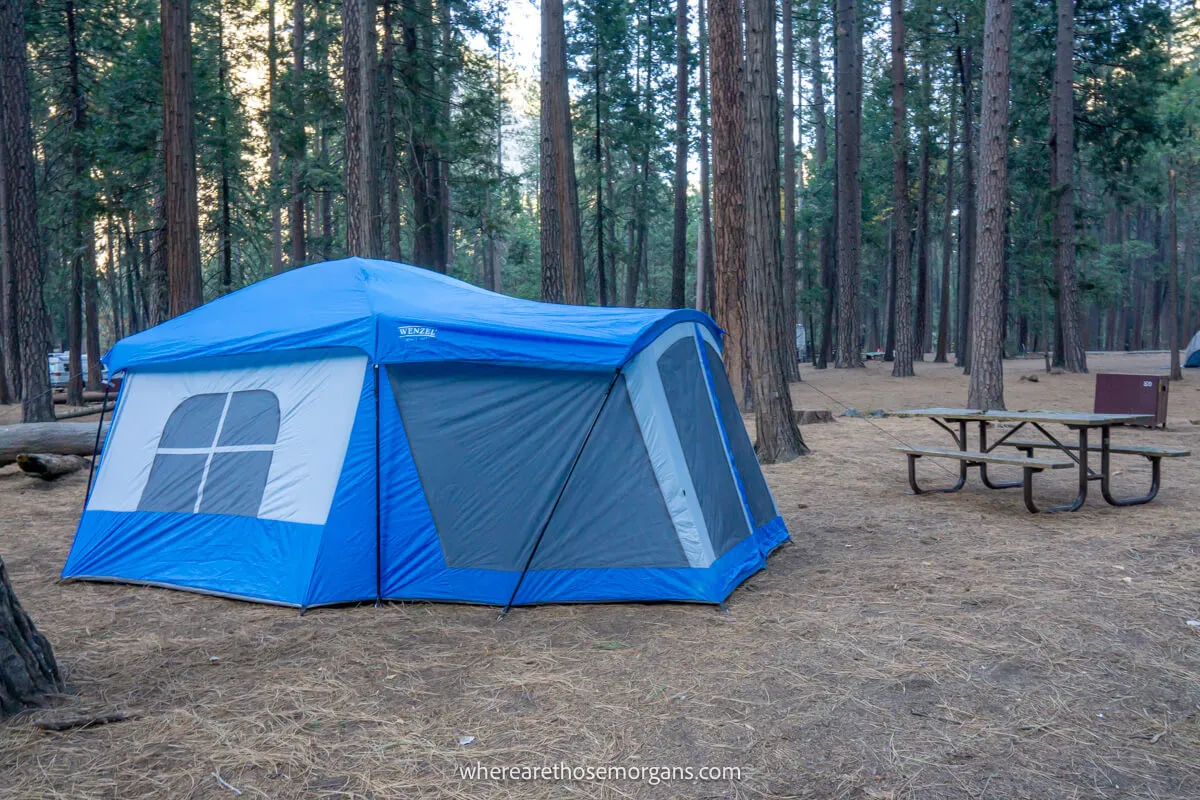
We think booking accommodation is the hardest part about planning a Yosemite itinerary. Firstly, the campgrounds are notorious for having no availability (use our 30 day free trial with The Dyrt to snag cancelled campsites). And secondly, the small villages and towns nearby don’t have many hotel options. Some of the park lodges in Yosemite Valley are reasonably priced but they book up very quickly. Plus, accommodation is expensive around Yosemite, which isn’t surprising considering the massive demand.
We can’t stress enough how important it is to book your hotels, lodges or campgrounds as far in advance as you can so you don’t lose out. Staying in Yosemite Valley makes life so much easier and your itinerary so much more efficient. But if you can’t get a room in the valley because they’re booked up or too expensive, try looking at Mariposa, El Portal, Fish Camp, Oakhurst or along Big Oak Flat Road for hotels.
Our experience: We were driving a longer road trip and we didn’t want to commit to specific dates too early, but that backfired in Yosemite because we ended up having very few lodging options. After leaving our hotel in Mammoth Lakes, we spent our first night in a yurt in El Portal, one night in Upper Pines Campground in our tent and one night at a hotel in Mariposa after leaving the park.
READ : Where to stay in Yosemite
Best Time To Visit
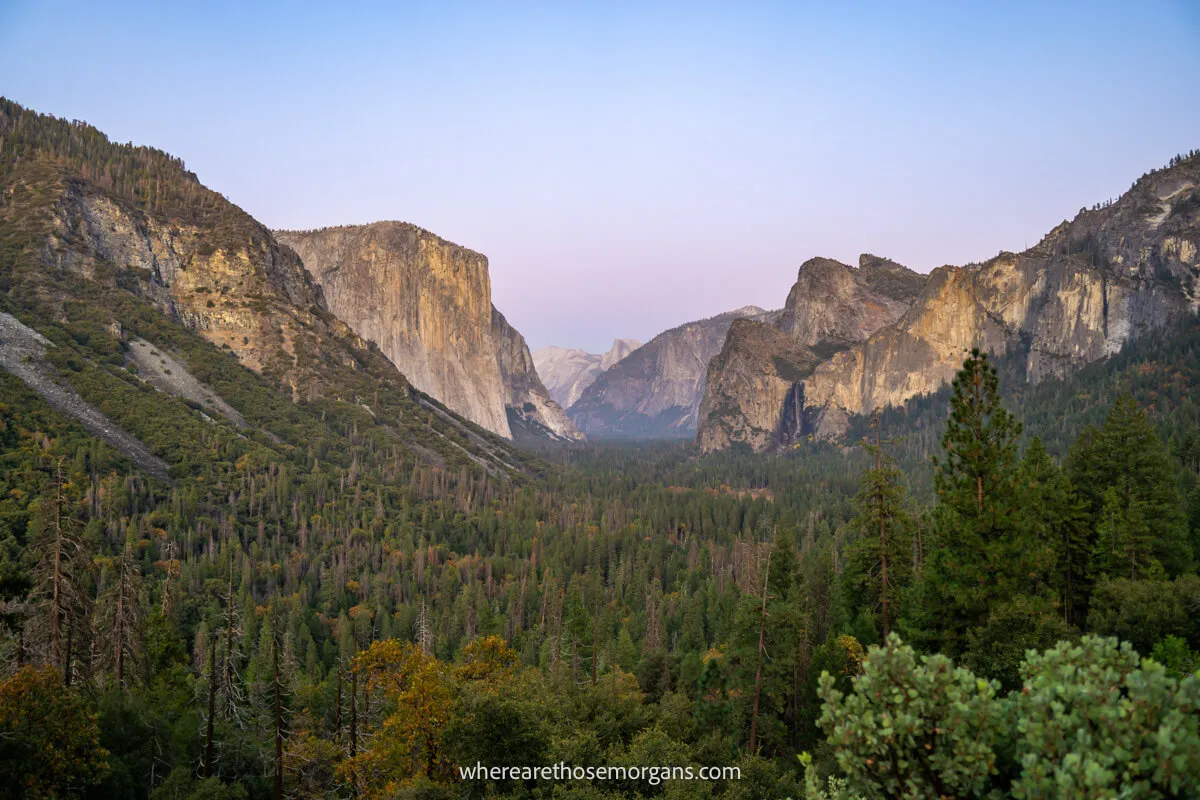
Close your eyes and point to your calendar. It doesn’t matter which date you landed on, Yosemite is going to blow you away. Every season is unique but has its own set of pros and cons. We visited Yosemite in October and it was incredibly colorful but there was barely any water flowing from the waterfalls.
Here’s what you need to know:
- Winter – Skiing, ice skating and snowshoeing, unique, fewer crowds, cold, Firefall in February.
- Spring – Powerful waterfalls, spring blooms, fewer crowds than summer, cool temperatures.
- Summer – Warm weather, overcrowded, very expensive, busy trails, traffic jams.
- Fall – Stunning autumnal colors, dry waterfalls, comfortable temperatures, less busy than summer.
Personally, we would avoid July and August if possible when Yosemite is inevitably going to be busy, hot and expensive. But we know families can only make trips work during holidays and we have our own on the way so we’ll have to contend with July trips soon!
All things considered we think May, June, September and October are the best months of the year to visit Yosemite to benefit from the best balance between crowds, costs, temperatures, activities and accommodation.
READ : Visiting Yosemite in October
Yosemite Map
Click or touch the map below to activate. Zoom in and out, scroll around and get to know what’s on offer around the park before you visit.
- Black – Entrances
- Yellow – Gas stations
- Purple – Accommodation options and areas
- Orange – Hikes, photo spots and attractions
You’ll notice we’ve included a lot more hikes, photo spots and attractions than we listed earlier in our section on what you can’t miss. If you have more time or you don’t plan to hike at all, add in some more of the places we’ve pinned in our map above.
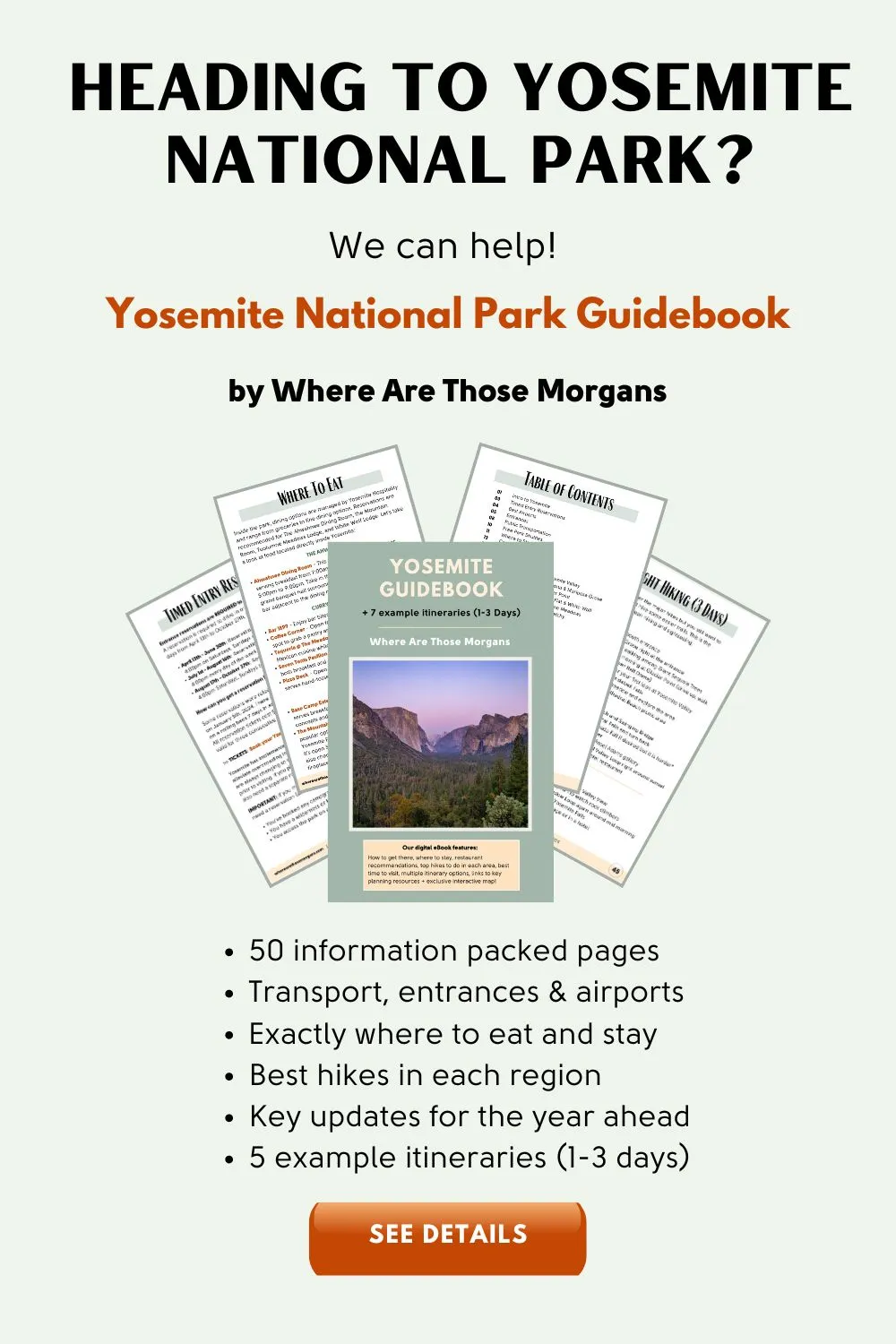
More From Yosemite
- 10 things to know about Yosemite in October
- Best places to stay around Yosemite
- Stunning Yosemite photo spots
- How to hike Mist Trail in Yosemite
Want more California content? Head to our California Travel Guides to explore national parks, popular road trips and things to do in major cities of the Golden state.
We hope this 3 days in Yosemite guide helps with planning your itinerary!
Please let us know if you have any questions in the comments below.
Happy Travels ,
Mark and Kristen
Enjoy this guide? Pin it for later!
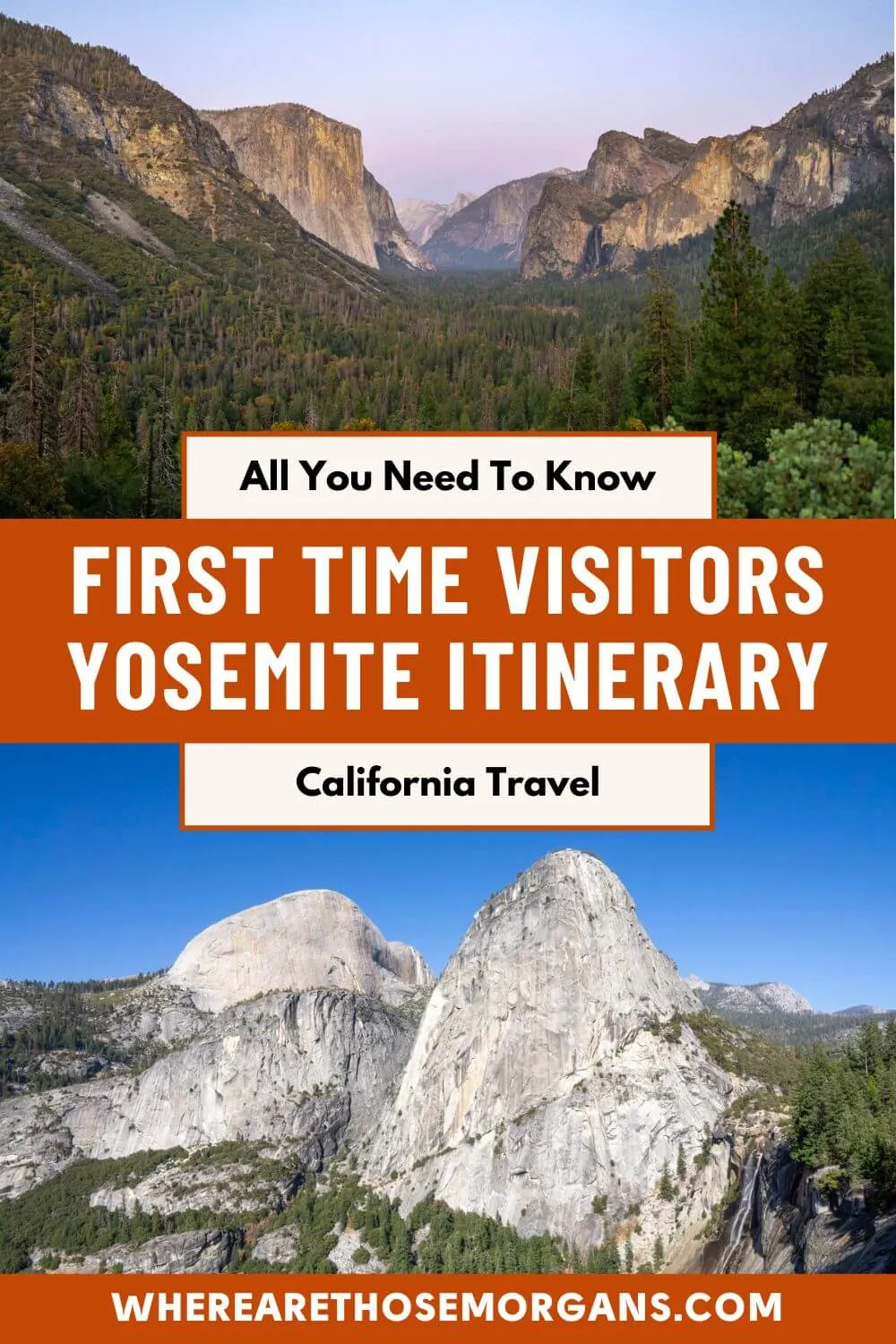
Note : This article contains affiliate links. When you make a purchase using one of these affiliate links, we may earn a small commission at no extra cost to you.
All Rights Reserved © Where Are Those Morgans, LLC. Republishing this article and/or any of its contents (text, photography, maps, graphics, etc.) in whole or in part is strictly prohibited.
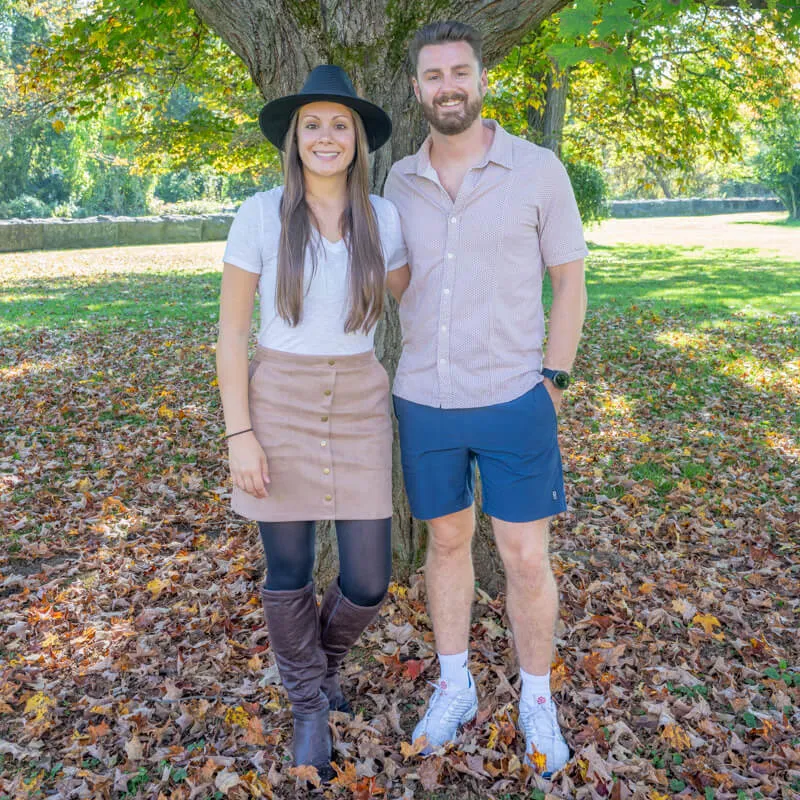
Mark and Kristen Morgan are travel, hiking and photography experts. Over the last 6 years traveling full time, they have explored more than 40 countries and 30 US states.
Where Are Those Morgans has been featured in USA Today, Gestalten, Get Your Guide, CityPASS and Condé Nast Traveler along with various other publications. Read more about us .
12 thoughts on “1-3 Days Yosemite National Park Itineraries: How To Plan A First Visit”
Hello Mark, I want to come from San francisco to yesemite for 2 days and then go to lake taho via tioga pass from October 17th to 18 ( at yosemite) and leave either on 19th or 20th to lake taho. I just need little help to let me know how to exit the park for tioga pass to Lake taho. I have seen your maps but i just needed littel help. YOU have done such a wonderful job of visiting yosemite in october…thank you Mark
Hi Anjana, we’re glad to hear you will be visiting Yosemite in October, the valley is beautiful and a little less crowded this time of year. You should be fine leaving Yosemite via Tioga Pass Road on October 20th (the earliest they have closed that road in the last 10 years is October 21 but it is usually November). You will exit Yosemite Valley on Big Oak Flat Road and take a right turn onto Tioga Road near Tuolumne Grove. That road will take you all the way out of the park to the northeast. Once you reach Lee Vining, take a left onto US-395 N heading for South Lake Tahoe. Have a great time!
Any chance you have a similar guide for Kings Canyon/Sequoia and Joshua Tree?
Hi Kyle, Unfortunately we do not, but we hope to have more Guidebooks published later this year. In the meantime, feel free to reach out with any questions 🙂
Great article!!
We are coming in from Monterey and staying 1 night in Mariposa… Which entrance and itinerary would be best suited to us please!
Thanks, Vish! If you are coming in from Monterey, the best entrance to use is Arch Rock entrance on El Portal Road. Assuming you have 2 days including travel both ways we would suggest spending the first day exploring all of Yosemite Valley after arriving, staying in Mariposa, heading back into Yosemite via Oakhurst and Fish Camp so you can do the Mariposa Grove of Sequoias and Glacier Point, before maybe hiking another trail in Yosemite Valley. We would then leave via El Portal Road to head back to Monterey. It is a lot to drive in just 2 days and staying in Mariposa means you have to drive back out and in again then next morning, but you will still be able to see the top sights easily, especially if you don’t take on any of the longer hikes. Let us know if you have any more questions and have a great trip!
Thank you so much!! This really helps to plan our 3 day trip to Yosemite! Great information and details!
Hi Shrenik, we’re very happy to help and hope you have a fantastic trip to Yosemite!
Enjoyed this so much! My granddaughter is a ranger at Wawona. Her mom and I are hoping to travel to Yosemite this summer. Thank you for all your travel tips!
Thank you Sylvia, Yosemite is a beautiful park – your granddaughter has a great job! We really hope you are able to make it this Summer and enjoy your trip!
An amazing national picture perfect park, almost everything you could wish to see in one place. Excellent pictures once again, keep it up.
Thanks Graham! Yosemite really is difficult to beat for landscapes and photography. Hope you get to use this Yosemite itinerary one day!
Leave a Comment Cancel reply
Subscribe to our newsletter
Get the latest in travel straight to your inbox
Click here to subscribe
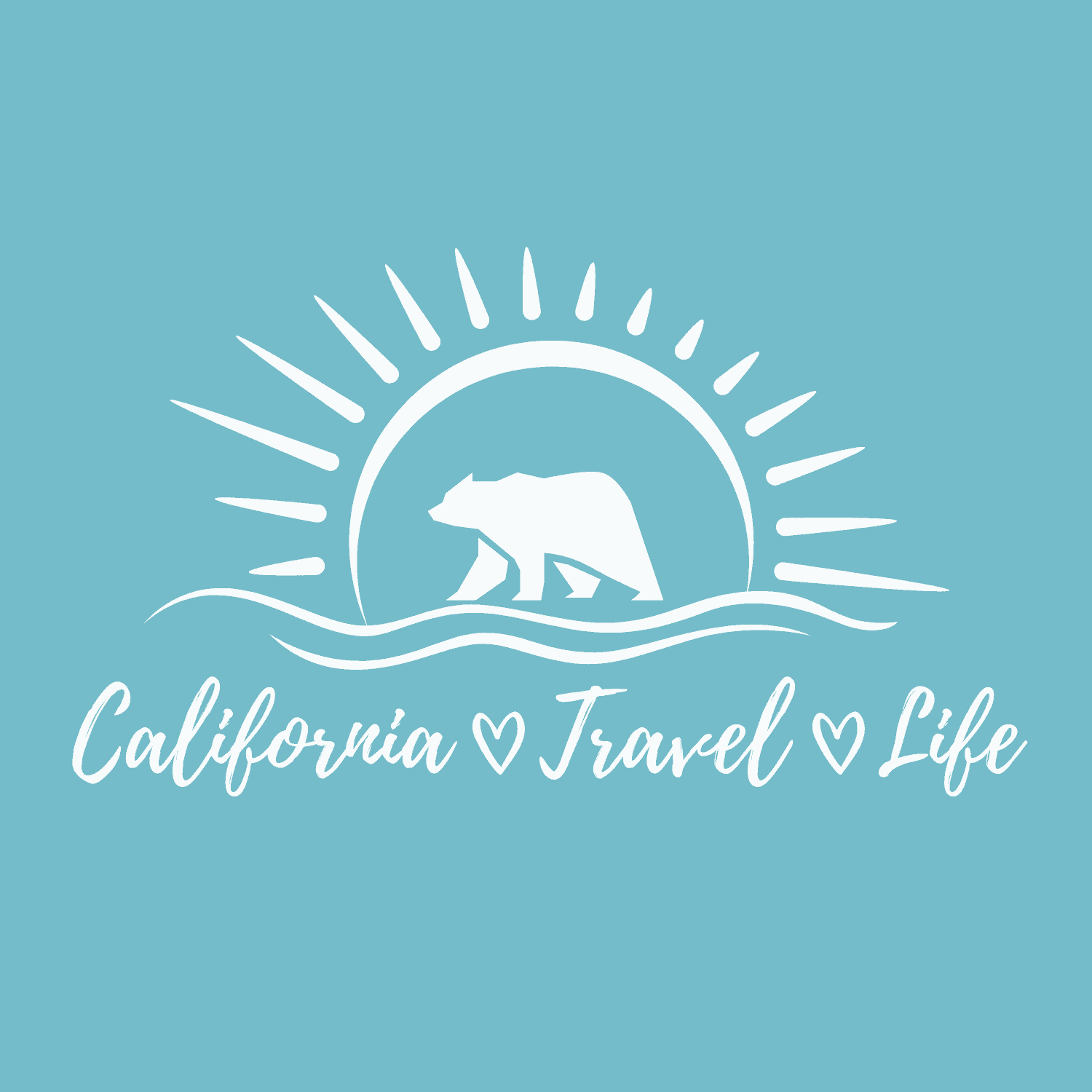
Yosemite Day Trip- One Day in Yosemite National Park
By: Author Sharlene Earnshaw
Posted on Last updated: September 16, 2024
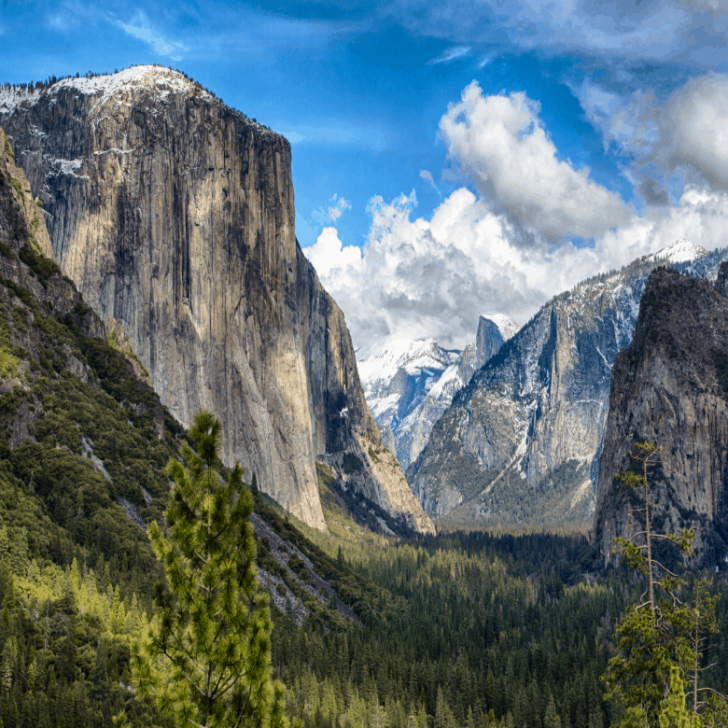
Are you thinking about planning a Yosemite day trip? Yosemite is a place where it is easy to spend days, but many visitors simply don’t have that much time. Fear not! We have put together a great itinerary for one day in Yosemite National Park.
The key to packing in all the highlights that this Yosemite day trip itinerary has to offer is to start your day early. Plan on arriving at a park entrance station by 7AM.
An early arrival will help you avoid time-wasting, long lines at the fee stations and allow for ample time to pack in as much fun to your Yosemite day trip as possible.
Note: This itinerary is designed for people coming in from the west side of the park via highways 120, 140, or 41. If you are coming from the Eastern Sierras, I suggest you focus your itinerary on the many Yosemite attractions off Tioga Road .
When Should I Take My Yosemite Day Trip?

The best time of year to visit Yosemite and see its waterfalls at peak flow is late spring and early summer. In addition to flowing falls, you will also be able to enjoy longer days, so you will get the most out of your Yosemite day trip.
The downside to visiting during late spring and early summer is that it can be crowded, especially on weekends. Stay ahead of the crowds by arriving as early as possible , but expect that you will be sharing this magical place with the masses.
You will also have to consider whether or not you need park reservations. Visit the park website for current reservation guidelines. I recently visited the park during the week in mid-May and I didn’t have to deal with reservations, easily found parking, and the waterfalls were at full flow. If you ask me, that is the sweet spot.
If you are crowd averse, consider taking your Yosemite day trip during the early fall. The weather is still warm, the days are still relatively long, and the crowds are low.
The main downside to visiting during the early fall is that many waterfalls can be dried up (like show-stopping Yosemite Falls) or running at a trickle.
Late fall and winter in Yosemite are both gorgeous, but road closures are frequent due to weather. Glacier Point and Tioga Road are typically closed from the first significant snowfall through at least Memorial Day.
Reservation System for 2024 in Yosemite National Park
Yosemite National Park recently announced that it will require reservations for select dates April through October, 2024 in order to decrease overcrowding in the park.
From April 13 through June 30, a reservation is required from 5am – 4pm on Saturdays, Sundays, as well as May 27and June 19, which are government holidays.
From July 1 through August 16, a reservation is required from 5am – 4pm daily.
From August 17 through October 27, a reservation is required from 5am – 4pm on Saturdays, Sundays, as well as September 2 and October 14, which are government holidays.
Reservations are also required in February during “Firefall season” when Horsetail Fall can glow orange when it’s backlit by sunset, which can make it appear to be on fire. These dates are February 10 -11, 17 – 19, and 24 – 25 in 2024.
Reservations will begin being released on January 5 at 8am and be available in advance. Some afternoon reservations and full-day reservations will be released one week in advance of the date as well.
Pro Tip: You do not need a reservation to enter Yosemite National Park when you use YARTS, the public bus system which takes visitors into the park from various gateway cities, like Mariposa and El Portal off HIghway 140. It is recommended that you book your seat on YARTS in advance, however, especially during peak season.
Staying at a hotel just outside of the park, like the Yosemite View Lodge in El Portal or Autoc a mp in Midpines, and taking YARTS into the park from there is a great peak season hack around the park reservation system.
What Should I Bring on My Yosemite Day Trip?

Since you are planning on arriving early in the morning, I suggest you pack a breakfast. I would also be sure to have plenty of snacks in your daypack, as well as a reusable water bottle. Sturdy, comfortable shoes are a must.
There are several places to eat inside of Yosemite Valley, so you don’t need to pack lunch if you don’t want to. Other essentials for your daypack include sunscreen, a small first aid kit, sunglasses, a hat, a backup phone battery, and a camera.
The weather in Yosemite can vary, so be sure to check the forecast and be prepared to layer. A lightweight rain jacket is always good to have on hand , especially if the spray from the waterfalls is intense or there is potential for rain in the forecast.
Ready to visit more California national parks? Check out this Joshua Tree Day Trip Itinerary .
Itinerary for One Day in Yosemite National Park
1. visit a sequoia grove.
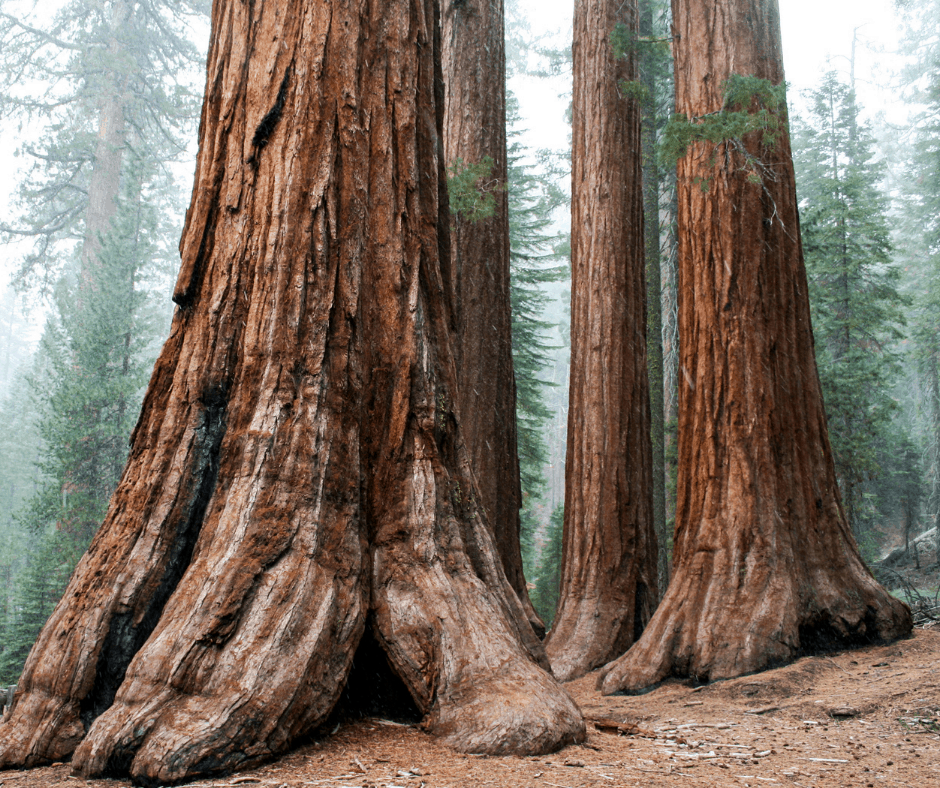
Yosemite is home to some of the largest trees on the planet, and has three different giant sequoia groves. Stopping to walk through one is a must, especially if you have never seen a sequoia in person before.
If you are coming from Southern California, you will likely use the entrance on Hwy 41. Just two miles from that entrance is Mariposa Grove . It is the largest and most accessible sequoia grove in the park.
There are a few different trails in this grove, but since you are short on time, I suggest hitting the highlights- Fallen Monarch, Grizzly Giant, and the California Tunnel Tree.
If you are entering the park from Northern California, you are likely going to use the Hwy 120 entrance. Merced Grove and Tuolumne Grove are both off this highway.
Unlike Mariposa Grove, these groves require that you take a short hike to see the sequoias. Both hikes lose 500 feet in elevation on the way to the sequoia groves. The hike to Merced Grove is 1.5 miles and the hike to Tuolumne Grove is a mile.
Both trails are wide and well-maintained. They are a great way to get the blood flowing in the morning before you head into Yosemite Valley.
Note: There are no sequoia groves off Highway 140. I suggest you visit Tuolumne Grove, which is the closest to that entrance.
2. Take in the Yosemite Valley at Tunnel View
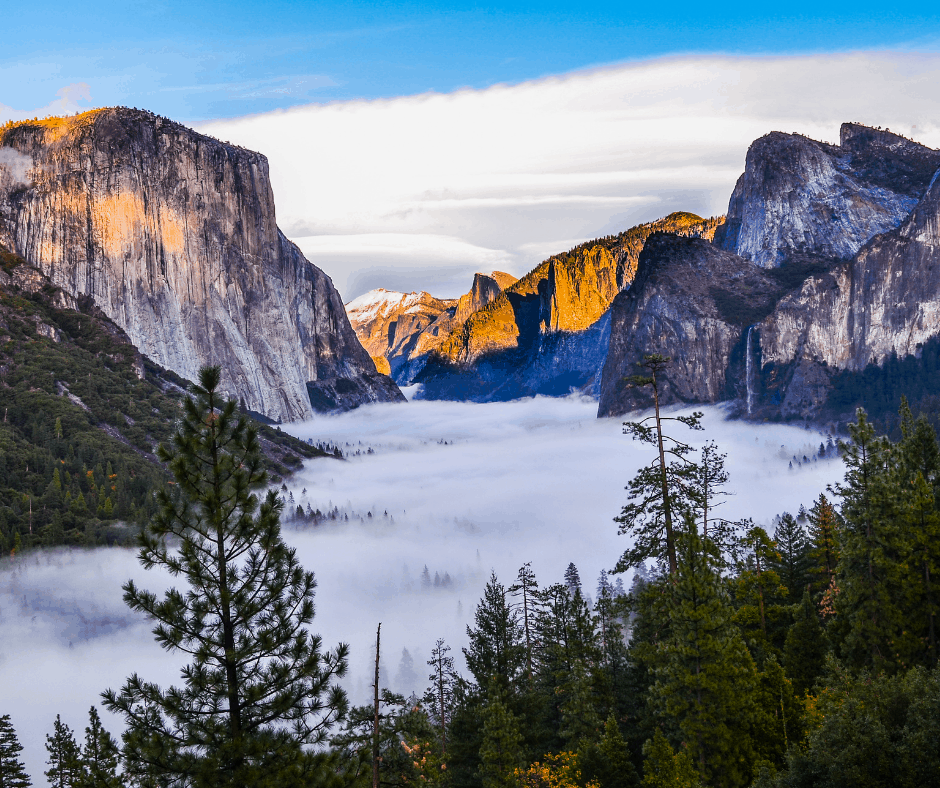
The next stop on your Yosemite day trip should be Tunnel View . This roadside pullout has some of the best views of the Yosemite Valley.
From Tunnel View you can see many of the Valley’s superstars including Bridalveil Fall, El Capitan, and Half Dome. This is the spot to get the perfect Yosemite Valley photo.
If you are coming into the park from Hwy 41, you will pass through a mile-long tunnel and see the famed pull-off shortly thereafter.
If you are coming from Hwy 120 or 140, follow the signs for Bridalveil Fall. The parking lots for Tunnel View will be just before you enter the tunnel. There are lots on either side of the road.
3. Stop and Admire Bridalveil Fall
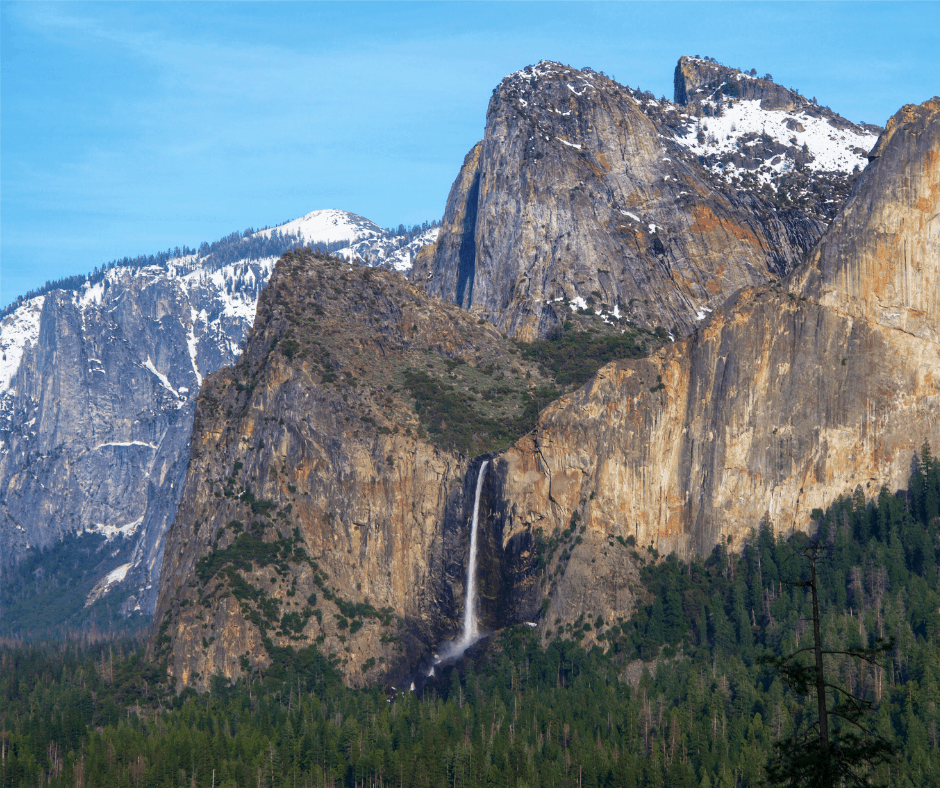
After stopping to admire those Valley views, hop back in the car for a very short jaunt over to the Bridalviel Fall parking lot. From the lot it is a short, quarter-mile walk to the base of this 620-foot waterfall.
The trail is paved and this waterfall runs year round. You will be able to feel the spray from the falls when you are close to the base, so prepare to get a little wet.
4. Park and Peruse the Visitor Center and Surrounding Museums
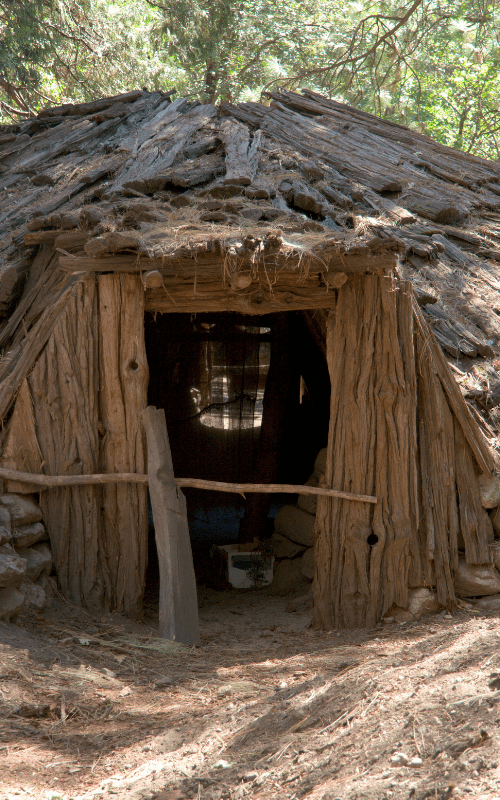
Parking can be a challenge in Yosemite Valley during the high season, so prepare to park your car and leave it until you are ready to leave the Valley.
Thankfully, it is easy to explore the Valley via YART, Yosemite Valley’s free shuttle, as well as on foot or on bike.
I suggest parking in the lot closest to the visitor center (hopefully you arrived early!). Do not leave any traces of food in your car! Bear sightings are common and bears are well known for breaking into cars for food.
I always like to check out a National Park Visitor Center early in my visit to gain the latest information about special programs and closures, grab a Junior Ranger booklet for my kids, and quickly check out the exhibits.
The visitor center is also where I get my National Park Passport booklet stamped and pick up a patch for my National Park collection. There is also a park movie playing in the visitor center’s theater which is usually worth watching.
Next door to the visitor center is the Yosemite Valley Museum and the outdoor Indian Village of the Ahwahnee . These free museums focus on the original inhabitants of the Yosemite Valley.
It is worth your time to walk through the recreated village to see a variety of Miwok dwellings like the Chief’s House, a sweat lodge, a couple different bark houses and a Miwok cabin.
The Ansel Adams Gallery is also near the visitor center. It is a good place to walk through if you are interested in the famous photographer’s work.
5. Embark on a Tour of Yosemite Valley
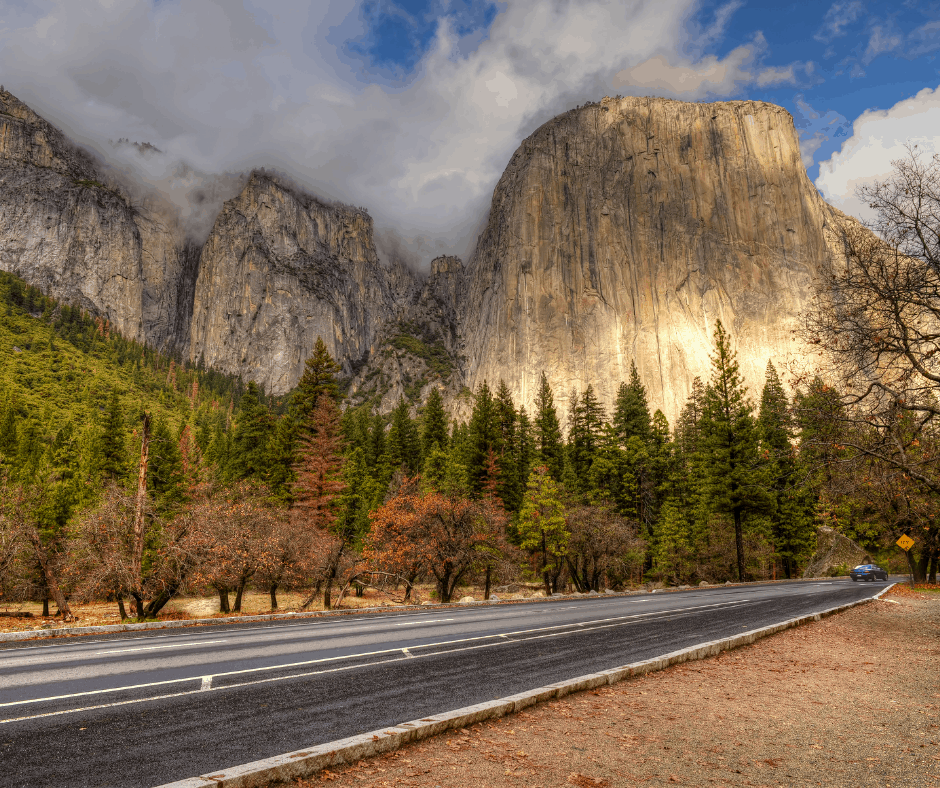
If you want to take a tour led by the experts themselves, then definitely sign up for the Yosemite Valley Floor Tour at the Yosemite Valley Lodge.
You can call (209) 372-1240 for tour availability and times for the day you are visiting, but usually the first tour is at 10AM, so try to get on that one! Tours cost $38 for adults and $28 for children.
Tours are led by Yosemite park rangers in open air trams. They provide you with a great overview of the Valley as well as plenty of history and fun facts. The open air tram allows you opportunities to get some great photos along the way.
Highlights of the tram tour include Yosemite Falls , Half Dome , El Capitan , and some sites you might have already seen like Tunnel View and Bridalveil Fall . Still, the overlap is worth your time because you will get lots of great information about the sites.
6. Bike the Yosemite Valley
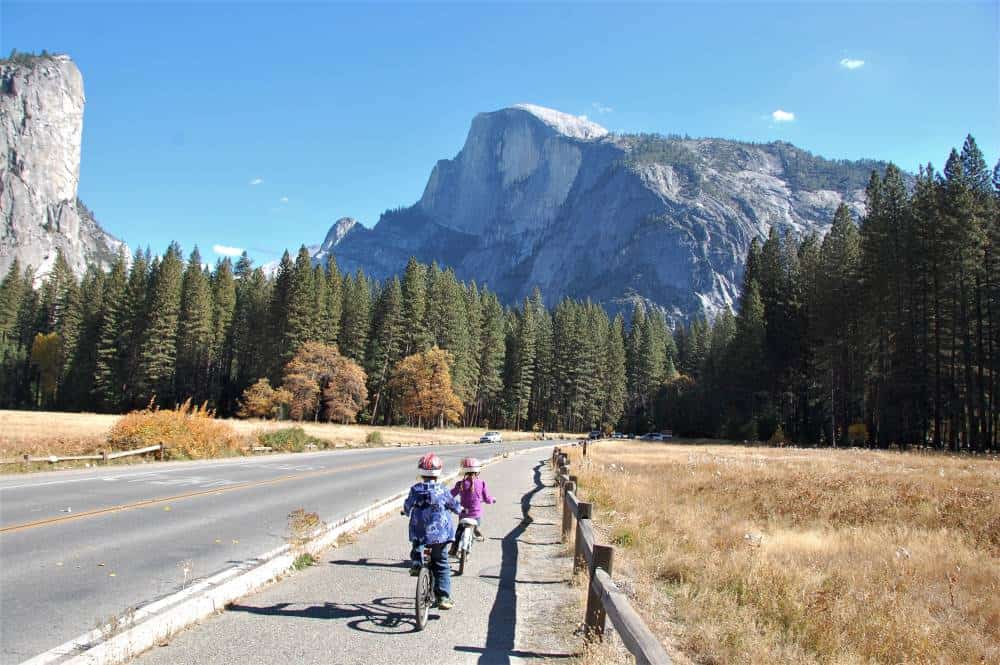
If the Yosemite Valley Tour is not available or sitting in an open air tram for two hours is not your thing, maybe biking around Yosemite is more your speed.
Biking around the Yosemite Valley is quite easy, since the terrain is mostly flat and the paths are wide and plentiful. You can bring your own bikes or rent them at Curry Village or the Yosemite Valley Lodge. Bike rentals are typically available late May through mid-October.
On a Yosemite day trip I prefer to rent bikes from Yosemite Valley Lodge because the walk from the visitor center parking to the bike rental stand isn’t too far and you can take time to see Yosemite Falls along the way.
Better yet, save even more time and bring your own bikes. Ebikes are a great way to explore the Yosemite Valley. We love our foldable Centris ebikes that are perfect for travel.

There are 12 miles of paved trails that loop around the Valley Floor. On these trails it is easy to cover the 7-mile length of the Valley in a short period of time, all while taking in meadows, granite monoliths, and the meandering Merced River.
Be sure to hit the highlights- watch rock climbers scale El Capitan, enjoy views from Sentinel Bridge, keep your eyes peeled for wildlife in the meadows and along the river, and make time to stand near the base of Yosemite Falls.
Note: Bikes are not allowed on dirt trails.
7. Take the Hike to the Vernal Falls Footbridge
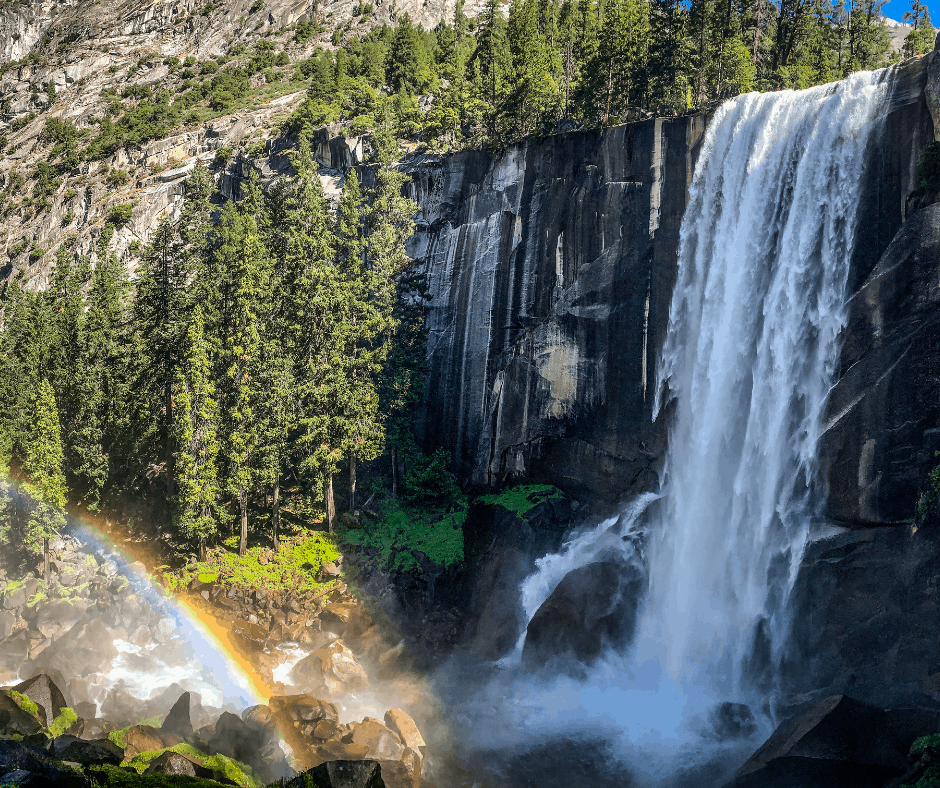
The Mist Trail is one of the most popular trails in all of Yosemite because it is the route to Vernal Falls, Nevada Falls, and Half Dome.
Since you only have one day in Yosemite, you won’t have time to make the 5.4-mile round trip hike to Nevada Falls or the 15-mile trek to the top of Half Dome, but you will be able to make the 1.6-mile hike to the Vernal Falls footbridge.
The hike is mostly uphill on the way to the footbridge and is considered moderate, but shouldn’t be hard for anyone moderately in shape.
From the bridge you will have a nice view of Vernal Falls, especially during peak flow. You can continue uphill another .4 miles to get a view from the top of Vernal Fall. Expect to get wet from the fall’s mist as you climb the stone steps (this is how the mist trail got its name).
Love to hike? Here are 16 Easy Hikes in Yosemite National Park .
8. Take a Break on the Ahwahnee Patio
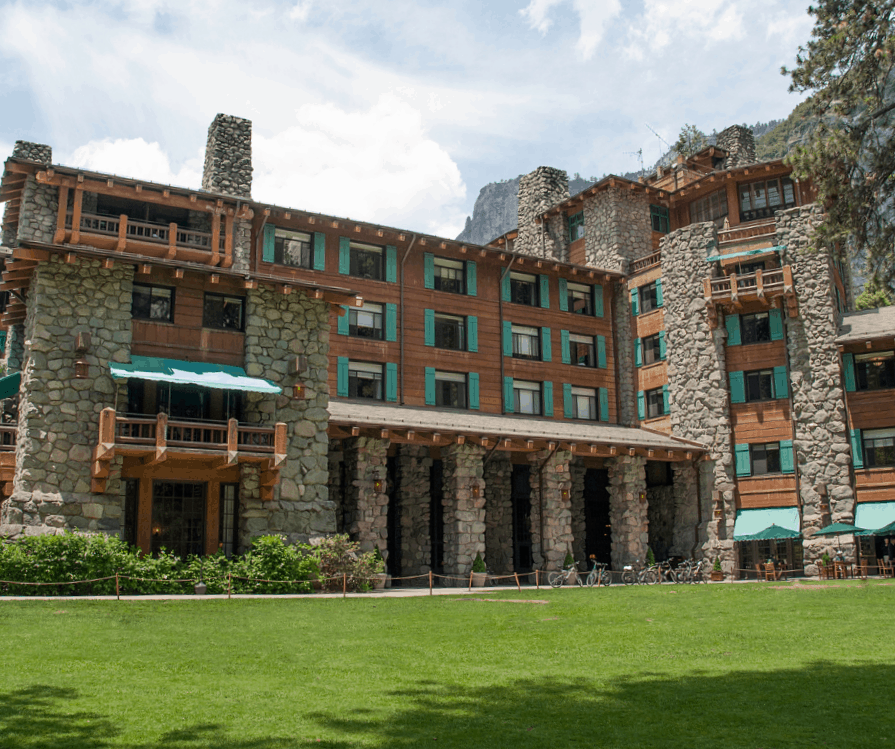
The Ahwahnee Hotel is probably the most famous of all the National Park lodges. This grand hotel was used by Stephen Mather, the first National Park director, to lure the rich and important so they would visit the incredible Yosemite Valley and see why it was worth funding.
The patio area of the Ahwahnee has lovely views and a sprawling grass lawn where wildlife sightings are common- I once saw a bobcat! It is a great place to sip on a cocktail or eat a sandwich.
If you are closer to Curry Village when you are ready for a break, the Curry Village Pizza Patio & Bar is a good spot to relax and enjoy pizza or a salad washed down with a beer.
9. See Yosemite Valley from above at Glacier Point

Your time in Yosemite Valley has come to an end, but there is still more to see!
Glacier Point sits high above Yosemite Valley at 7,200 feet in elevation, and offers incredible views of the High Sierras, Half Dome, and the Yosemite Valley floor 3,200 feet below.
You will reach Glacier Point by heading out of Yosemite Valley, following Wawona Road through the tunnel, and then taking a left turn onto Glacier Point Road. The entire route is 32 miles, but expect it will take an hour to get there.
Glacier Point is extremely popular and you may have to wait for a parking spot, but be patient because the views are worth it! So is the ice cream from the seasonal ice cream stand.
The walk from the parking lot to Glacier Point is nothing more than a quarter mile round trip. If you want to stretch your legs and have time before the sun sets, consider taking the hike up to the top of Sentinel Dome which is nearby. The views are spectacular and it is a great way to end your epic Yosemite Day trip.
Note: The road to Glacier Point is closed from the first significant snowfall (typically early November) through mid-May, typically. Check road conditions if you are visiting during the shoulder seasons.
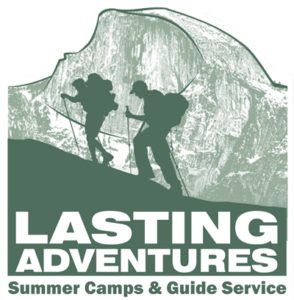
2012-2023 Traveler’s Choice on Trip Advisor – Over 1,200 5 Star Client Reviews!
Add Your Heading Text Here
Olympic national park, sequoia-kings canyon national park, joshua tree national park, lassen volcanic national park, trips by type, backpacking trips, youth programs, guided day hikes, specialty adventures, camping programs, lodge-based programs.
Click Here To Shop Adventure Deals!
Outdoor Summer Camps
Yosemite national park, outdoor education & group trips, specialty programs, joshua tree np winter camps, national park resources.
YOSEMITE NATIONAL PARK
OLYMPIC NATIONAL PARK
LASSEN VOLCANIC NATIONAL PARK
General Resources
1-800-513-8651, [email protected], p.o. box 1078, groveland, ca 95321.
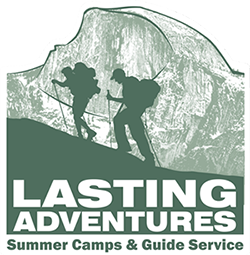
The Ultimate One Day Trip to Yosemite National Park
Yay! You’re planning a trip to Yosemite!
Home to incredible granite formations, powerful waterfalls, giant Sequoia groves, and some of the world’s most breathtaking views, Yosemite National Park is truly one of America’s greatest national parks.
However, with 747,956 acres to explore, you won’t have enough time to see it all. You may even only have one day! That’s why we’ve put together a one-day itinerary so you can have the best, action-packed day in Yosemite National Park.
The most scenic way to get there is through CA Hwy 41, where the road meanders through the mountains and brings you to the first must-stop: Tunnel View. After driving through the long, dark Wawona Tunnel, the road spits you out to a parking lot with jaw-dropping panoramic views of Yosemite Valley. From here you can see El Capitan, Bridalveil Fall, and Half Dome all in one vista. This is the perfect place for pictures!
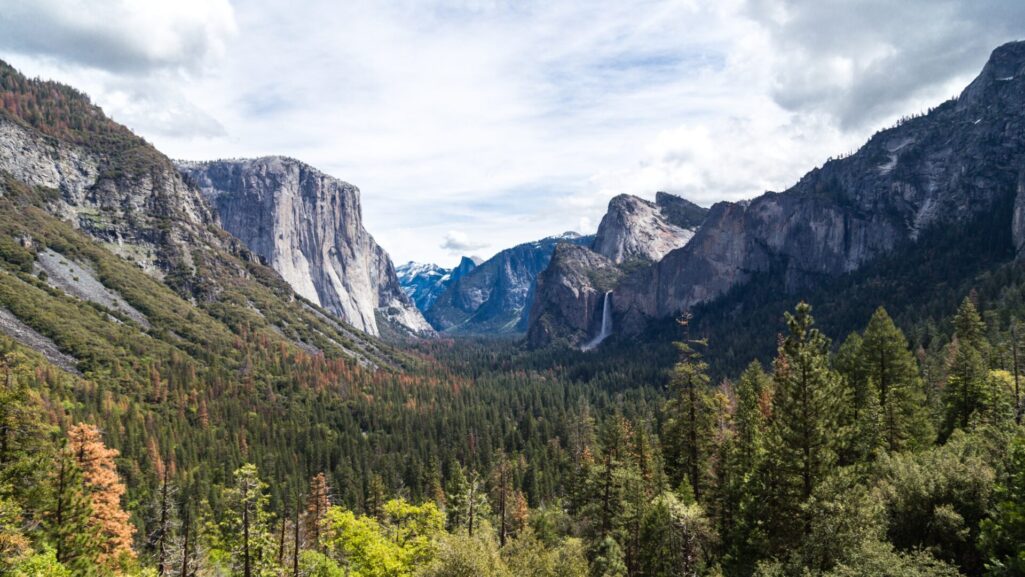
The next place to stop is Bridalveil Fall. This easy trail is a 0.4 mile out and back stroll. Once you reach Bridalveil, you can strain your neck to see the water plunging 620 feet over the valley down below. If you visit in spring or early summer when the water is at its peak, expect to get wet!
At the heart of the Valley is Yosemite Village. While I’m sure you would rather spend your time experiencing Yosemite outside than reading about it inside, Yosemite Valley’s Visitor Center and Museum is a great place to buy souvenirs, stamp your national park passport, and learn more about the history and geology of Yosemite. In the heat of summer, the 30-minute film playing behind the visitor center is an essential stop to not only learn more about the park but also stay cool while doing it. The Ansel Adams Gallery is also an excellent spot to find unique gifts for your loved ones or yourself.
If you have time, stop by the iconic Ahwahnee Hotel. Entertaining guests from Barack Obama to Walt Disney to Queen Elizabeth, this hotel was declared a National Historic Landmark in 1988 and haa a lot to look at as you walk through the grand lounge. You can order up a bavarian pretzel and cocktail from the bar during the day or make a reservation to the massive Harry Potter-like dining hall for dinner. Wand optional.
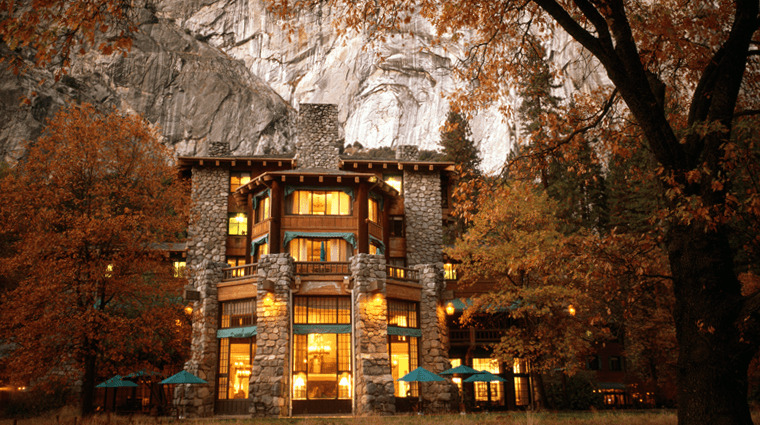
If your budget and time allow, I would highly recommend taking a guided tour of Yosemite Valley . Not only will you get to see all of the incredible views that the Valley has to offer, but you get to learn more about the Valley’s history, geology, flora, fauna, and more! With over 1,200 5-star reviews on TripAdvisor, Lasting Adventures offers a Yosemite guided tour that caters to families and hikers of all skill levels, especially to those who are first-timers to the park and/or those who want an easier-to-moderate walking tour of the famed Yosemite Valley.
If you decide to take yourself on a Valley tour, renting bicycles at Curry Village or using the Valley Shuttle Bus are excellent ways to get around the valley floor. PRO TIP: Yosemite has a free bike share program, where you can download the Yosemite Bike Share app , unlock a bike, and pedal around the Valley! However, there are only 50 bikes, and they are usually available between June and October.
If traveling by foot is more your style, three easy hikes in the Valley are Lower Yosemite Falls, Sentinel Meadow & Cook’s Meadow Loop, and Mirror Lake. Lower Yosemite Fall is part of North America’s tallest waterfall with the final 320-foot drop. The hike is an easy 1-mile loop and is across the road from the Yosemite Valley Lodge. Sentinel Meadow & Cook’s Meadow Loop is a flat, easy 2.25 miles round trip trail that takes you on boardwalks through a pair of meadows with multiple views of Yosemite Falls and Half Dome. Lastly, Mirror Lake is a beautiful hike to a seasonal lake that is perfect for splashing around with Half Dome towering about 5000 feet above. It is an easy to moderate hike that is 2 miles round trip to the lake and back, or 5 miles if you take the whole loop around.
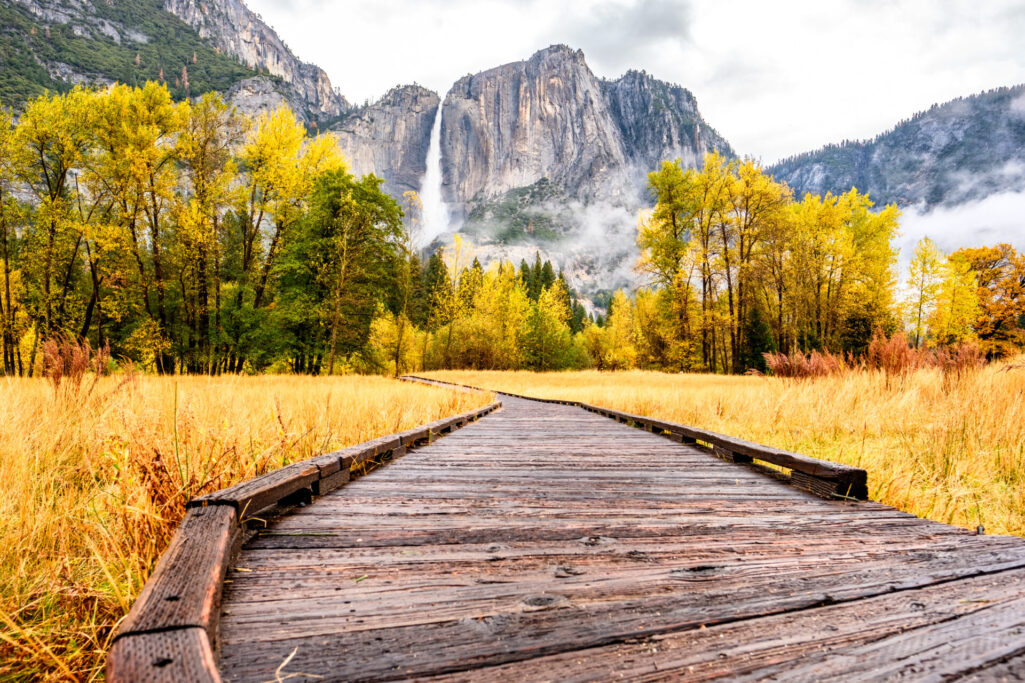
The best way to end the day is to drive up to Glacier Point to watch the sunset. The Glacier Point Road is open to cars approximately late May through October or November (although closed entirely in 2022), depending on conditions. The road will take you to a sensational panoramic viewpoint that overlooks the entire Yosemite Valley and beyond. Off of Glacier Point Road is the Taft Point Trail, an easy-to-moderate 2.3-mile out-and-back trail with the most incredible views (and a great place for the coolest photo op ever). If you get the chance to hike Taft Point by sunset, even better!
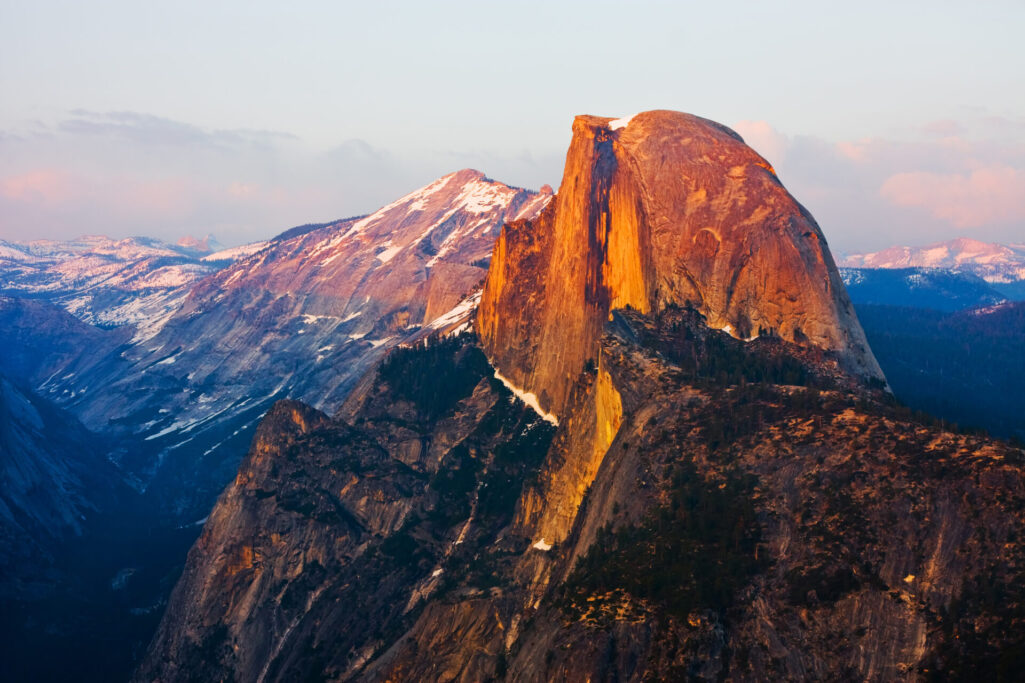
While Yosemite National Park has so much more to offer, this itinerary will give you some of the most iconic and breathtaking views that you can experience in just one day–or even in an entire lifetime.
Subscribe to Our Mailing List:
P.o. box 1078 groveland, ca 95321, guide service.
SEQUOIA-KINGS CANYON NATIONAL PARK
SPECIALTY ADVENTURES
Youth Trips
SCHOOLS & GROUPS
ABOUT OUR PROGRAMS
©2024 Lasting Adventures | All Rights Reserved | Privacy Policy | Terms & Conditions | Cookie Policy
Adventure Deals
Trips by destination, sequoia-kings canyon, lassen volcanic, sequoia national park, joshua tree winter camps, lassen national park, trip finder.
- Skip to main content
- Skip to primary sidebar
- Skip to footer

The Perfect Yosemite Itinerary: 1, 2 or 3 days (2024 Update)
Please note: This post contains affiliate links.

Wondering how to plan a day trip to Yosemite National Park? Seeking a Yosemite 2 day itinerary? Planning for a long weekend and need a Yosemite 3 day itinerary? No matter how many days you plan to spend in Yosemite, I’ve got you covered!
Having visited four different times in spring and winter for three days each during the past few years, I’ve compiled the perfect Yosemite itinerary to help you maximize your time, see and photograph the highlights, hike and avoid the crowds.
If your schedule allows, I highly recommend spending two to three days in Yosemite , allowing you to admire the park’s beauty from a variety of angles and viewpoints. To help you plan, I’ve included when to visit Yosemite, where to stay when visiting Yosemite, tips on the best places to eat and towns to explore near Yosemite.

TOP TIP : If you have time, enter via one entrance and exit via another gate to take advantage of all the pullouts, vantage points and fascinating California gold rush towns near Yosemite National Park.
My favorite gold country towns include Oakhurst, Murphys , and Mariposa. With five entrances to Yosemite, you have lots of options, including wine tasting along the Madera wine trail outside Wawona (Yosemite’s south gate).
Given that Yosemite Valley is 2.5 to 6 hours from most major cities and attractions, it’s best to stay in Yosemite National Park or in one of the nearby towns ( Oakhurst , Mariposa or Groveland) to maximize your time. Also, after the long hiking days, I found myself too tired to drive back to San Francisco.
Want to extend your California road trip? Definitely consider visiting Sequoia and Kings Canyon National Parks as part of a broader Majestic Mountain Loop journey through the Sierra Nevadas.
Yosemite National Park Entrances

- Hetch Hetchy – Highway 120
- Big Oak Flat – Highway 120 – Coming from San Francisco? You’ll probably come in this gate. This route passes through Groveland and Sonora is nearby.
- Arch Rock – Highway 140 – This is the other popular entrance if you are traveling from San Francisco to Yosemite. You’ll pass through Mariposa .
- Wawona – Highway 41 – If you are traveling from Los Angeles, Death Valley or Fresno, you’ll pass through Oakhurst .
- Tioga Pass – Highway 120 – If you are coming from Bodie ghost town, Mammoth Lakes or Mono Lake, you’ll enter through this gate. Due to snow, this eastern entrance is typically only open from June-early November.
How far is the drive to Yosemite Valley ?

- Murphys : ~90 miles/2.5 hours. My favorite gold rush town !
- Fresno : ~100 miles/2.5 hours
- Kings Canyon : ~150 miles/3.5 hours
- Sequoia National Park : ~170 miles/3.75 hours
- San Francisco : ~200 miles/4.5 hours
- Los Angeles : ~ 300 miles/6 hours
- Death Valley : ~ 400 miles/7.5 hours. Venture here before or after and use my Death Valley hiking guide and Death Valley road trip guide
- Joshua Tree National Park : ~ 420 miles/7.5 hours
Yosemite National Park Entry Tips
If you are entering Yosemite National Park at 9 or 10am , especially on the weekends or from June-September, be prepared to wait in line at the Visitors Gate for 2-3 hours!
From April 13-June 30, 2024 , you will need a reservation to enter on weekends and holidays (May 27 & June 19), if you are entering between 5AM-4PM .
From July 1- August 16, 2024 , a reservation is required every day of the week, if entering the park between 5AM-4PM .
From August 17-October 27, 2024 , you will need a reservation to enter on weekends and holidays (September 7 & October 14), if you are entering between 5AM-4PM .
Be aware, even if you are just driving through the park and not visiting or staying, a reservation will be required as noted above.
The reservation cost is $2 per car.
TOP TIP : If you are an early bird, arrive before 5AM and you will sail through the gates and spend your first few hours of the day soaking in the solitude and views without throngs of people.
Most reservations were released on Recreation.gov on January 5, 2024 . However, there are still some dates and times available. If you weren’t able to secure one of those, additional reservation slots will be released 7 days before arrival date. (i.e For April 28, slots will be released April 21).
TOP TIP : Be sure you have a recreation.gov account set up, are signed in and click on your desired date promptly at 8AM PT as the reservations sell out within a minute or two.
When you secure a reservation, it will give you three days of consecutive access. You will need to show photo ID at the gate that matches the name of the reservation and that person must be in the entering car.
Also, be prepared to pay $35 at the gate for the National Park pass. Cash and credit card are accepted. If you plan to visit more than two United States National Parks in the next twelve months, it’s worth investing in the America the Beautiful Pass for $80. Buy from REI or at the gate.
TOP TIP : Since they sometimes sell out of annual passes at the gates, it’s best to purchase in advance.
When to Visit Yosemite – Planning the Perfect Yosemite Itinerary
Wondering when is the best time to go to Yosemite?

Yosemite’s landscape changes dramatically throughout the year. To simplify your Yosemite itinerary planning, I’ve included unique things to do in Yosemite during different seasons.
Personally, my favorite time to visit Yosemite is the spring when you can immerse in the breathtaking sights and sounds of powerful waterfalls cascading over the granite rocks.
FUN FACT : Yosemite Falls is the highest waterfall in North America (2450 ft/747 m) and the fifth highest in the world .
If you are a waterfall lover like I am, many of Yosemite’s waterfalls only trickle by August and don’t reappear again until late winter or early spring when snow begins to melt.
SPRING IN YOSEMITE

Spring is prime time for gushing waterfalls , wildflowers (dogwoods and redbud bloom in April), and hiking . Moderate temperatures (33-73F/0-22C) and fewer people make for a pleasant hiking experience.
TOP TIP : In April, May and June, you can witness lunar rainbows (aka moonbows) on Upper and Lower Yosemite Falls during full moons. Check Brian Hawkins’ predictions for the best dates and timing.
This is also a great time of year to capture reflections at Mirror Lake. See more about Mirror Lake below.
SUMMER IN YOSEMITE
Summer is the busiest, buggiest and hottest time to visit Yosemite National Park. If you can avoid visiting during this time, I would. Lodging and parking are harder to find and you’ll contend with more crowds on the trails. During the summer, an early start is key to avoid hiking in the oppressive mid-day heat. More about the hikes below.
TOP TIP : Summer is the most popular time to hike Half Dome as the cables are typically only up from late May to mid-October .
If you want to secure a permit to hike Half Dome in 2024, the preseason lottery took place in March 2024. However, day passes will be available two days in advance of the desired date and you can try for those via the Yosemite Half Dome reservation site from May 22 – October 13, 2024. (Note these are estimated dates that are subject to change based on snow conditions).
TOP TIP : These passes will be available to reserve starting from 12AM to 4PM Pacific time, but they will go quickly, so be signed into your recreation.gov site and be ready to select your date right at 12AM.
350 permits are issued per day (225 for day hikers, 75 for backpackers, 50 via lottery two days in advance).
FALL IN YOSEMITE
Fall brings beautiful colors reflected in the Merced River. The combination of fewer crowds and cooler temperatures makes this my second favorite time of year to visit the park.
FUN FACT : If there is water trickling in Horsetail Fall, you can get Firefall in October! However, this is rare.
WINTER IN YOSEMITE

Seeking snow covered scenes, snowshoeing or skiing? Plan a Yosemite wintertime visit. This is a good time of year to capture fog caressing the treetops from Tunnel View.
TOP TIP: To find out road conditions and chain restrictions, call 209-372-0200 (press 1, then 1). If there is snow and/or ice, chains are often required (even if you are driving an AWD or 4WD), so this is an important consideration.
If it is snowing, entering via the Arch Rock gate on El Portal Road (highway 140) is your best bet as it’s the lowest elevation road .
Horsetail Fall – Firefall Event

For two weeks in February, if conditions are right, Horsetail Fall, which trickles down the side of El Capitan, lights up and looks like lava at sunset (and for the 15 minutes before) and is known as “ Firefall .” For this to happen, three things must happen:
- Sufficient snowpack to melt and cause Horsetail Fall to flow.
- A clear night. If there are clouds on the horizon, the sunset rays won’t hit Horsetail Fall and light it up.
- Wind to blow the mist and add a more dreamy quality to the scene.
Top Tips for Shooting Firefall
- Visit on a weekday as crowds are bonkers on the weekends. Some people arrive as early as 12PM to claim a spot. Bring a chair, blankets, a book, food and a headlamp.
- Position yourself east of the El Capitan Picnic Area.
- Shoot a 70-200mm lens on a tripod.
Aaron Meyers Photography has predictions to help you plan for a future Yosemite Firefall trip.
The Perfect Yosemite Itinerary (for 1, 2 or 3 days)
I’ve included a 3-day Yosemite itinerary that you can mix and match to fit your needs and interests, calling out highlights and photography tips to make the most of your time in this gorgeous United States National Park.
Yosemite Itinerary: Day 1 – Explore Yosemite Valley
#1 sunrise at tunnel view.

This is one of the most popular places to stop on any Yosemite itinerary for good reason. You can marvel at El Capitan, Half Dome, the Three Graces and Bridalveil Fall as the sun rises.
FUN FACT : This is where Ansel Adams captured some of his most iconic Yosemite National Park images.
Seeking Tunnel View with moody fog and clouds? These ethereal conditions tend to be most common with spring or winter storms.
PHOTOGRAPHY TIP : Wait for the sun to crest above the valley to get a sunburst at sunrise. To maximize the effect, stop down your aperture to F16 or F22.
A wide-angle lens (16-35mm) or a mid – range telephoto (24-70mm) works best for capturing all four icons in one frame.
Located 8 miles (15 minutes) from Yosemite Valley, 40 miles (1 hour 10 minutes) from Oakhurst , and 40 miles (1 hour) from Mariposa , sunrise is ideal if you are staying in the park. If you miss sunrise, come for sunset, which is just as pretty!
#2 Golden Hour at Artist Point or Inspiration Point = a short hike

Want a quick hike after sunrise without crowds? Cross over from the Tunnel View parking lot and hike up to Artist Point (2.3 miles round trip/741 feet elevation gain) or Inspiration Point (2.6 miles round trip/1043 elevation gain). They both offer a similar view to Tunnel View without the crowds.

TOP TIP : While I considered hiking up to Artist and Inspiration Point for sunrise, I’m glad I didn’t as I found the trail a bit confusing. Make sure to download All Trails . Use this to navigate and stay on the trail as I accidentally got off trail a couple of times.
#3 Bridalveil Fall
As you drive along Southside Drive, make a quick stop at Bridalveil Fall. Water flow is typically strongest in April, May and June .
As of April 2024, the walkway for Bridalveil Fall is finally re-opened after being closed for five years for restoration. Once again, you are able to appreciate its beauty from a closer vantage point.
FUN FACT : Bridalveil falls 620 ft (189 m) into Yosemite Valley.
#4 Cathedral Beach

For an El Capitan reflection shot , pull into Cathedral Beach and walk down to the water’s edge. Just after sunrise, the combination of calm waters and first light on El Capitan leads to the ideal conditions for a reflection photograph.
PHOTOGRAPHY TIP : For scale, you can include someone in a bright jacket in the shot.
Look closely and you’ll likely see climbers on El Capitan .
#5 Sentinel Beach
Since the Three Brothers are particularly photogenic in fall and winter surrounded by rust colored foliage or capped in snow, this is another great option for a serene reflection image.
PHOTOGRAPHY TIP : Use a tripod and opt for a 10-30 second exposure to smooth the water. Depending on the time you arrive here, you might need a 6 or 10 stop neutral density filter for a long exposure image.
#6 Swinging Bridge

Continue on to the Swinging Bridge parking lot for an early morning view of Yosemite Falls reflected in the Merced River. April, May and June have the strongest water flow.
This bridge gets really busy later in the day so early morning is best if you are seeking solitude.
PHOTOGRAPHY TIP : For a long exposure shot, use your tripod and a 6 or 10 stop neutral density filter to smooth the water.

#7 Yosemite Chapel

Dating from 1879 , the Yosemite chapel is the oldest building in Yosemite Valley.
If you are interested in attending services, check the schedule here .
TOP TIP : Mix up your perspective and you can get Half Dome towering above the Chapel or view Yosemite Falls across the valley floor.
The chapel is also beautiful during a full moon. I’m hoping to capture it enveloped in a snowstorm during a winter visit.
#8 Upper Yosemite Falls Rainbow
When Yosemite Falls is cascading from February to June, you can see rainbows in the Upper Yosemite Falls mist in the early morning (730-930AM).
TOP TIP : Just after you cross over Sentinel Bridge, pull into the parking lot to your left and find a good vantage point where you can see the rainbow.
PHOTOGRAPHY TIP : Use a polarizer to saturate the rainbow colors and make it pop.
#9 Choose a Hike
Depending on your fitness level , desire to climb stairs and what you hope to see, I’ve provided two options for hiking during a day trip to Yosemite.
For any Yosemite hikes, I recommend carrying the the following to be prepared for the changing weather, temperatures and landscapes in the Sierra Nevada.
- Hiking boots – I swear by my Salomon X Ultra 3 GTX and am on my second pair
- Hiking poles – Black Diamond is my favorite brand
- At least 100 ounces of water in a Nalgene , Hydroflask or Camelbak . You are at altitude and will dehydrate faster as a result
- Food and snacks in reusable silicone Stasher bags . The sandwich and snack sizes are my favorite
- Fleece – my North Face fleece is still going strong after 15 years
- Waterproof jacket – I love my Marmot Precip for hiking as it stuffs easily into my backpack
- Sun protection for the relentless sun at altitude – a wide-brimmed hat with a neck strap and sunscreen are key
Hiking Option 1: Mirror Lake Trail Yosemite

Difficulty: Easy
Distance: 5 miles (8km) to make the full loop around the lake
Elevation Gain: 300 ft (91 m)
Estimated time to complete the hike : 2-3 hours
Parking : Park at Curry Village or take the shuttle to stop #17
From February to June, you can capture beautiful reflections as you hike around the Mirror Lake loop trail. By late summer, the water recedes or disappears, so the hike is far less compelling then.
Trail highlights include :
- Seeing Half Dome and other park features reflected in the water – best March-June
- Admiring Half Dome from its base
- Water rushing underneath a picturesque bridge halfway through the hike
Read more about this hike and others in my best Yosemite hikes post.
Hiking Option 2: Vernal and Nevada Falls via Mist Trail

Difficulty: Moderate to Strenuous
Distance: 6 miles (9.6km). Be aware that winter routes may add 2 additional round-trip miles to your journey for the day
Elevation Gain: 2162 ft (659 m)
Estimated time to complete the hike : 4-6 hours
Parking : Park at the parking lot near Happy Isles or take the shuttle to stop #16

This is the most popular hike in the park for good reason as you get to see not one, but two waterfalls, Vernal and Nevada Falls . You will also see Liberty Cap from Nevada Falls. The Mist Trail is typically open April/May to November/December. This is a top Yosemite attraction on every Yosemite itinerary.
TOP TIP : This trail gets SUPER busy so an EARLY start is key to minimize the number of people on the trail and to hike in cooler temperatures. The parking lot was quite full when we arrived at 8AM in April.
For more details and pictures about this hike, check out my best Yosemite hikes post.
#10 Grab Dinner
Degnan’s, the Ahwahnee Hotel, Ahwahnee Bar or the Basecamp Eatery at the Yosemite Valley Lodge all offer myriad options.
See more information on what these Yosemite dining establishments offer below.
#11 Enjoy Sunset

Watch the alpenglow on Half Dome from the Sentinel Bridge or head to Tunnel View for a sunset view over the valley.
#12 Look for Climbers on El Capitan

If you have the energy, drive over and park at one of the pullouts to see climbers on El Capitan. If night has fallen, look for headlamps blinking on the wall.
TOP TIP : Watch Free Solo before you head to Yosemite National to immerse yourself in Alex Honnold’s ascent of El Capitan with NO ropes . Be prepared for cliff hanging scenes (literally).
Yosemite Itinerary – Day 2 – Marvel at More of Yosemite’s Waterfalls
With a weekend trip to Yosemite, you can gape at more of Yosemite’s waterfalls and undertake another demanding hike with jaw-dropping views.
#1 Grab breakfast at Degnan’s
With all the calories you’ll burn hiking in Yosemite today, you’ll want to refuel with a breakfast sandwich at Degnan’s.
TOP TIP : If you are vegetarian, get the Deg muffin with egg, cheddar cheese and Morningstar veggie sausage. It’s filling and delicious!
#2 Walk to Lower Yosemite Falls
If you are staying at Yosemite Valley Lodge, it’s a short .3-mile walk to the Lower Yosemite Falls trailhead. This 1-mile (1.6km) loop is a flat and easy trail with only 50 feet (15m) elevation gain.

TOP TIP: As you are walking up the pathway, make sure to capture an image of Upper and Lower Yosemite Falls framed by the trees .
While the entire loop trail will only take you 30 minutes, I guarantee you’ll be enamored with the water flow and want to spend more time basking in the sight and sound.

PHOTOGRAPHY TIP : Bring a tripod, polarizer and 6 or 10 stop filter to capture silky smooth water and the rainbow at the waterfall base. For the best view, position yourself on the footbridge to capture water flowing over the rocks below.
#3 Choose a Hike
Depending on how tired you are from your first day of Yosemite adventures, I’ve provided you three hiking options for Day 2 of your Yosemite itinerary.
Hiking Option 1: Cook’s Meadow Loop

Distance : 1-mile (1.6 km) round-trip
Elevation Gain: None
Estimated time to complete the hike : 30 minutes
Parking : Park at Yosemite Valley Lodge, Yosemite Village or the lot near Sentinel Bridge
This flat walk is a peaceful way to start the day before everyone descends upon the valley. While wandering around this loop you can appreciate the beauty of Yosemite Falls, Half Dome, and Glacier Point from below.
If you missed Yosemite Chapel, Sentinel Bridge or the rainbow in Upper Yosemite Falls’ mist from Day 1 of the Yosemite itinerary, you can see them this morning.
Hiking Option 2: Upper Yosemite Falls Hike

After spending time at Lower Yosemite Falls, you can now hike up to Upper Yosemite Falls or partway there for impressive views of Upper, Middle and Lower Yosemite Falls as well as Half Dome.
Difficulty: Moderate – Strenuous
Distance : 2 miles (3.2 km) round trip to Columbia Rock or 7.2 miles round trip (11.6km) to the top of Yosemite Falls
Elevation Gain: 1000 ft (328 m) to Columbia Rock or 2700 ft (823m) to the top of Yosemite Falls
Estimated time to complete the hike : 2-3 hours round trip for Columbia Rock or 6-8 hours round trip to the top of Yosemite Falls
Parking : Park in the Yosemite Falls area just beyond the Camp 4 entrance or take the shuttle to stop #7
Given the elevation and distance, get an EARLY start for this hike as you don’t want to do this in the heat of the day.

You will gain 1000 feet (328 meters) in the first mile and get to Columbia Rock, which is a FANTASTIC view of Half Dome. Many choose to turn back after this viewpoint.
If you are considering this hike, find more tips and images of this hike in my favorite Yosemite hikes post.
Hiking Option 3: Four Mile Trail Yosemite
Difficulty: Strenuous
Distance : 9.6 mile (15.5 km) round trip
Elevation Gain: 3200 ft (975 m)
Estimated time to complete the hike : 6-8 hours round trip
Parking : Park at Four Mile Trailhead (it’s often full by 9AM so arrive early)
This trail is a bit of a misnomer as it’s 4.8 miles one-way .
Given slippery sand on the rocks, hiking shoes and hiking poles are helpful and a minimum of 100 oz of water. This hike can be VERY buggy in the summer, so bring lots of bug spray if you opt for hiking 4 Mile Trail in the summer.

If you are game for this butt-kicking hike, you’ll be rewarded with views of Upper and Lower Yosemite Falls, Yosemite Valley, El Capitan and Half Dome.
More details and recommendations for this hike can be found in my Yosemite hikes post.
#4 Ansel Adams Gallery

If you admire Ansel Adams work like I do, you’ll definitely want to stop at his gallery in Yosemite village. It’s easy to lose yourself perusing photographs, books and postcards for 30 minutes. The gallery is open 9 AM – 5 PM each day.

Tunnel View, Sentinel Bridge, Cook’s Meadow or anywhere with a view of Half Dome is a great option for witnessing the alpenglow on Half Dome during the second day of your Yosemite National Park itinerary.
Yosemite Itinerary – Day 3 – Wawona South Gate Explorations
If you are spending 3 days in Yosemite, use your final day to explore the Yosemite History Center and the giant Sequoias at the Mariposa Grove in Wawona at the South Gate.
#1 Sunrise at Valley View

Located 4.7 miles from Yosemite Valley Lodge, head along Northside Drive to the Valley View pull out on the left. If you pass Pohono Bridge, you’ve gone too far.
This vantage point allows you to capture Cathedral Rocks and Bridalveil Fall reflected in the Merced River.
#2 Tunnel View
Tunnel View is a wonderful place to stop again and bid farewell to Yosemite Valley on your way towards the south gate in Wawona on the third day of your Yosemite trip.
Given how picturesque this view is and since you’ll be heading past it early before the crowds arrive, you can stop and see if there is atmosphere with clouds or fog this morning.
#3 Yosemite History Center

Stopping at the Yosemite History Center for 30-60 minutes is worthwhile to see structures dating from the 1890s . Highlights include: a covered bridge, cavalry office, tiny jail, various sized log cabins, wagons and more. We loved how the light filtered through the trees here and spent an hour exploring the grounds with no one else around.
#4 Mariposa Grove – Giant Sequoia Trees

Standing beneath massive Sequoia trees that rival the Statue of Liberty will leave you speechless.
If you happen to visit when snow still carpets the landscape, the contrast of the bark against the snow is even more awe-inspiring. Yaktrax or snowshoes may be prudent if there is snow or ice.
Be aware if you visit between December 1- March 15, the shuttle does NOT run from the Mariposa Grove Welcome Center, so you must hike 2 miles each way to the Mariposa Grove trailhead.
TOP TIP : If you visit when the shuttle isn’t running, I recommend hiking up to the Mariposa Grove via the Washburn Trail (with a 500 feet elevation gain) and returning via the road.
From Mid May – November 30 , the shuttle typically runs 8AM-5PM.
When visiting, I recommend you explore the Grizzly Giant Loop Trail
Distance : 2 miles (3.2 km) round-trip
Elevation Gain: 353 ft (107 m)
Estimated time to complete the hike : 1-2 hours round-trip
Parking : Park at Mariposa Grove Welcome Center
Hike highlights include:
- California Tree Tunnel – carved in 1895 to allow cars to pass through
- Grizzly Giant – towers 209 ft (64 m), has a diameter of 28 ft (8.5 m), and circumference of 96 ft (29 m)
- Bachelor & 3 Graces – an impressive grouping of four giant Sequoias
#5 Explore Oakhurst’s attractions

Oakhurst is a place you’ll thank me later for encouraging you to stop. Round out your Yosemite trip planning, by finding all the fun things to do in Oakhurst, California , including axe-throwing, wine tasting, delectable dining, hiking, kayaking, fried pickles and Reese’s Pieces shakes.
#6 Wine Taste along the Madera Wine Trail

Continuing 40 miles past Oakhurst, you can discover wine tasting along the Madera wine trail . Food pairings, Bordeaux varietals, ports and sparkling wines will delight your palate.
#7 Dinner at Aroma Tavern & Buffalo Bar or South Gate Brewing Company

After spending 3 days in Yosemite, I HIGHLY encourage you to indulge in the extensive menu at Aroma Tavern & Buffalo Bar in Fish Camp for dinner from 5-9pm Thursday to Sunday . Or, devour fried pickles, award-winning beers and burgers at South Gate Brewing Company from 11AM-8PM everyday .
If you are taking an extended trip to the Sierra Nevada, it’s worth adding time to your Yosemite itinerary to immerse in Mariposa , other gold rush towns near Yosemite , and Murphys . Murphys is my other favorite former gold rush town.
Where to Stay when Visiting Yosemite National Park
Best places to stay in yosemite, curry village.

Canvas tents and cabins are available at Curry Village. They are also close to the Mist Trail hike. Since the tents have shared bathroom, no refrigerator and no heat, I prefer Yosemite Valley Lodge.
Yosemite Valley Lodge

Yosemite Valley Lodge is the closest lodging to Upper and Lower Yosemite Falls, Cook’s Meadow, and Sentinel Bridge. Given its cost and proximity to many of the best things to do in Yosemite, I recommend staying here. Rooms have a mini fridge, allowing you to bring your own food for hikes and explorations.
Ahwahnee Hotel

The Ahwahnee is definitely a splurge since it costs $ 600+ per night with taxes. Some of the hotel rooms have shared balconies allowing you to ogle the phenomenal views. For more privacy, they also have cabins in varying sizes. Make sure to stop by and wander inside to admire the architecture and peek into the historic dining room.
TOP TIP : In November and December, they often offer a few different events, including the Bracebridge performance, the Vintner dinner (a 5 course meal paired with wines) and the Chef’s Holiday dinner.
FUN FACT : The Ahwahnee is a National Historic Landmark and opened in 1927. The hotel has hosted Queen Elizabeth, President Obama and Judy Garland.
Best Places to Stay Near Yosemite

- Groveland Hotel – Groveland (off of Highway 120 on the way to Big Oak Flat entrance)
- All Seasons Groveland Inn – Groveland (off of Highway 120 on the way to Big Oak Flat entrance)
- Yosemite View Inn – El Portal (off of Highway 140 on the way to Arch Rock entrance)
- Rustic Bug – Mariposa (off of Highway 140 on the way to Arch Rock entrance)
- Narrow Gauge Inn – Fish Camp (off of highway 41 entrance-Wawona)
- Queens Inn – Oakhurst (off of Highway 41 entrance – Wawona )
Where to Eat in Yosemite National Park
- Base Camp Eatery at Yosemite Valley Lodge (open 730-10AM, 11AM-3PM, 4-8PM)
A popular and tasty place, it gets quite busy. For breakfast, they offer: pancakes and breakfast burritos. Lunch and dinner options include: poke bowls, crispy chicken sandwiches black bean burgers, chicken fingers, and Mediterranean wraps with couscous.
- Village Store (open 8AM-9PM)
Stop here for postcards, gifts and snacks.

TOP TIP: Do yourself a favor and try the highly addictive (and spicy) chili mango slices , Shaka mango hibiscus juice, huckleberry lollipops, huckleberry licorice or huckleberry dark chocolate and sea salt bar . You’ll thank me later!
- Degnan’s Deli (open 7-11AM & 11:30AM-6PM)

Start your day with the Deg muffin with egg, cheddar cheese, and sausage, bacon, ham or veggie sausage. The Morningstar veggie sausage is on point. If you are famished, get the Sunrise roll , which includes two eggs, two sausage patties and cheddar. It’s MASSIVE and large enough for two people to split.
TOP TIP : If they have Nutella croissants, make sure to get one as I’m still dreaming about it!
- Ahwahnee Restaurant (open 7-10AM, 1130AM-2PM, 530-830PM)

If you are looking for a splurge and prefer a sit down option, the Ahwahnee’s buffets are well known. Dinner requires more formal dress.
TOP TIP: Don’t miss their boysenberry pie .
- Ahwahnee Bar (open 2-9PM)
The Ahwahnee Bar is perfect if are seeking something more casual with creative drinks . Their roasted vegetable quinoa bowl , Bavarian pretzel with beer cheese or winter salad with kale, butternut squash and maple Dijon will hit the spot after a long hike. Top off your meal with a ginger margarita.
I hope my one, two and three day Yosemite itinerary ideas will help you plan an epic Yosemite trip. I’d love to hear which of the tips in my Yosemite travel guide you found most helpful and which experiences in Yosemite were your favorites. Happy travels to Yosemite! If you want to explore Sequoia and Kings Canyon National Park during part of a larger California road trip, use my Majestic Mountain Loop itinerary to plan!
Epic 7 Travel is a for-profit blog. The post contains Affiliate links for which I receive a small commission at no additional cost to you. I only feature products that I own or would recommend regardless of an affiliate relationship. Read more in our Terms of Use . Thank you for your support of Epic 7 Travel!
Pin and read later

Marielena Smith
Marielena founded Epic 7 Travel to inspire you to Live the Unforgettable by sharing stories and photography from around the world. She aims to transport you to extraordinary places on, above and beneath all 7 continents and drive you to start your own adventures.
If you are looking for more inspiration to Live the Unforgettable , join the Epic 7 Travel Community
Reader Interactions
March 24, 2022 at 7:22 pm
Thanks for another “bookmarkable” post to fuel another future roadtrip! I haven’t been to Yosemite in *so* many years but clearly I so need to go back. And now I’ll even know where to go to score some amazing and well-deserved meals after all that hiking!
April 12, 2022 at 8:45 am
Glad I could help you plan another roadtrip. Another visit is definitely in order as there are so many wonderful areas in the park to discover. I’m all about rewarding the delicious meals after strenuous hikes. I’m excited to return next month for lunar rainbows (moonbows) and some new hikes!
March 25, 2022 at 5:58 pm
This is awesome – so much valuable information! You’ve just planned my trip to Yosemite! Thanks! Beautiful photos too
April 12, 2022 at 8:46 am
I’m delighted I could assist with planning your trip to Yosemite. It’s a special place with so many places to discover throughout the park. I feel incredibly fortunate to live relatively close so that I can continue to explore and share new areas to inspire people for their next visits!
June 9, 2022 at 1:39 pm
SO incredibly helpful!! This saved me hours and hours of research — and my son will love the photography tips! THANK YOU!
June 10, 2022 at 9:49 am
Hooray! Like you, I do tons of research before visiting a place, so it’s always rewarding for me when I can create a resource that saves others time in planning their trips. Since I’ve visited the park four times in the past year, I’m always finding new gems that I enjoy sharing. Have a wonderful time. It’s a beautiful park that I appreciate even more each time I visit
May 9, 2024 at 1:14 pm
Hi Marielena, thank you for the tips. My wife and I went a couple weeks ago and used a lot of what you put in there and it was spot on. Well done! All the best – Steve
May 9, 2024 at 6:22 pm
Steve, I’m delighted to know that my Yosemite Itinerary helped you and your wife plan a trip to Yosemite! Putting these itineraries together and knowing that they help others immerse in locations brings me great joy. It’s such a beautiful park, especially this time of year with the gushing waterfalls.
May 29, 2024 at 9:36 am
Thank you very much for the itinerary. i will make good use of it.
June 10, 2024 at 7:10 am
Zul, I’m delighted you found my Yosemite itineraries helpful. Have a wonderful trip and enjoy Yosemite’s exquisite beauty!
Leave a Reply Cancel reply
Your email address will not be published. Required fields are marked *

Connect With Me
Press & Media
Join the Epic 7 Travel Community for exclusive trip planning inspiration, including my FREE Travel Essentials Checklist
By signing up, you are giving me your consent to email you occasional updates, images, and stories from Epic 7 Travel. View our Privacy Policy and Terms .

If you are looking for more inspiration to Live the Unforgettable, join the Epic 7 Travel Community
You have subscribed! Check your inbox to confirm your subscription.

Get Ready for Your Own Epic Adventure!
Access travel tips to make your next trip a success
Learn photography skills to document your adventure
Get inspired to plan the trip of a lifetime
Don't miss out!
You have successfully subscribed, content protected.
The content of this website cannot be copied!
Discovering Hidden Gems
The Best Yosemite National Park One Day Itinerary (2024)

Want to know the best Yosemite National Park one day itinerary? We’ve got you covered with everything we did in just one day!
We took this Yosemite National Park one day itinerary in early June.
It was pretty busy, but I would imagine it was not as busy as it would be on a weekend in the middle of Summer.
You can see our full day in this video on our YouTube Channel .
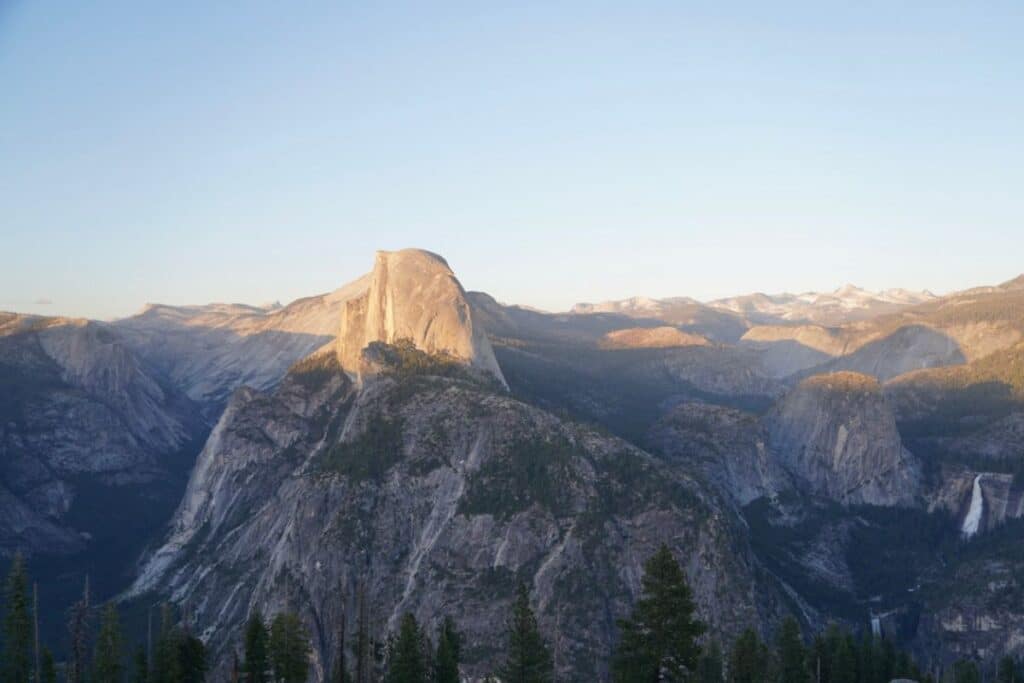
Planning A Trip? Use Our Favorite Resources Below!
Accommodations Tours/Experiences Flights Car Rentals
Yosemite National Park One Day Itinerary
When we did this trip, we stayed at the Doubletree in Fresno the night before.
We had about a 2 hour drive to get all the way to Yosemite Valley in the morning.
I recommend staying as close as possible to Yosemite Valley so you can get your day started before it gets crowded.
We stayed in Fresno just because we were driving up from Anaheim the night before.
It was the easiest stopping point for us without having to drive too late into the night.
1. Parking in Yosemite Valley
I cannot pinpoint exactly where we ended up parking, but it was somewhere along the bus route near the Housekeeping Camp and Curry Village.
I just remember driving past the Yosemite Chapel and turning right.
You can drive further toward the center of Yosemite Valley Village, but we were worried there wouldn’t be anymore parking available.
Honestly, as long as you park somewhere along the bus route, it doesn’t necessarily matter where you park.
There is a ton of parking, so the most important thing is just to find a spot anywhere.
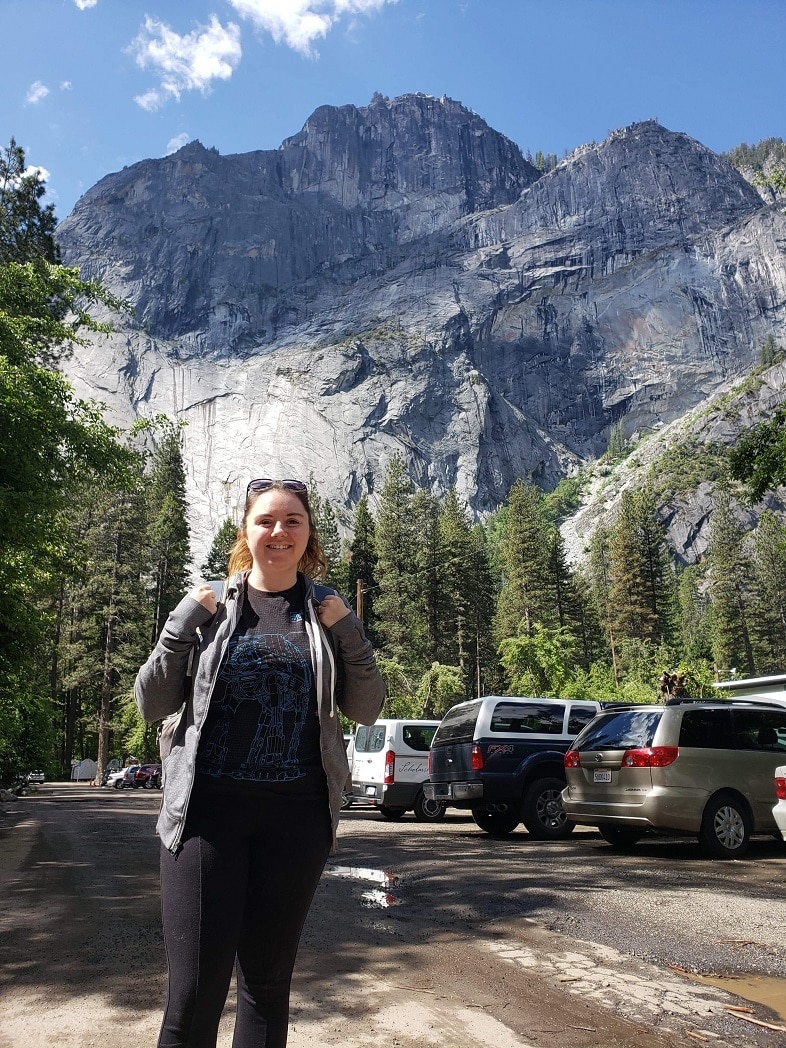
2. Vernal Fall
We took the shuttle to stop #16: Happy Isles .
The Vernal Fall hike at this stop is rated as moderate and is about 1.6 miles roundtrip just to the Footbridge.
You can continue after that and take the steps up to the top of Vernal Fall , but that will make your roundtrip hike 2.4 miles .
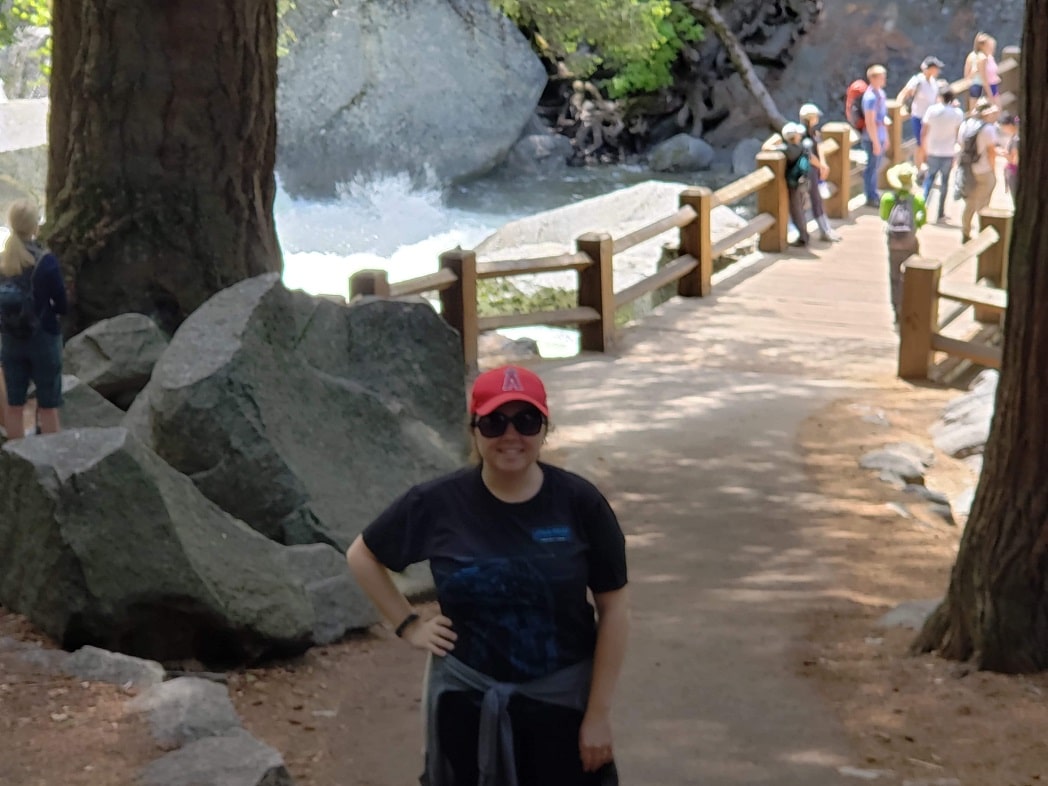
That part is considered strenuous and has an elevation gain of 1000 feet.
We didn’t do it because the whole rest of the trail leading up the Footbridge was pretty much an incline THE. ENTIRE. WAY.
It was exhausting!
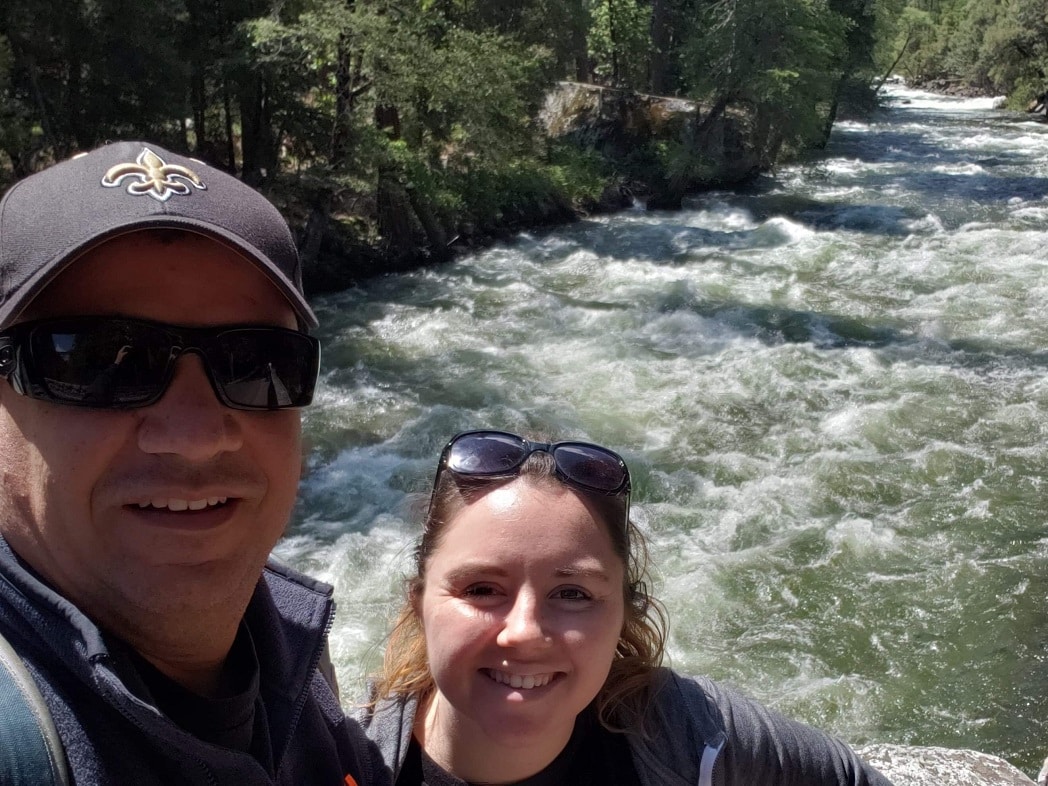
We had to make a lot of stops along the way for water and to catch our breath.
The steps to the top of Vernal Fall looked really cool, but my legs were so worn out already that I just couldn’t get myself to do it.
Especially since this was only our first trail of the day.

On the plus side, the trail back to the bus stop is downhill the entire way.
You’ll want about an hour or hour and a half to do the trail to the Footbridge and back.
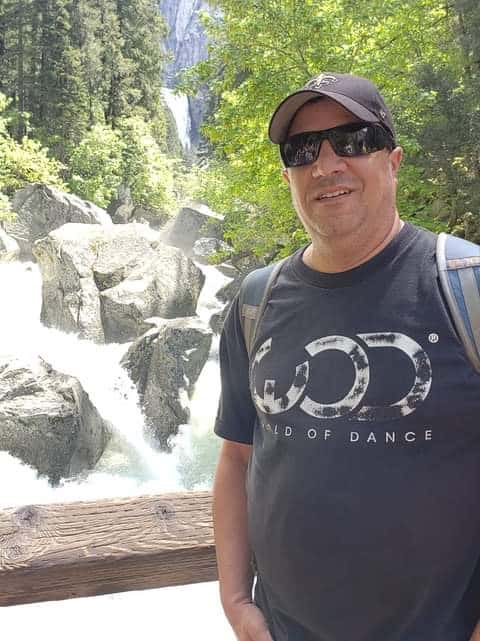
3. Mirror Lake
Next, we took the shuttle to stop #17: Mirror Lake Trailhead .
This trail is 2 miles roundtrip if you take the trail just to the lake and back.
If you want to walk the loop around the lake , it’ll extend your hike to a total of 5 miles .
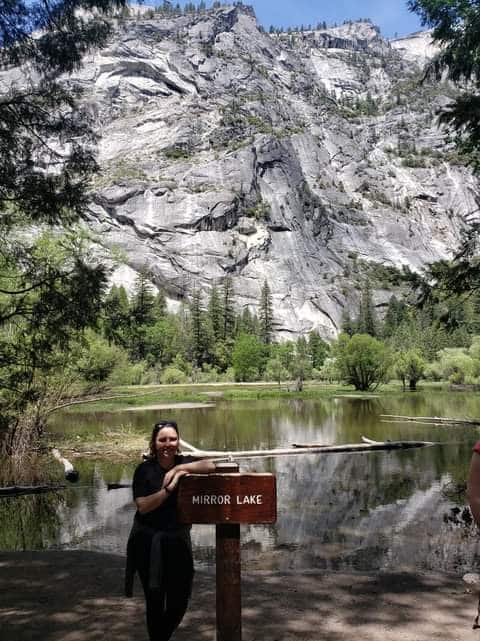
We took the trail about a quarter of the way around the lake before returning back.
Most of the year it doesn’t have much water, but Spring and early Summer will be your best chances at seeing any water.
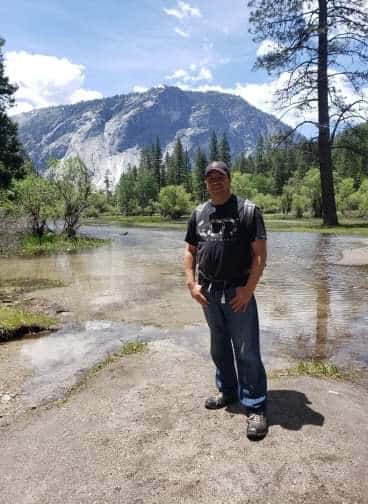
One of my favorite parts of this trail were the areas near the rocks that were shaded.
We would come across some clusters of rocks that had a cool breeze passing through them and it felt great after being out in the sun.
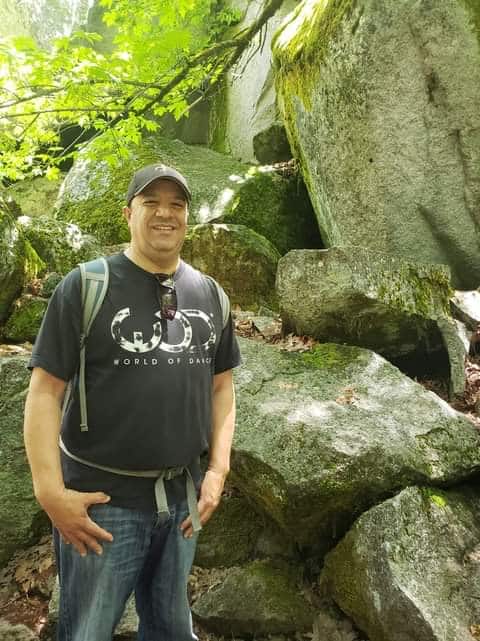
4. Lunch at The Ahwahnee Dining Room
The Ahwahnee Dining Room is a great place to stop for lunch.
It is stop #3 on the shuttle route.
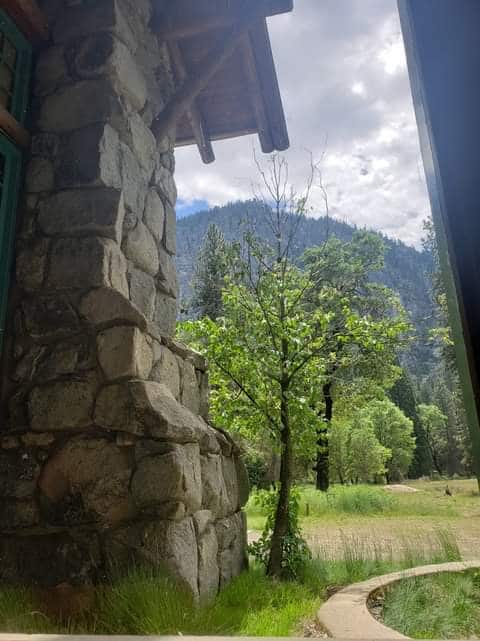
Lunch is casual without any dress code, so you can definitely eat here in-between your hikes.
I’m not sure what we ended up sharing as our meal, but below is the massive dessert we shared!
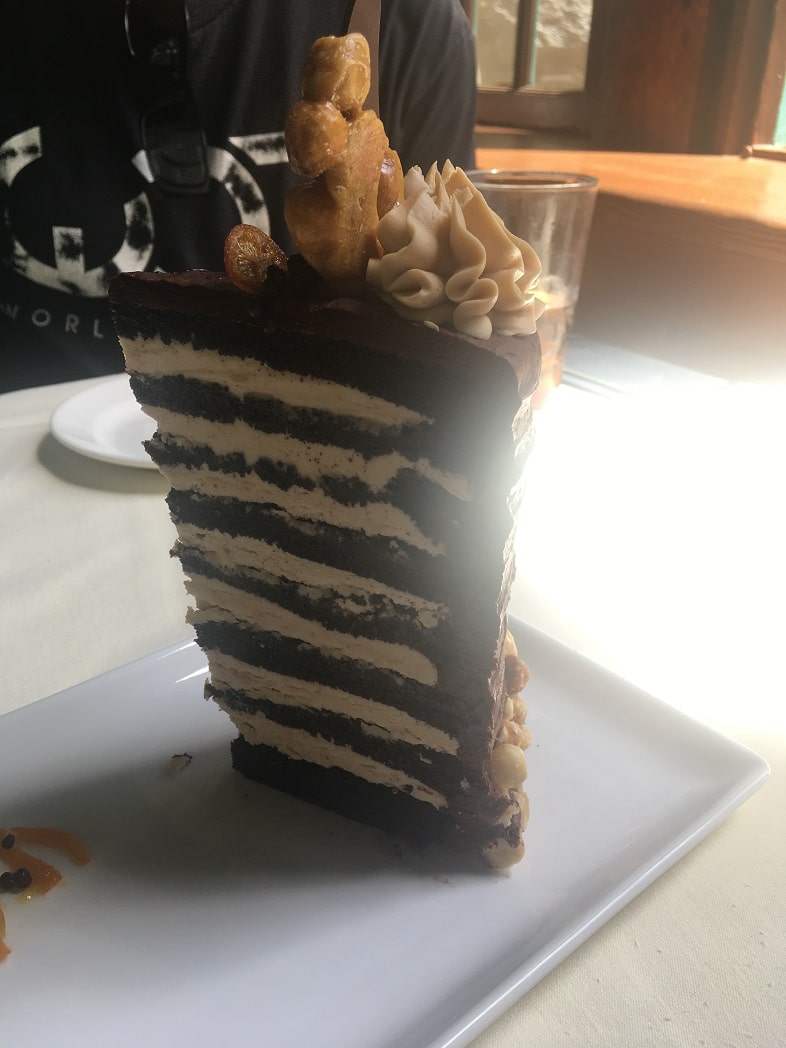
5. Lower Yosemite Falls
Our next stop was shuttle stop #6: Lower Yosemite Falls .
This hike is an easy 1 mile loop that only takes about 30 minutes or so.
The trailhead of this hike is one of my favorite waterfall views in the whole park.
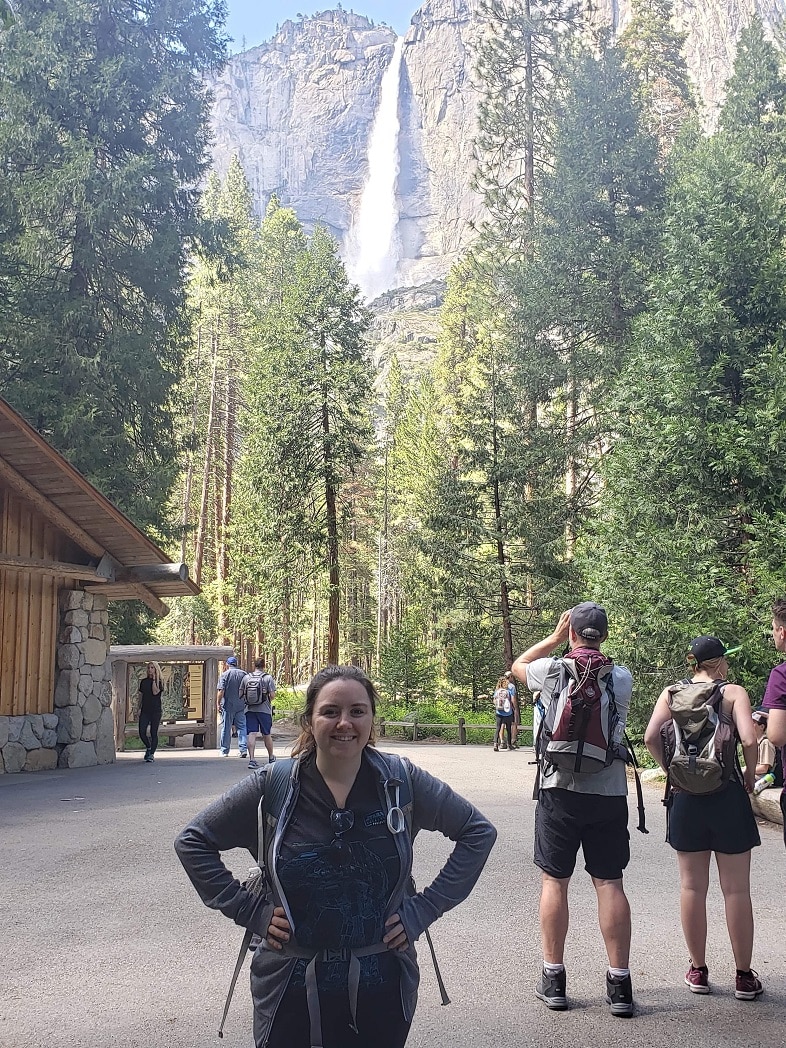
Lower Yosemite Falls is part of North America’s largest waterfall and makes up the last 320 feet of the Falls.
You may get wet, especially if you’re visiting in Spring/early Summer.
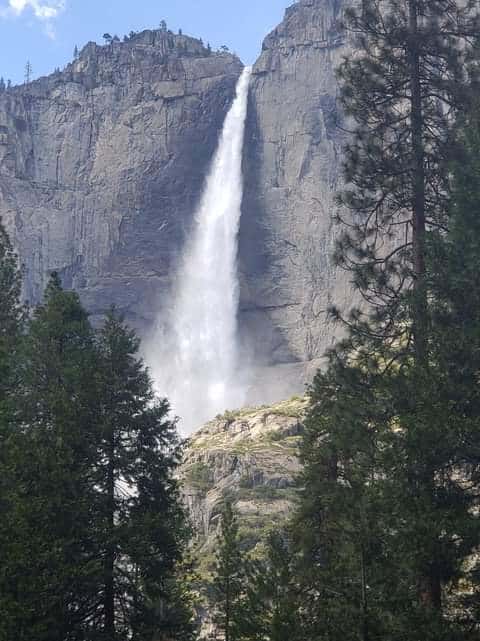
We brought rain jackets with us just in case.
We did get wet at this one, but not nearly as much as we did at the next waterfall.
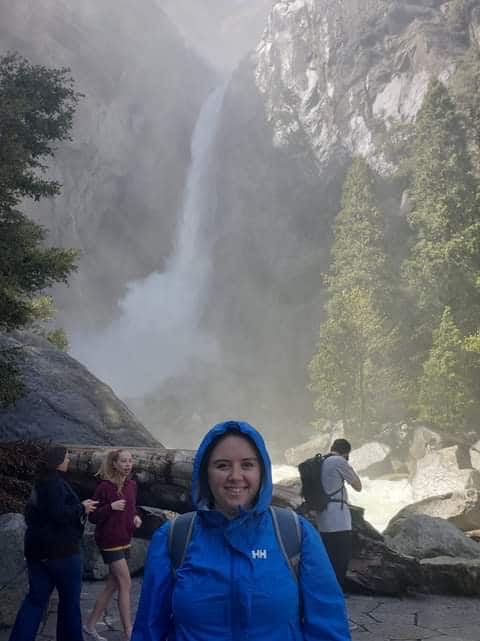
6. Shuttle Back to Parking in Yosemite Valley
After this hike we took the shuttle back to our car since the rest of the trails are not on the shuttle loop.
You’ll need to do the same if you’re following the rest of the itinerary.
7. Bridalveil Fall
Bridalveil Fall is about 6 miles West of the center of Yosemite Valley, so it is a quick drive no matter where you parked in that area.
On this hike, everyone was soaked.

I would imagine it was at its peak considering how far all the water was traveling, but I don’t know for sure.
Water was just spraying everywhere in all directions.
It was super cool and since we were prepared to get wet, we were able to enjoy the trail more.
It’s only about a half-mile roundtrip, so you can be in and out of there in less than 30 minutes easily.

8. Tunnel View
Arguably one of the most famous spots in all of Yosemite National Park , Tunnel View is an absolute must-do photo stop.
It has a small parking lot, but cars are constantly coming and going, so it shouldn’t take too long to find a spot.
It is only about 1.5 miles West of Bridalveil Fall , so it’s just a few minutes drive.
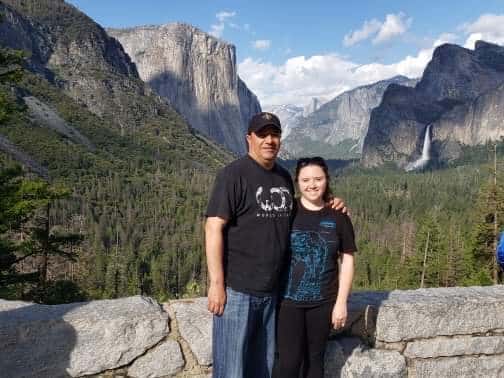
9. Glacier Point
Glacier Point is about an hour drive from the Yosemite Valley area, mostly just because of all the twists and turns.
It is only open seasonally, usually late May through October or November .
Glacier Point is really cool because it overlooks the whole park from above.
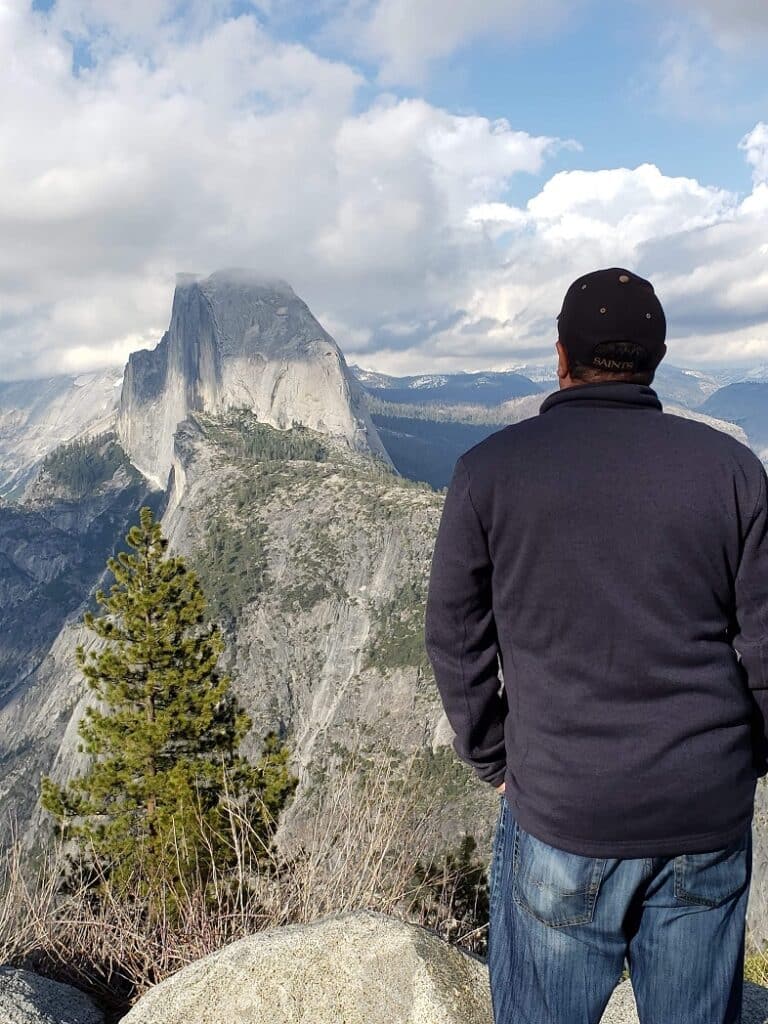
It is much colder up there than in the rest of the park, so you’ll want to bring a coat.
The view was so clear that all of our photos look like the background is fake!
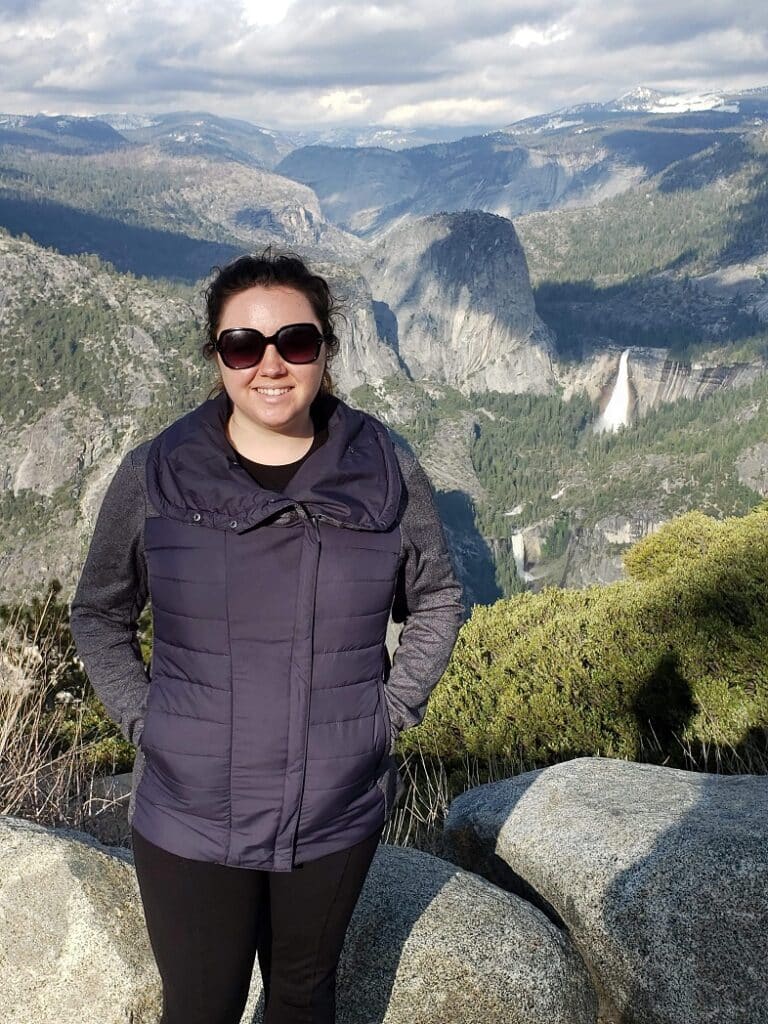
10. Mariposa Grove
The final stop of the day!
The drive back down from Glacier Point is about another hour .
From the bottom the Glacier Point drive, Mariposa Grove is another 20 miles , or about 30 minutes .
Mariposa Grove is the largest grove of Giant Sequoias in Yosemite , with over 500.

It has been part of protected land since President Lincoln signed the legislation back in 1864.
The shortest trail is the Big Trees Loop Trail where you will see the Fallen Monarch on a .3 mile loop .
To see more of the grove, I recommend taking it further and following the Grizzly Giant Loop which is about 2 miles roundtrip .
This trail has the Bachelor and Three Graces , the Grizzly Giant , and the California Tunnel Tree .
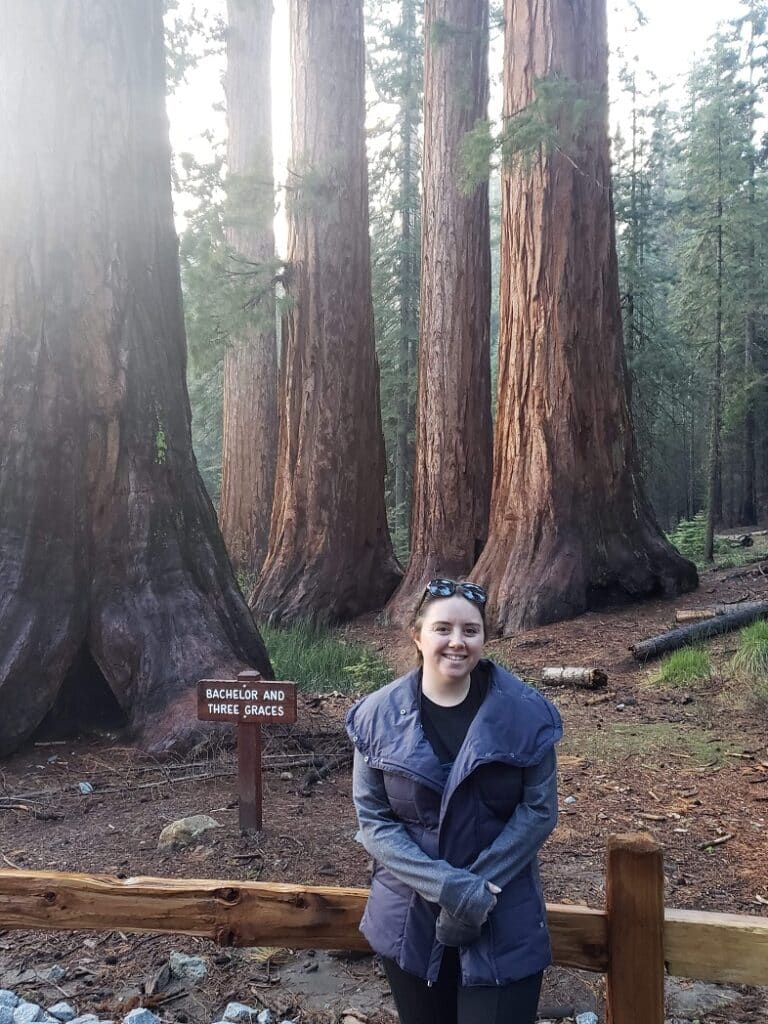
At this point for us it was getting dark so we only went as far as the Grizzly Giant.
We knew we could come back at any time to see anything we missed, so we didn’t mind.
From there we had about a 5 hour drive home, but of course you can always stay in the area and check out more of the places we missed on this one day itinerary.
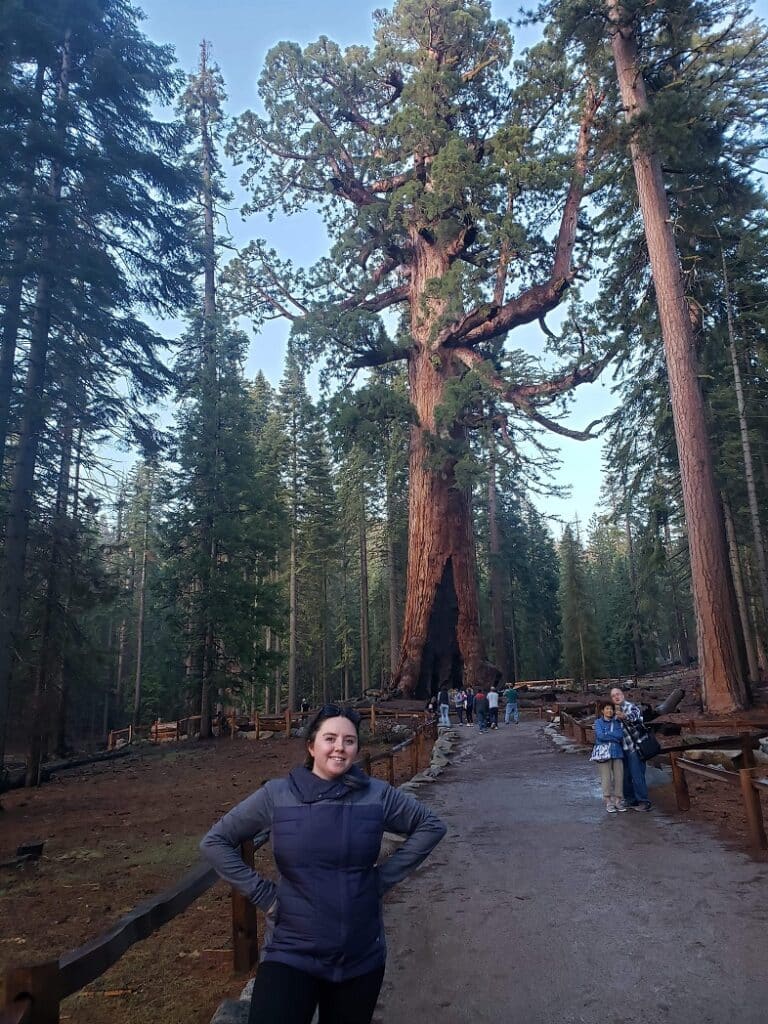
Where To Stay When You’re Visiting Yosemite National Park
If you want to stay inside the park, here is what we recommend.
✔️ Camping At Yosemite National Park
The best way to enjoy Yosemite is camping in the park.
There are a variety of tent camping, group camping, and RV camping sites spread all throughout Yosemite Valley.
Different campgrounds have different amenities and are open at different times throughout the year, so it’s best to browse your options and availability to decide the best campground for you.
Click Here To Book Your Campground At Yosemite National Park Today!
✔️ Yosemite Valley Lodge
Staying at the lodges in National Parks is always the best way to go, but they sell out well in advance.
So if you want to stay here, you’ll want to plan your trip well in advance and try to visit in a shoulder season or week day to increase your chances of being able to get a room.
Click Here To Book Your Stay In Yosemite Valley Lodge Today!
Frequently Asked Questions About Yosemite National Park
Planning a trip to Yosemite National Park can be overwhelming because there’s just so much information to take in.
These are the most frequently asked questions we see about visiting Yosemite.
✅ Can Yosemite Be Done In 1 Day?
Yes, it is possible to see Yosemite in one day.
However, you will need to be well-organized and have a plan in place.
✅ How Many Days In Yosemite Is Enough?
The number of days you need in Yosemite depends on how much you want to see and do.
If you just want to drive around and see the main attractions, you can do it in one day.
If you want to hike, camp, and explore the park more deeply, you will need more time.
✅ Can You Just Drive Around Yosemite?
Yes, you can just drive around Yosemite.
There are many scenic roads in the park, and you can easily spend a day or more just driving and enjoying the scenery.
Some of the most popular scenic drives in Yosemite include:
✓ Yosemite Valley Loop
This is the most popular scenic drive in the park.
It takes you through the heart of Yosemite Valley, past many of the park’s most popular attractions, such as Yosemite Falls, Half Dome, and El Capitan.
✓ Glacier Point Road
This road takes you to Glacier Point, which offers stunning views of the park.
✓ Tioga Road
This road takes you to the high country of Yosemite, where you can find towering granite cliffs, alpine meadows, and sparkling lakes.
If you are short on time, you can also take a shuttle bus around the park.
The shuttle buses are a great way to see the park without having to worry about parking or traffic.
More Great National Parks To Visit In California
California is home to 9 of America’s National Parks.
Pair them for an epic California road trip or if you’re a local, take a weekend to visit each one.
Death Valley National Park One Day Itinerary
Death Valley is in the middle of the desert and is home to the lowest elevation in the US.
It’s an easy visit from Vegas or from Southern California.
I recommend visiting in the shoulder season so it’s not 115+ degrees outside when you visit.
Some of the original Star Wars scenes were filmed here too!
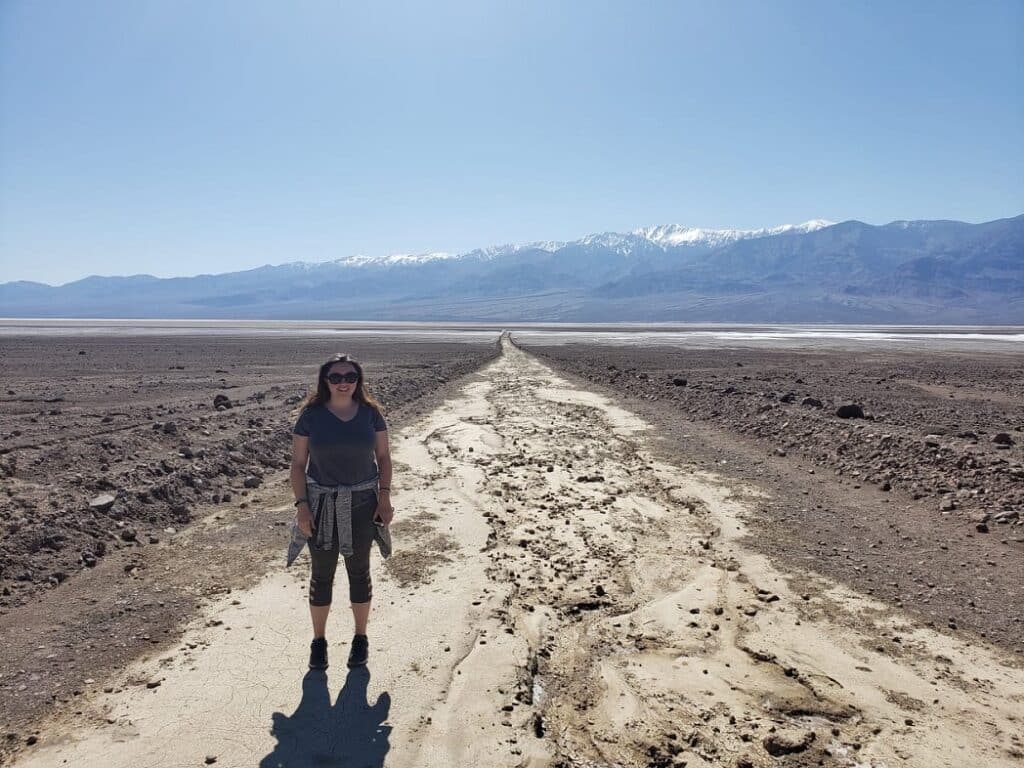
Channel Islands National Park Santa Cruz Island Day Trip
Santa Cruz Island is one of the most visited islands in the Channel Islands.
It’s an easy boat trip from Ventura Harbor Village.
You schedule your trip in advance for arrival and departure times on the island and you can even choose to stay and camp overnight on the island if you like.
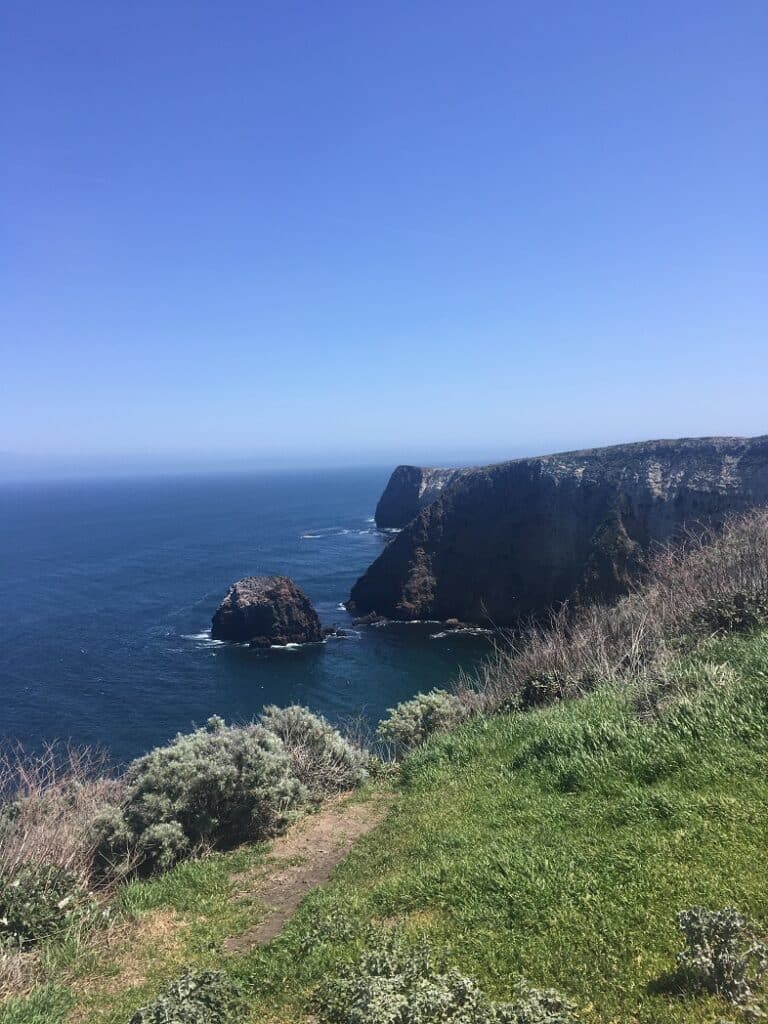
Channel Islands National Park Santa Rosa Island Day Trip
Santa Rosa Island is a bit further out, but can still be visited on a day trip from Ventura.
It takes a little longer to get there and back, but that’s more opportunities for whale watching along the way.
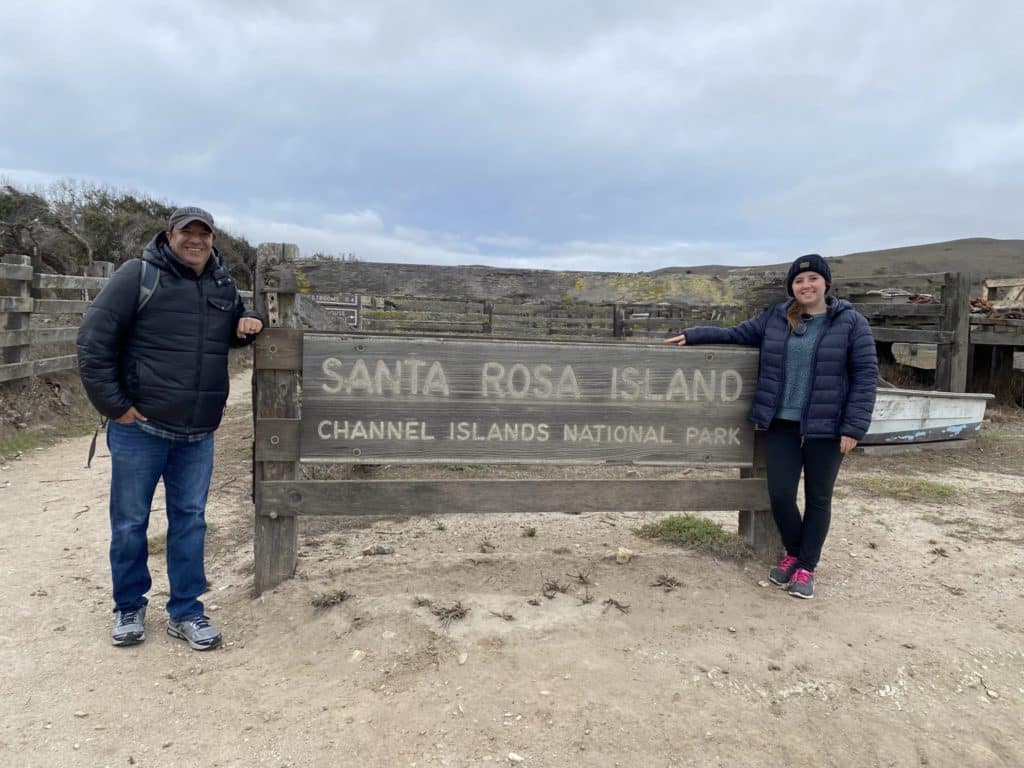
Joshua Tree National Park Day Trip Itinerary
Joshua Tree is just outside of Palm Springs and is best paired with a trip to the whole area.
It’s one of the Dark Sky Parks where you can see virtually everything in the sky at night due to its distance from any neighboring cities.
But if you’re visiting just for the day, we have an easy itinerary that takes you through the whole park, ending with the perfect sunset where you can see all the way to Mexico.
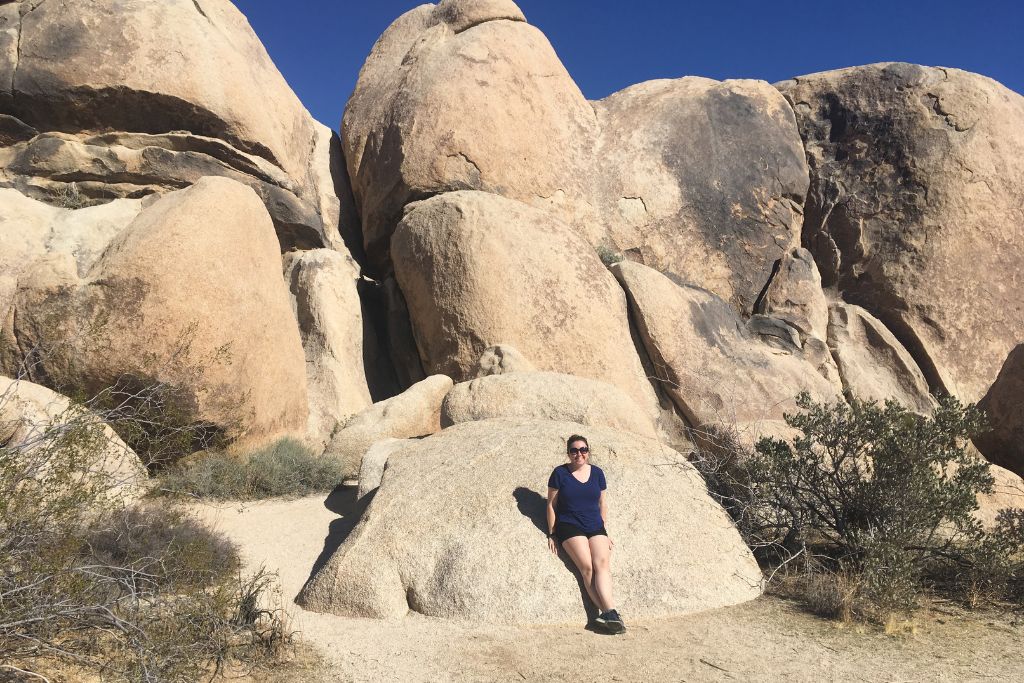
Sequoia and Kings Canyon National Park One Day Itinerary
Sequoia and Kings Canyon are technically 2 separate National Parks, but they’re connected to each other, so most visitors will see both when they visit.
You’ll see some of the oldest and tallest trees in the US and venture down into the valley into a completely different environment.
Lunch at the lodge is also a great experience.
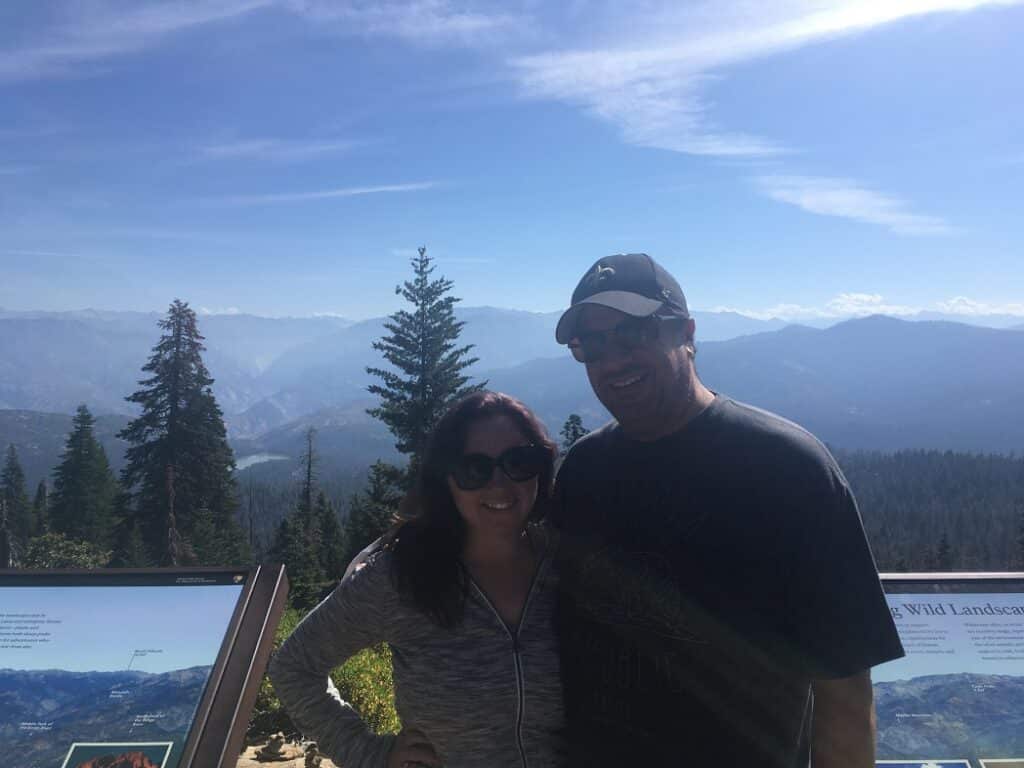
Lassen Volcanic National Park One Day Itinerary
Lassen Volcanic National Park is a relatively unknown and severely underrated national park in Northern California.
We paired our trip here with visits to Lake Tahoe and Reno.
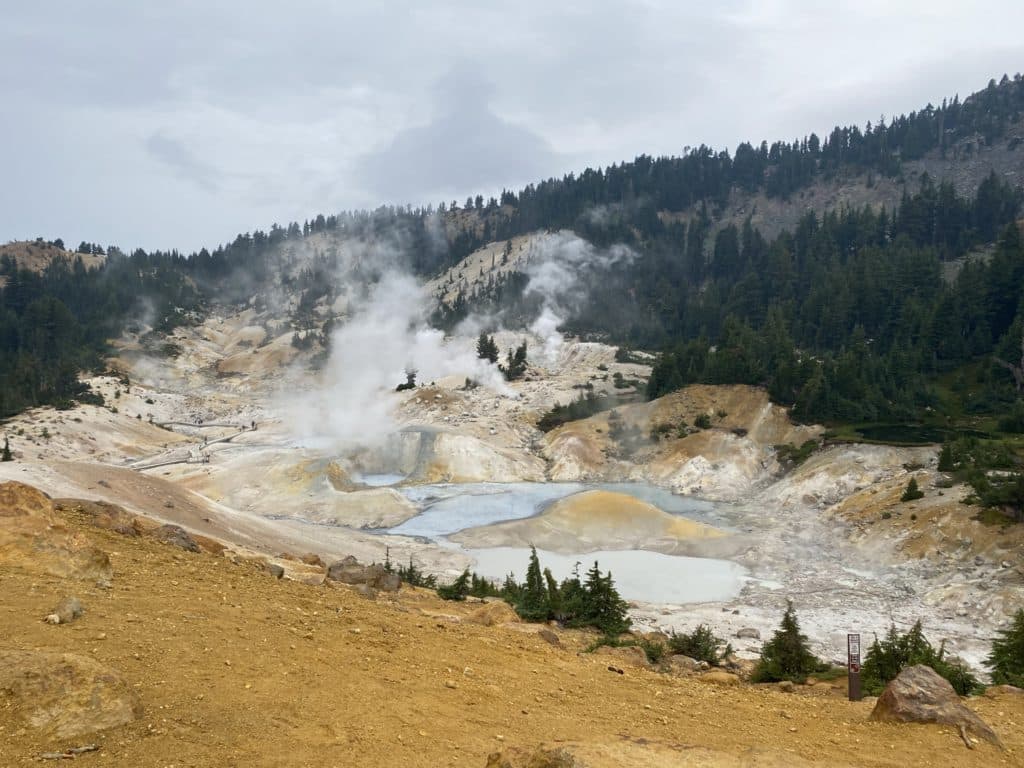
Pinnacles National Park One Day Itinerary
Pinnacles is in Central California and it’s known for it’s caves that you can hike through during certain times of the year.
It’s all dependent on not disturbing the bats!
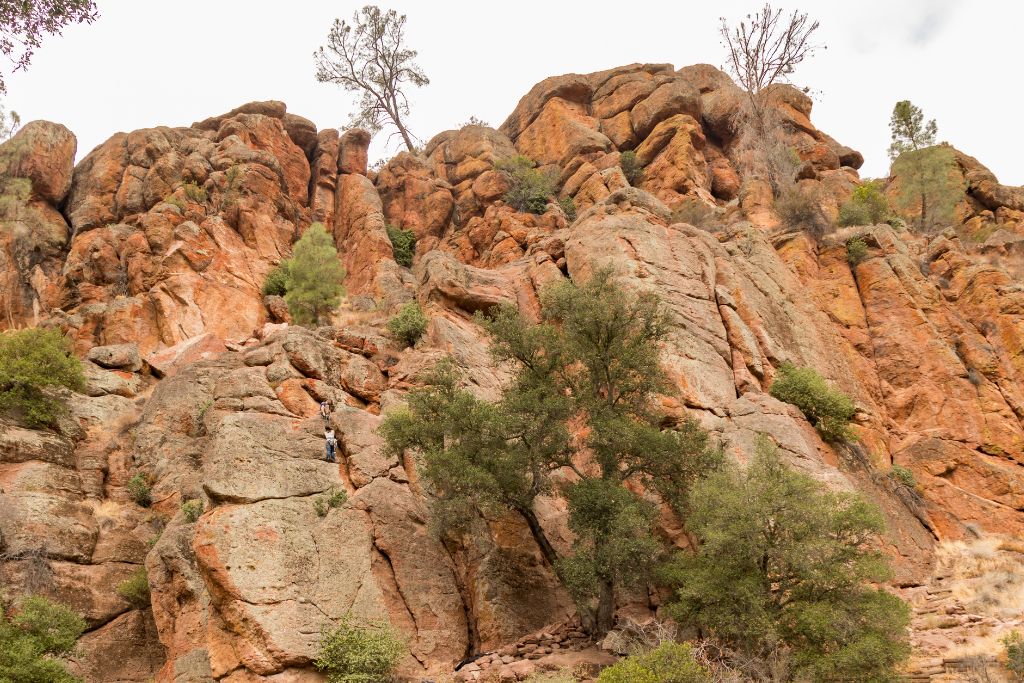
Redwood National Park One Day Itinerary
The Redwoods are along the Northern California coast and are home to some of the largest and tallest trees in the world.
This park is also made up of a bunch of state parks, so there is so much to explore.
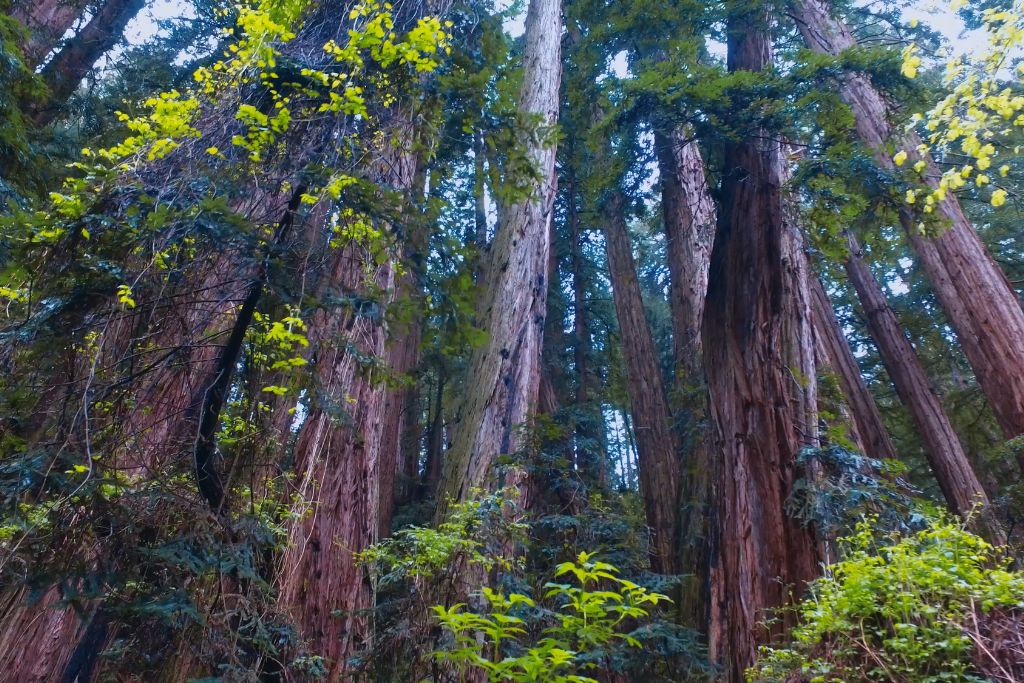
Check out more National Park itineraries around the US.
Conclusion: Yosemite National Park One Day Itinerary
This Yosemite National Park one day itinerary takes you through all the highlights in the park in a short amount of time.
It’ll definitely be a long day, but none of the hikes are too strenuous or too long at a single time.
Pin This For Later!

Eva is the founder and writer behind Discovering Hidden Gems. She spent a decade working in and studying the hospitality and tourism industry with experience in theme parks, hotels, guided vacation sales, and special events. In addition to sharing her expertise about traveling in the US, she offers mini courses on saving money on travel and traveling more for less.
Similar Posts

19 Fantastic Things To Do In Los Angeles This October (2024)

Big Bear Lake Summer Weekend Getaway Itinerary 2024: The Ultimate Guide

6 Best Cross Country Routes East To West (2024)

14 Best Things To Do On Cannery Row – Monterey, CA (2024)

The 44 Best Things To Do in Dayton In Fall (2024)

8 Best Winery Day Trips Around Los Angeles (2024)

Plan Your Trip
Making mariposa memorable, plan a trip to yosemite.
As a world-famous destination drawing millions of visitors each year, Yosemite Mariposa County features landmarks such as Yosemite Valley, the Mariposa Grove of Giant Sequoias, the towering Upper Yosemite Falls as well as the beauty and charm of the areas outside the park. Given all that, it’s no surprise so many people plan a trip to Yosemite year after year. Here, we’ll show you the top tips for traveling to Yosemite Mariposa County, including what to pack, making reservations, traveling responsibly and more.
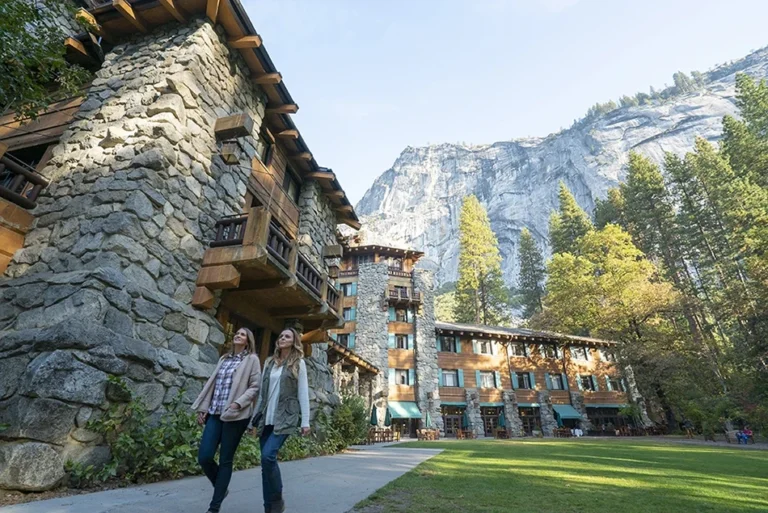
With enough advanced planning, finding the ideal place to stay on your next trip to Yosemite Mariposa County won’t be difficult. Choose from widely varying accommodations including resorts, vacation rental cabins, bed and breakfasts as well as camping. In other words, Mariposa County offers everything between “roughing it” and traveling in VIP style. Popular places to stay include Curry Village , Yosemite Valley Lodge and the picturesque Ahwahnee Hotel .
If you want to stay inside the park, the sooner you book your accommodations, the better. Lodging inside the park is limited, but is plentiful in greater Mariposa County. Planning ahead is never a bad idea when it comes to a Yosemite trip.
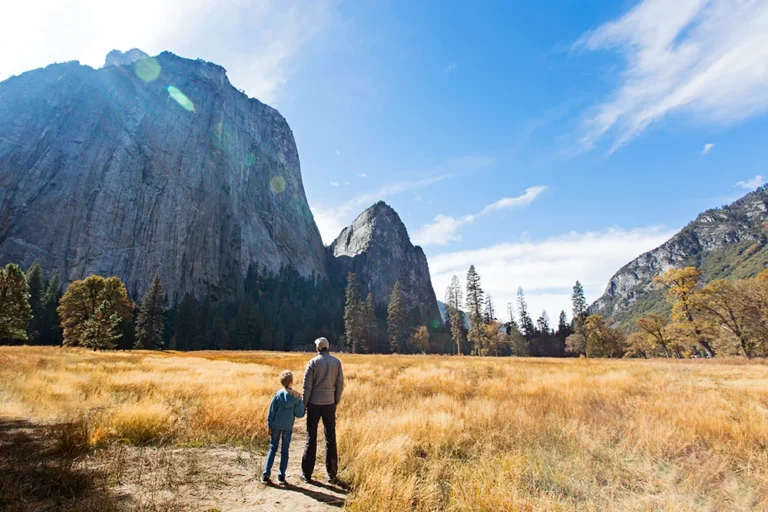
A road trip to Yosemite Mariposa County is a life-changing experience in the best possible way. Still, it’s important that visitors avoid changing Yosemite while here! Below are some tips visitors can follow in order to keep wildlife wild and Yosemite beautiful for generations to come.
- Avoid feeding wildlife
- Dispose of trash properly (leave no trace)
- Drive carefully and watch for bears
- Consider taking public transportation whenever possible
- Keep your distance from animals
- Avoid moving sticks and rocks in rivers
- Book direct to support local businesses
- Consider voluntourism
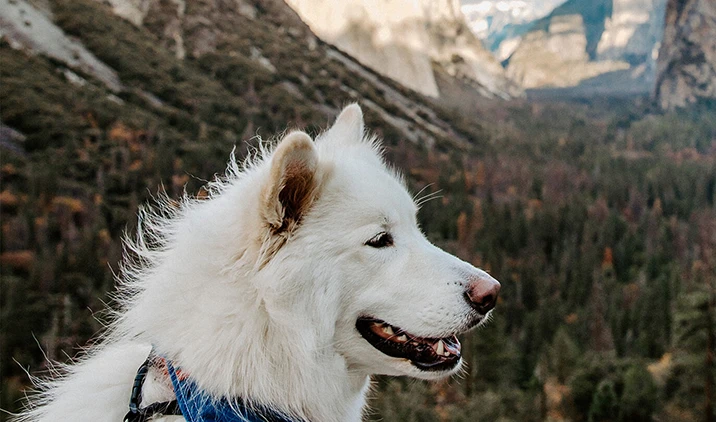
Furry friends have the power to make any trip instantly better. Still, it’s critical to know where pets are appropriate and where they’re best kept at home. When you visit the park , you’ll notice certain areas such as campgrounds and picnic areas are very dog-friendly. On the other hand, many hiking trails and most shuttle buses do not allow pets for their safety. Also, many accommodations including all in-park hotels prohibit pets inside the property’s buildings. Before you plan your trip , check out our Dog Lover’s Itinerary for a better sense of how you and your pup can have a great time in Mariposa County.
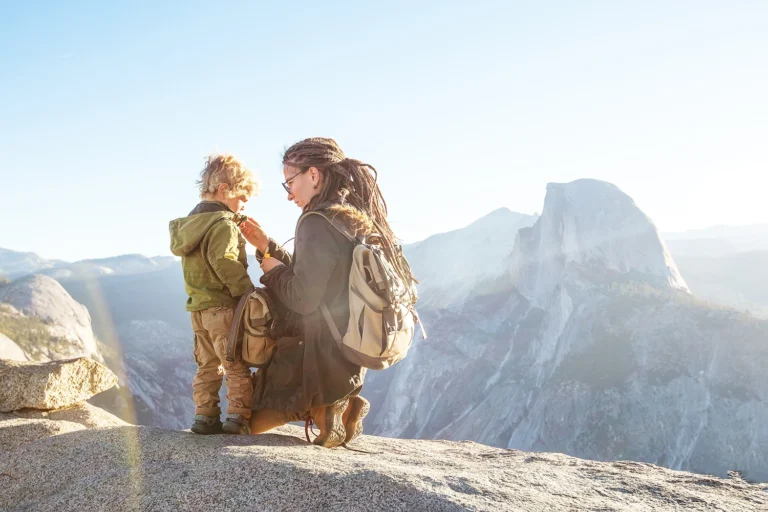
A word of advice: regardless of the time of year you’re visiting Yosemite Mariposa County, be prepared for anything, weather-wise. Generally, temperatures are warm during the long days of summer, but it has been known to snow at all times of year around here. When you’re out hiking or exploring, temperatures can drop significantly and suddenly, especially in the cooler seasons. Snow is virtually guaranteed during at least part of winter, with the conditions usually necessitating closures to certain roads for the better part of the season. Safe to say, whether you’re taking a day trip to Yosemite or backpacking for weeks, be sure to pack sunscreen, maps or other navigational tools, bring extra food and wear layers.
FAQs For Planning a Trip to Yosemite
Generally, year-round, with the entrances open 24 hours a day. That said, weather can sometimes cause closures to the park or the roads leading into it. Tioga Pass on the eastern side of the park is closed from October through May most years. Call (209) 372-0200 to check road conditions just prior to your visit.
Yes. Get maps, information, souvenirs and other trip tools at the following locations: Yosemite Valley Visitor Center & Bookstore Yosemite National Park CA 95389 Phone: (209) 379-2646
Wawona Visitor Center at Hill’s Studio (May to October) Wawona, CA 95389
Tuolumne Meadows Visitor Center (approximately late May – late September, conditions permitting) Tuolumne Meadows, 95389
Mariposa County Visitor Center 5158 State Highway 140 (corner of Highway 140 and 49) Mariposa CA 95338 Phone: (209) 966-7081
Northern Mariposa County Visitor Center 10301 State Highway 49 Coulterville, CA 95311 Phone: (209) 878-3015
Yosemite Conservation Heritage Center 9006 Southside Dr. Yosemite Valley, CA 95389
You can get around Yosemite Mariposa County by car, shuttle bus, tour bus, tram, on foot through hiking trails , by public transport and most other conventional ways of moving around an area. For more information about Yosemite public transportation, call (877) 989-2787, or visit http://yarts.com/ .
Yosemite National Park has four main entrances, including Tioga Pass in the east; South Entrance (southern end of park); Big Oak Flat and Arch Rock Entrance (western side). Note that Tioga Pass is generally closed from October through May (or even later) each year due to road conditions.
Following are the costs to enter the park: Private Non-commercial Vehicles – $35 Motorcycle – $30 Bus Passengers, Horseback, Bicyclists, and Persons on Foot – $10 Annual Yosemite Pass – $70 or America the Beautiful – National Parks & Federal Recreational Lands Annual Pass (Good for 1 year from purchase date) – $80 Senior Pass (a lifetime pass for US citizens 62 years and older): one-time issuance fee – $80 or $20 for a year.
Good news! We have a thorough list of itineraries for every type of traveler. From those that walk in John Muir’s footsteps to white-water action on the Merced to touring such iconic landmarks as Glacier Point , Tuolumne Meadows , Bridalveil Fall , Vernal Fall , Half Dome and more. Browse some of our favorite Yosemite itineraries .
We use cookies to help us improve, promote, and protect our services. By continuing to use the site, you agree to our cookie policy. More Information
- Search Please fill out this field.
- Newsletters
- United States
- More to Explore
Yosemite Trip Planner: Weekend Getaway Guide
How to Spend 2 to 3 Days in Yosemite
:max_bytes(150000):strip_icc():format(webp)/betsy-hikey-1000x1500-56a386bf3df78cf7727ddc41.jpg)
TripSavvy / Jess Macdonald
Yosemite is one of the country's oldest, best-known and most-photographed national parks. It's a California icon, but I'm always surprised at how many people, including friends who have lived in California their entire lives have never been there.
From much of the state, you can get a taste of Yosemite in a weekend, so why wait? This Yosemite trip guide will help you plan a two- to three-day getaway that takes in all of the must-see sights.
Why Should You Go? Will You Like Yosemite?
Yosemite National Park covers a large area in the mountains, but you can limit a short visit to just the Yosemite Valley and areas nearby.
Yosemite is popular with nature lovers, photographers, and hikers. Families also enjoy camping at Yosemite and in the off-season, you can attend some fun food and wine events.
Best Time to Visit Yosemite
Yosemite weather is best in spring and fall, and it's less crowded then. To learn more about the best time to visit Yosemite, get more information here .
Frankly, this beloved national park can be more crowded in summer than Black Friday at the local big box store. If you want to take a summer trip, think about staying outside the valley. Or spend your time in cooler, less-crowded spots like Tuolumne Meadows.
If Time Is Short, Don't Miss These Views
Glacier Point : Glacier Points views have inspired photographers from Ansel Adams to Moose Peterson. It's a short walk from the parking lot to vista points that you might otherwise have to hike hours to reach. To get there, take Hwy 41 south from the Valley and watch for the turnoff.
Tunnel View: You can see El Capitan, Half Dome, and Bridalveil Fall all at once from this viewpoint on Hwy 41 south of the valley. The parking area is just before you get to the tunnel.
5 More Great Things to Do in Yosemite
There's a lot to do at Yosemite, and much of it is free after you pay the entrance fee. These are the next stops to make
- The Yosemite Valley is where you'll find Half Dome, El Capitan, and many other famous sights. You'll enjoy it a lot more if you stop and walk, even if it's only a little distance from the road.
- Take a Hike or opt for a nice, long walk on some easy Yosemite day hikes . For something more challenging, there's a complete list of hikes at the National Park website .
- Tuolumne Meadows is a great place to head on a hot day when the park is crowded.
- Take a Ranger-Led Tour: Check the Yosemite Today newspaper or ask at the visitor center to find out about tours during your visit.
- Watch the Sunset: From Tunnel View, you'll get a view of the entire Yosemite Valley. In the late afternoon, hang around to watch the sunlight play across Half Dome and El Capitan. Linger after the sun goes down and you see a rare red-tinted, alpenglow, which will be in the east shortly after the sun sets.
Annual Events You Should Know About at Yosemite
- Bracebridge Dinners have been an annual Christmas tradition at Yosemite since 1927. The hotel dining room transforms into a 17th-century English manor set up for a holiday feast, complete with entertainment. To have your pick of dates, make reservations the previous February.
- The Ahwahnee sponsors special events all year long, including wine and chef's events . Most of them require reservations.
Tips for Visiting Yosemite
- For the most beautiful approach to Yosemite , take CA Hwy 140 through Merced and Mariposa. The drive along the Merced River is a good warm-up for sights in the Valley.
- Get around Yosemite like a pro by downloading an app. Find out about the different Yosemite apps available here .
- Don't bring too much food. Most hotels don't allow it in your room (particularly in the lodge). Because of bears in the area, it is not safe to leave it in the car. The best thing to do is to buy what you need at one of the stores and eat it right away or choose one of the several places to eat in the park.
Yosemite's Best Bites
The Ahwahnee dining room is the park's most famous place to eat, but there are plenty of other options. At the lovely dining room at Yosemite Lodge, the quality of the photography displayed on the walls threatens to upstage the dishes on your plate. The hotel serves Sunday brunch featuring nine buffet stations, but it's so popular that reservations are a must during busy times.
If the weather is nice, you can pick up makings for a picnic meal at Degnan's Deli in Yosemite Village.
Where to Stay at Yosemite
The most important thing to do when planning your Yosemite trip is to make your hotel reservations as early as possible. In fact, make them even if you aren't sure yet and pay attention to cancellation policies in case you change your mind.
To keep costs down, think "camping." That doesn't mean you have to sleep on the ground, fight off bears, and do battle with uncooperative tent poles, though. It's possible to do Yosemite on a budget .
Where Is Yosemite?
Yosemite is 188 miles from San Francisco, 184 miles from San Jose, 174 miles from Sacramento, 212 miles from Reno, NV and 310 miles from Los Angeles. The nearest airport is in Fresno (FAT).
Related Articles
More related articles.

The Ultimate 3 to 4 Days in Yosemite Itinerary
Last Updated on January 11, 2024
by Sarah Dittmore
Disclaimer: This article contains affiliate links. That means if you click a link and make a purchase, we may make a small commission. As an Amazon Associate we earn from qualifying purchases. For more information, see our privacy policy.

Between towering mountains, emerald pines, and breathtaking waterfalls, it’s no wonder Yosemite is one of the most beloved National Parks in the United States. However, with so much to see and do in this nearly 750,000-acre park, planning a Yosemite itinerary can be a behemoth of a task.
Planning the perfect trip to Yosemite is all about striking the balance between seeing as much as possible, and still leaving time to soak in the park’s natural beauty. With 3 to 4 days in Yosemite, you’ll get to see a ton of the park without feeling rushed.
Table of Contents
How Many Days in Yosemite?
In general, there’s no such thing as too much time in Yosemite. But that could be the native Californian in me talking.
Determining how many days to spend in Yosemite depends a lot on what kind of traveller you are. For those who just want to say they’ve seen it, 1 or 2 days will be plenty. Backpackers who want to explore the more secluded multi-day Yosemite hikes will need a week, at least.
But for most visitors, 3 to 4 days in the Park is perfect. 3 days in Yosemite will allow you to see all the major sites and get in some hikes and stargazing. Allowing yourself 4 days gives you time to check out the more famous, and challenging, Half Dome hike, or explore the secluded Tuolumne Meadows.

Getting To & Around Yosemite
If you’re coming from Southern California, check out our guide on the best LA to Yosemite road trip . This route takes you to the eastern entrance, or the Tioga Pass Entrance, of the park, which is also where you’ll enter if you’re coming from East of California.
In addition, there’s the South Entrance (the more traditional entrance for those coming from Southern California), and two Western entrances: Big Oak Flat and Arch Rock entrance. Alternatively, if you’re coming from the Bay Area, check out our guide to the San Francisco to Yosemite road trip! This is also a great way to get to Yosemite.
No matter where you enter, it’ll cost you $35 USD to get an entrance pass, which is good for 7 days. If you’re planning to visit multiple National Parks this year, you might consider the America the Beautiful pass , which costs $80 USD and gives you unlimited access to all the National Parks for 12 months.
Once inside, the best way to get around Yosemite is via car. The park is pretty big, and the sites are spread out across the park, so having your own car will make the whole trip a lot smoother.
In general, Yosemite National Park is easy to navigate as everything is clearly marked and there are really only three main roads throughout the park.
If you need to rent a car for this trip, you can browse Rentalcars.com which aggregates prices across many providers. Alternatively, if planning a longer road trip and wanting your own accommodation, you can rent an RV or campervan from Outdoorsy.

If you don’t have your own car or don’t want to deal with the parking (which, to be fair, can get chaotic), the park shuttles are a great alternative.
They serve all the major sites throughout the park, are completely free, and run from 7am to 10pm. Depending on what time of year you visit, there are additional seasonal shuttles that take you to some of the harder-to-reach spots, like El Capitan shuttle and the Tuolumne Meadows Shuttle.
If you’re visiting during the summer, when Yosemite is its busiest, I recommend a mix of the two. Having a car is great for getting to and from your campsite or lodge, but the shuttles will help you avoid crowded parking lots and the not-infrequent traffic jams.
Keep in mind, if you are traveling in summer, that Yosemite lodging (both campsites and lodges) often sell out a year in advance, so planning your Yosemite National Park itinerary and booking everything early is a must.
You can also book multi-day tours to Yosemite from San Francisco such as this 3-day camping adventure or this 2-day tour if you want all your transport organised in advance.

3 to 4-Day Yosemite Itinerary
The best itinerary strikes the perfect balance between nature and tourism. There are plenty of hikes and adventures to be had in Yosemite, but there’s also a lot to be said for the guided tours and one-off activities like Yosemite’s monthly lecture series .
Whether you have 3 days or 4, the first 3 days of this itinerary remain the same, featuring a good balance of hiking, history, and simply enjoying Yosemite’s glory.
For those planning 4 days in Yosemite, day 4 features an optional hike that is more challenging, but one of the best hikes in Yosemite if you’re up for the work, or an alternative adventure in the eastern region of the park.
Day 1 – Tunnel View, Yosemite Valley & Glacier Point
Tunnel view.
The best way to start your Yosemite trip is with a visit to Yosemite Valley—the valley that rests in the middle of Yosemite’s striking mountains. On your way in, make sure to drive through Tunnel View.
This drive features the famous view of El Capitan, Half Dome, the Merced River and Bridalveil Fall that comes up whenever you look up photos of Yosemite. Whether you simply drive through or park your car and take some time to appreciate the vista, it’s a necessary stop as you enter Yosemite.

Valley Floor Tour
When you first arrive in Yosemite National Park, it can be overwhelming to try and take it all in at once. The Valley Floor Tour, one of Yosemite’s many guided trolley tours, is a great way to get your bearings and learn a little more about the park.
It’s a 2-hour tour in an open-air tram that brings you by all of Yosemite’s highlights while a park ranger teaches you about the history and ecosystem of the park. Tickets can be reserved ahead of time.
Rent a Bike
Now that you’ve gotten an overview of the park, take in the beauty of Yosemite at your own pace by renting a bike and going for a self-guided adventure. Bikes can be rented from Yosemite Valley Lodge, Curry Village, or Yosemite Village.
This is a good option to see the true scape of some giant sequoia trees and even enjoy the arch at Tuolumne Grove.
The Yosemite Valley Lodge Bike Stand is right near the Valley Floor Tour and a great starting point to a 5-mile route that takes you by Half Dome Village where you can pick up pizza for lunch before making your way back to the bike stand.
Historic Ahwahnee Tour
If pizza’s not your style, head over to the Ahwahnee Dining Room for a bite to eat in this historic lodge before getting a free, hour-long tour of The Ahwahnee.
It’s not easy to find information about this tour online as it’s a bit of an insider secret, but it will take you through the history of the land before Yosemite was converted into a National Park, how the building of the Ahwahnee Lodge came to be, and the unique architecture of the building itself.

Sunset at Glacier Point
To round out your first day in Yosemite, don’t miss sunset at Glacier Point. While famous for its sunrise view, this towering vista offers an equally incredible view of the sunset without the need to wake up at dawn.
If going by car, Glacier Point Road will take you right there. Otherwise, there’s a park bus that goes there from summer (usually Mid-May) through November. If visiting Yosemite in winter or spring, you’ll have to hike to Glacier Point, if the trail isn’t closed as well.
Alternatively, winter travellers can always return to Tunnel View, which offers a beautiful view of the sunset all year long.

Day 2 – Rock Climbing & Bar 1899
Half-day rock climbing adventure.
Yosemite is famous for its rock climbing, so whether you’re an avid climber or have never worn a harness before, there’s no better way to enjoy Yosemite than on the rocks.
The Yosemite Mountaineering School offers half-day rock climbing excursions for climbers of all levels and will tailor the experience to your comfort level. Classes range in price depending on what you’re looking for, but the basic “Welcome to the Rock” is perfect for new climbers.
The class is full of great views, adrenaline, and a chance to learn what makes Yosemite a bucket list destination for climbers around the world.
Make sure to hit up Degnan’s Deli on your way out; they open at 7am and have a hearty breakfast menu that will fuel your day of climbing.

Drinks on the deck at Bar 1899
After a long day of climbing, you’re likely to be a bit worn out. Unwind and relive your adventure over drinks at Bar 1899. This rustic bar has a deck where you can enjoy a beer or a cocktail under the towering pines. They also have a great menu of bar bites, so you can refuel and relax after the climb.
Souvenir Shopping in Yosemite Valley
As evening approaches, take some time to explore the shops that dot the Yosemite Valley. The shops here don’t close until 7-9pm, so you’ll have plenty of time to peruse.
Yosemite Valley Gift Shop, the Village Store, and The Ahwahnee Gift Shop boast a massive selection of National Park memorabilia, indigenous crafts, local artwork, and delicious sweets and treats.
Each of these shops is near one of Yosemite’s many restaurants, so grab some dinner enroute before heading back to your lodge or campsite to get some much-deserved rest.
Day 3 – Yosemite Falls Hike & Mariposa Grove
Base camp eatery & curry village gift and grocery.
Start day three of your Yosemite trip at the Base Camp Eatery for a filling breakfast. Then, head over to Curry Village Gift and Grocery to get all the fixings for a midday picnic. No trip to Yosemite is complete without a picnic hike, so stock up on whatever snacks you crave before hitting the trails.
Yosemite Falls Hike and Picnic Lunch
There are two major hiking trails that feature Yosemite Falls and they both make a great picnic hike.
The Lower Yosemite Falls trail is an easy, 1.2 mile loop with the opportunity to see one of Yosemite’s rushing waterfalls. If you choose this option, you can take your time and meander along the trail, stopping for a picnic lunch whenever you see fit.
If you’re looking for something a bit more involved, the Upper Yosemite Falls trail is a personal favorite. It’s much longer (7.6 miles to be exact) and is an out-and-back trail that requires a good bit of climbing.
While the payoff is a stunning vista beside a gushing waterfall that’s the perfect picnic spot, there are plenty of gorgeous break points along the way that would make a wonderful picnic spot for those not up for the climb to the top.

Mariposa Grove of Giant Sequoias
After your picnic hike, head over to Mariposa Grove for a chance to meander through Yosemite’s giant sequoias, particularly if you can’t make it to Sequoia National Park! These massive trees range from 4,600 to 7,050 feet tall and are around 3,000 plus years old.
You can easily walk around and witness these beauties without much exertion, but if you chose to do the Lower Yosemite Falls trail and still have some energy to burn, there are a range of trails (from .3 miles to 7 miles) that take you to some of the grove’s most famous trees.
When you’re done, head over to Jackalope’s Bar and Grill to drink and dine while you wait for the sun to set before your evening activity.
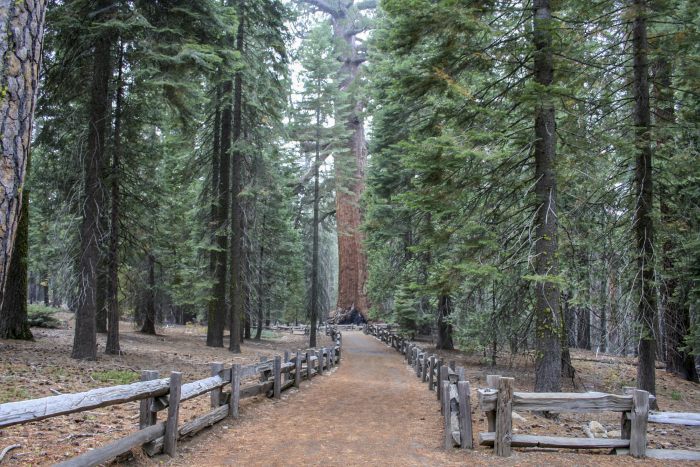
Enjoy one of Yosemite’s evening programs
One of Yosemite’s most amazing sites doesn’t show up until after the sun sets: the stars. Before you end your trip to Yosemite National Park, make sure you spend some time enjoying Yosemite after dark.
The Starry Night Skies Over Yosemite is a fantastic way to stargaze while learning about the constellations, folklore, and science of our galaxy. However, that’s only one of a large collection of evening activities available in Yosemite.
If stargazing isn’t your thing, check out the Night Prowl or Fireside Storytelling for a chance to see the stars while exploring what else night-time in Yosemite has to offer.
Day 4 – Half Dome Hike or Tuolumne Meadows
If you’ve chosen to turn your long weekend in Yosemite into a 4-day Yosemite itinerary, that fourth day is the perfect chance to experience some of the more unique Yosemite landmarks that require more of a time commitment.
For those craving an all-day hike, there’s nothing like Half Dome. If you’re more interested in discovering the less popular gems of Yosemite and not hiking for 8+ hours, head over to Tuolumne Meadows for the day.
Hike up Half Dome
For the hard-core hikers , hiking Half Dome is a once-in-a-lifetime experience. This 15-mile out-and-back trail is not easy and includes 5,193 feet of climbing, but if you’re up to the challenge, there’s nothing like it.
The trail can take anywhere from 8 to 12 hours to complete, depending on your speed, so you’ll want to plan ahead and carve out most of your day for the hike. Pack a trail lunch, snacks, and plenty of water.
If you choose this route, make sure to plan ahead as permits are required to hike Half Dome and are only available via lottery.

Explore Tuolumne Meadows
If seeing Half Dome from the valley sounds much more enjoyable than half a day of hiking, then use your last day to head over to Tuolumne Meadows instead.
This meadow is one of the largest high-elevation meadows in the Sierra Nevada and marks the northern end of a massive stretch of uninterrupted wilderness that continues to the southern end of Mt. Whitney.
There are plenty of hikes of all levels that show off the beauty of Tuolumne, or you can take Tioga Road and drive through the meadow, stopping to enjoy the countless viewpoints along the route. Some of the incredible things you can see here are Olmsted Point, Tenaya Lake and Mirror Lake.
While you’re there, the 3-mile round trip Merced Grove of Giant Sequoias hike is a great chance to get up close and personal with some of Yosemite’s lesser-known giants.

Where to Stay Near Yosemite National Park
Little Valley Inn – Located close to the park entrance in the town of Mariposa, this lovely inn is the perfect place to base yourself when exploring this iconic national park. They have a number of lovely rooms available and there is also a buffet breakfast on offer each morning.
Mariposa Lodge -This lodge is another comfortable and well-reviewed option in Mariposa, and makes for the perfect base to ensure you’re well-rested before exploring Yosemite. They have a number of wonderful rooms on offer, a swimming pool on site and they even allow pets if you happen to be traveling with a furry friend.
Private Rental – Finding a private vacation rental is another fantastic accommodation option in Yosemite. There are a myriad of fantastic options available – like this cosy hilltop cabin – you’re sure to find something that suits your travel style and needs.
Not quite what you’re looking for? Click here to browse more Yosemite hotels!

Yosemite is one of the United States’ most spectacular National Parks. Not only does it feature breathtaking views and thriving wildlife, but it’s full of unique activities, tours, and more. However many days you choose to stay, this Yosemite itinerary is the perfect start to what’s guaranteed to be an outstanding trip.
Are you planning a trip to Yosemite? Have any questions about this itinerary? Let us know in the comments!

Related Posts:

The Ultimate 2 to 3 Days in Lake Tahoe Itinerary

The Essential California Packing List

9 Best Stops on a San Francisco to Yosemite Road Trip

About Sarah Dittmore
Sarah is a writer for The World Was Here First. A California native, she loves travelling around her home state as well as visiting places further afield. She has spent over a decade travelling the world and writing stories inspired by the people and places she encounters along the way.
“15-mile Out and Back hike” Your description for the Half Dome hike. Does your “O&B” refer to 15 miles out and another 15 miles back OR simply put, “15-miles round trip?
What percentage of this hike is on level or near level ground versus the ascent. How many feet is the ascent?
I understood that the climb was simply a “cable climb”.
Leave a Comment Cancel reply

How to Travel to Yosemite: A First-Timer’s Guide to Planning Your Visit
To travel to Yosemite, drive from Los Angeles via I-5 and CA-99 to CA-41 (approx. 6 hours). Arrive before 9 am or after 5 pm to avoid peak hours. Use the free park shuttle or YARTS bus for public transportation. Nearby airports include Mammoth Yosemite (MMH) and Fresno (FAT). Always respect wildlife safety and practice Leave No Trace.
Next, consider the best time to visit Yosemite. Spring and fall offer mild weather. Summer attracts the largest crowds, while winter showcases stunning snow-covered landscapes. Always check for park alerts before your trip.
Accommodation options abound, from campgrounds to lodges. Reservations are crucial, especially during peak seasons.
Packing for your visit is vital. Include comfortable hiking shoes, water bottles, and layered clothing. Yosemite boasts diverse terrain. Prepare for various conditions.
Planning your visit to Yosemite involves more than just logistics. Understanding the park’s layout will enhance your experience. The next steps include exploring popular attractions, such as Yosemite Valley and Half Dome. Engaging with these landmarks will add depth to your journey and ensure you capture the essence of this stunning national park.
Table of Contents
What Do You Need to Know Before Traveling to Yosemite?
Before traveling to Yosemite, it is essential to prepare adequately for the unique conditions and experiences the park offers.
- Understand the park’s accessibility and opening times.
- Familiarize yourself with the weather and seasons.
- Plan your accommodations in advance.
- Know about the park’s activities and attractions.
- Be aware of safety guidelines and regulations.
- Learn about wildlife and environmental preservation.
- Consider transportation options within the park.
- Prepare for physical demands and trail conditions.
Understanding these aspects will enhance your overall experience and ensure you are well-prepared for your journey.
Understand the Park’s Accessibility and Opening Times : Knowing the accessibility of Yosemite National Park is crucial. The park is typically open year-round, but some roads close during winter due to snow. Certain areas may be inaccessible, so check the National Park Service website or call ahead for the latest updates.
Familiarize Yourself with the Weather and Seasons : Weather conditions vary significantly in Yosemite. Summer months are popular, with temperatures between 70°F and 90°F. However, temperatures can drop at night and in higher elevations. Winters can be cold, with snowmaking the park scenic but challenging for access. Historical weather data can be found on the National Park Service’s website.
Plan Your Accommodations in Advance : Accommodations range from hotels to campgrounds. Reservations are strongly recommended, especially during the peak season from May to September. Campgrounds fill quickly, so book well in advance. Check the availability on the official website.
Know About the Park’s Activities and Attractions : Yosemite offers a variety of outdoor activities. Hiking, rock climbing, and photography are just a few options. Popular sites include El Capitan, Half Dome, and Mariposa Grove of Giant Sequoias. Each attraction has specific features that appeal to various interests, from the casual visitor to experienced climbers.
Be Aware of Safety Guidelines and Regulations : Every visitor should know safety guidelines in the park. This includes understanding bear safety, following marked trails, and adhering to fire regulations. The National Park Service provides safety briefings and signage in critical areas.
Learn About Wildlife and Environmental Preservation : Yosemite is home to diverse wildlife. Respect the natural habitat and refrain from feeding animals. Understanding the ecological significance of your surroundings enhances appreciation, as noted by the National Park Service conservation efforts.
Consider Transportation Options Within the Park : Within Yosemite, transportation options include shuttle buses during peak seasons. These shuttles reduce traffic congestion and provide access to popular destinations. Private vehicles are permitted but should be parked in designated areas.
Prepare for Physical Demands and Trail Conditions : Many popular trails range from easy to strenuous. Prepare accordingly by assessing your physical fitness and choosing trails that match your skill level. Information on trail conditions is available from park rangers and online resources.
By addressing these critical points, you can ensure a rewarding and safe visit to Yosemite National Park.
What Are the Best Times to Visit Yosemite for Your Trip?
The best times to visit Yosemite National Park are during the spring and fall months, specifically April to June and September to October.
- Spring (April to June)
- Fall (September to October)
- Summer (July to August)
- Winter (November to March)
Understanding the best times to visit Yosemite can deepen your appreciation for this majestic park and enhance your adventure.
Spring (April to June) : Visiting Yosemite in spring offers beautiful wildflower blooms and rushing waterfalls. This season typically sees milder weather, with daytime temperatures ranging from 50°F to 70°F. The snowmelt from the Sierra Nevada mountains feeds waterfalls like Yosemite Falls, making them particularly impressive. Hiking trails, such as those to Mirror Lake and Mist Trail, become more accessible. According to the National Park Service, spring often features fewer tourists compared to summer, allowing for a more serene experience. The park is vibrant with greenery and wildlife becomes more active as animals emerge from their winter habitats.
Fall (September to October) : Fall in Yosemite reveals stunning autumn colors. Trees such as oaks and maples turn golden and red, creating picturesque views. The weather during this period is generally mild, with temperatures averaging between 60°F and 75°F. This season sees fewer crowds as children are back in school, creating a more tranquil environment for visitors. Research by the National Park Service indicates that this is an excellent time for photography, as the moderate climate enhances outdoor activities like hiking and bird-watching. Additionally, popular areas such as Glacier Point provide stunning views of the changing foliage.
Summer (July to August) : While summer promises warm weather and full accessibility to all park features, it is also the peak tourist season. Temperatures can soar between 70°F and 90°F, and accommodations fill up quickly. Visitors enjoy a range of outdoor activities, such as rock climbing and rafting. However, this period can lead to crowded trails and longer wait times at popular locations. The National Park Service cautions that summer can also increase the chance of wildfires, which may affect air quality. Despite these challenges, some visitors argue that experiencing Yosemite during peak season is worthwhile due to the lively atmosphere and range of available programs.
Winter (November to March) : Winter offers a unique peacefulness in Yosemite. Snow blankets the park, creating a different but stunning landscape. This season is ideal for winter sports such as snowshoeing and cross-country skiing. Temperatures are cold, often ranging from 20°F to 50°F. While many park roads close due to snow, lower elevation areas remain accessible. The park’s visitor center remains open, offering informational programs. Some argue winter visits provide a rare opportunity to see Yosemite’s iconic sites in solitude. However, it requires advance planning due to road conditions and potential closures.
In summary, a visit to Yosemite can be enjoyable at any time of the year, each season providing its own set of experiences and sights.
How Can You Travel to Yosemite National Park?
You can travel to Yosemite National Park by car, bus, or airplane, depending on your starting location and preferences. Here are the details for each option:
By Car : Driving is the most common way to reach Yosemite. The park has multiple entry points. – From San Francisco, the distance is about 170 miles (273 kilometers), taking around 4 to 5 hours via Highways 120 or 140. – From Los Angeles, the distance is approximately 300 miles (483 kilometers), with a driving time of about 6 to 7 hours via Interstate 5 and Highway 41. – Visitors should check road conditions as snowfall can lead to closures, especially in winter months. The National Park Service (NPS) provides regular updates on road conditions.
By Bus : Various bus services provide transportation to Yosemite from cities nearby. – For example, the YARTS (Yosemite Area Regional Transportation System) connects to major bus lines and provides access to park entrances. – Greyhound and other regional bus services also operate routes from larger cities such as San Francisco and Sacramento to the park’s area. – It is best to book tickets in advance, especially during peak travel seasons.
By Airplane : Flying is an option for travelers coming from farther distances. – The closest major airport is in Fresno, California, located about 65 miles (104 kilometers) from the park’s south entrance. – Another option is flying into San Francisco or Sacramento, both roughly 170 miles (273 kilometers) away from Yosemite. – Upon arrival at these airports, car rentals are available, or travelers can use shuttle services to reach the park.
Choosing the right mode of transportation depends on individual circumstances, including budget, time constraints, and preferences for convenience. Planning ahead can help ensure a smoother travel experience to Yosemite National Park.
What Driving Routes Lead to Yosemite?
Driving routes leading to Yosemite National Park vary based on starting location and seasonal conditions. The most common routes include:
- Highway 120 (Big Oak Flat Entrance)
- Highway 140 (Arch Rock Entrance)
- Highway 41 (South Entrance)
- Highway 395 (Eastern Sierra)
- Highway 49 (Gold Country Route)
Each of these routes provides unique views and experiences. Some routes are more popular and well-traveled, while others offer scenic, less crowded experiences.
Highway 120 (Big Oak Flat Entrance) : Highway 120 leads directly to Yosemite’s main entrance from the Bay Area and is the most frequently used route, especially during peak season. This highway travels through the stunning Tuolumne County, providing beautiful landscapes and views of the Sierra Nevada mountains. According to the California Department of Transportation, this route is often well-maintained but may close during winter due to snow.
Highway 140 (Arch Rock Entrance) : Highway 140 is another significant route, especially for travelers coming from the central valley regions. This road passes through Mariposa and makes access to the park straightforward. The scenic drive features landmarks such as the historic town of Mariposa. The Mariposa County Visitors Bureau suggests that this entrance is highly accessible year-round compared to others.
Highway 41 (South Entrance) : The South Entrance via Highway 41 is ideal for visitors traveling from Los Angeles. This route cuts through dense forests and features numerous viewpoints, such as the iconic Wawona Hotel. However, drivers should be cautious in winter, as this route can experience snow and road closures.
Highway 395 (Eastern Sierra) : Highway 395 is commonly used by those coming from the east, such as Nevada. This scenic route goes alongside the Eastern Sierra and provides breathtaking views of mountain ranges. Travelers can enjoy stops at places like Mono Lake before reaching Yosemite. The Eastern Sierra Visitor Center suggests that this route, while longer, offers a unique opportunity to explore less-trafficked areas of the Sierra.
Highway 49 (Gold Country Route) : Highway 49 is an alternate route that leads through California’s historic Gold Country. This is perfect for travelers interested in exploring gold rush history and heritage. The drive showcases charming towns, such as Nevada City and Grass Valley, before entering Yosemite. Visitors can encounter scenic vistas and cultural landmarks along the way.
Each route provides distinct advantages and experiences for travelers visiting Yosemite National Park. Planning your route according to your interests and starting point can greatly enhance your trip.
What Are the Public Transportation Options to Get to Yosemite?
The public transportation options to get to Yosemite National Park include various bus services and train routes, providing access from major cities and airports.
- YARTS (Yosemite Area Regional Transportation System)
- Amtrak Train Services
- Public Bus Services
- Shuttle Services
- Rideshare Options
Public transportation options to get to Yosemite National Park include YARTS, Amtrak train services, public bus services, shuttle services, and rideshare options. Each option offers unique benefits and considerations depending on the traveler’s needs.
YARTS: YARTS provides bus services connecting various regions to Yosemite National Park. The system is designed to enhance access by linking with other transit networks, including Amtrak. YARTS stands for Yosemite Area Regional Transportation System. According to their website, YARTS operates several routes to the park, serving communities like Merced, Madera, and Tuolumne. This option facilitates travel for visitors using public transportation.
Amtrak Train Services: Amtrak operates train routes to nearby stations serving Yosemite’s vicinity. The Merced station is the closest Amtrak stop, located about 45 miles from the park. Travelers can connect to YARTS buses from this station for direct access to Yosemite. Amtrak trains offer comfortable seating and onboard amenities, making it a preferred choice for many visitors. According to Amtrak’s 2022 ridership statistics, train travel has seen a resurgence in popularity.
Public Bus Services: Various public bus services operate routes to Yosemite National Park. Cities like Fresno and Merced provide connections through regional transit agencies. These services typically operate on limited schedules and may require advance planning. Travelers should check local transit websites for specific times and fares. Public buses are an economical option for budget-conscious visitors.
Shuttle Services: Shuttle services are available from multiple locations, including airports and nearby cities. Some private companies offer direct shuttles to Yosemite, providing door-to-door service for travelers. Shuttles usually require reservations and may be subject to availability. They offer convenient travel options for groups or families who prefer a direct route.
Rideshare Options: Rideshare services like Uber and Lyft can be utilized for travel to Yosemite. While not a traditional public transportation option, they provide flexibility and convenience. Visitors can use rideshare services from nearby cities or airports if they need a more personalized travel experience. However, this option can be more expensive than traditional public transport.
In conclusion, choosing the right public transportation option to get to Yosemite depends on individual preferences, travel schedules, and budget considerations.
How Can You Reach Yosemite by Air or Rail?
You can reach Yosemite National Park by air or rail through nearby airports or train stations, followed by additional travel via rental cars or shuttles.
For air travel, the following airports serve as convenient gateways to Yosemite:
- Fresno Yosemite International Airport (FAT) : This airport is approximately 65 miles from the park. It offers several major airlines and car rental services.
- Merced Regional Airport (MCE) : Located about 75 miles from Yosemite, this smaller airport provides limited flights, primarily from regional airlines.
- San Francisco International Airport (SFO) : Situated around 170 miles away, it provides numerous national and international flights, making it a popular choice. However, it requires a longer drive to reach the park.
For rail travel, Amtrak provides access via the following routes:
- Amtrak’s San Joaquin Line : This train service connects major cities like Los Angeles and Sacramento to Merced, which is the closest station to Yosemite. From Merced, travelers can take YARTS (Yosemite Area Regional Transportation System) for shuttle services into the park.
Travelers should plan their trips in advance. According to the National Park Service (NPS, 2022), the peak visiting season is typically from May through September. During this time, visitors should consider making reservations for shuttles, lodging, and car rentals.
Combining air or rail with local transportation options ensures a relatively seamless journey to Yosemite National Park, allowing travelers to enjoy its natural beauty effectively.
What Must-See Attractions Should You Include in Your Itinerary?
The must-see attractions to include in your itinerary depend on your destination. Here are some popular categories of attractions:
- Natural Landscapes
- Historical Sites
- Cultural Institutions
- Adventure Activities
- Culinary Experiences
- Local Markets
- Events and Festivals
These categories highlight the variety of experiences available and cater to diverse interests. Below, we will explore each category in more detail to help you plan your trip effectively.
Natural Landscapes : Natural landscapes feature breathtaking views and unique ecosystems. Popular examples include national parks, mountains, and beaches. For instance, visiting the Grand Canyon in Arizona showcases stunning geological formations and expansive vistas. According to the National Park Service, over 6 million people visit the Grand Canyon annually, highlighting its appeal as a must-see attraction.
Historical Sites : Historical sites include landmarks that represent a region’s past. The Great Wall of China and the Colosseum in Rome are prime examples. They offer insights into historical architecture and cultural significance. UNESCO recognizes many such sites, indicating their global importance. For example, the Colosseum draws about 7.6 million visitors each year, emphasizing its status as a key historical attraction.
Cultural Institutions : Cultural institutions encompass museums, art galleries, and theaters. The Louvre in Paris showcases thousands of art pieces, including the Mona Lisa. It attracts millions of art enthusiasts each year. According to statistics, the Louvre recorded over 9.6 million visitors in 2019, making it one of the most visited museums worldwide.
Adventure Activities : Adventure activities cater to thrill-seekers looking for excitement. Examples include zip-lining, hiking, and scuba diving. Locations such as Queenstown, New Zealand, offer various adrenaline-packed activities appealing to adventure tourism. Research by the Adventure Travel Trade Association shows a growth in adventure tourism, with over 50% of travelers interested in incorporating adventurous experiences into their itineraries.
Culinary Experiences : Culinary experiences allow travelers to explore local cuisine. Food markets, cooking classes, and street food tours highlight regional flavors. For example, the street food scene in Bangkok attracts food lovers worldwide. According to a 2019 survey by the Thai Ministry of Tourism, culinary tourism has increased by 25% in recent years, showcasing the rising interest in food experiences.
Local Markets : Local markets provide insight into daily life and local culture. They often feature handicrafts, produce, and unique products. Visiting places like the Grand Bazaar in Istanbul allows travelers to experience local commerce and craftsmanship. The Grand Bazaar attracts approximately 15 million visitors annually, highlighting its significance as a cultural hub.
Events and Festivals : Events and festivals showcase local traditions and celebrations. Examples include Carnival in Brazil and Oktoberfest in Germany. These events draw large crowds, offering a glimpse into local customs. For instance, Oktoberfest attracts over 6 million visitors each year, making it the world’s largest beer festival.
Understanding these categories of must-see attractions enables travelers to create a diverse and engaging itinerary tailored to their interests.
What Iconic Hikes Await You in Yosemite?
Yosemite National Park offers several iconic hikes that attract outdoor enthusiasts. Each hike showcases the park’s stunning landscapes, diverse ecosystems, and unique geological features.
- Yosemite Falls
- Glacier Point
- Ansel Adams Wilderness
- Mariposa Grove of Giant Sequoias
These hikes cater to various skill levels and preferences. Some hikers may enjoy challenging routes like Half Dome, while others might prefer leisurely walks through the Mariposa Grove.
Half Dome: Half Dome is one of Yosemite’s most challenging and iconic hikes. The hike covers approximately 14 to 16 miles round trip, climbing 4,800 feet to the summit. This hike features stunning views of Yosemite Valley, but requires a permit for the final cable ascent. According to the National Park Service, about 300,000 people attempt the hike each year, though only a small percentage reach the summit. Hikers should prepare adequately for elevation changes and variable weather.
Yosemite Falls: Yosemite Falls, one of the tallest waterfalls in North America, offers a shorter yet rewarding hike. The trail is about 7.2 miles round trip, ascending 2,700 feet to the top of the falls. The view from the top is breathtaking, showcasing the valley below. In spring, the waterfall is at its peak flow. The trail can be steep and strenuous, so visitors should bring proper footwear and plenty of water.
Glacier Point: Glacier Point is accessible by car or via a 10-mile round-trip hike that offers breathtaking views over Yosemite Valley, Half Dome, and El Capitan. The hike from the valley requires an elevation gain of 3,200 feet. Travelers can also visit by a short hike from the Glacier Point Road. According to Yosemite Conservancy, Glacier Point is a favorite destination for photographers, especially during sunrise or sunset.
Ansel Adams Wilderness: The Ansel Adams Wilderness offers diverse hikes in a unique landscape. This area is known for its alpine lakes, glacial valleys, and stunning peaks. Trails vary in difficulty and length, accommodating both beginners and experienced hikers. Hiking here provides opportunities for solitude and reflection, away from the busier parts of Yosemite. Experienced hikers can explore routes leading into backcountry terrains.
Mist Trail: The Mist Trail is famous for its close-up views of Vernal and Nevada Falls. This 3.5-mile hike is steep and wet, especially during spring when waterfalls are at their fullest. The 600-step climb to the top of Vernal Fall is particularly challenging but rewarding. Hikers should be prepared to get wet and should use caution on wet rocks.
Mariposa Grove of Giant Sequoias: The Mariposa Grove features ancient giant sequoias and offers several hiking options. The Grizzly Giant Loop Trail is a 2-mile walk that showcases some of the largest sequoias in the grove. Visitors can marvel at these magnificent trees, some of which are over 2,000 years old. This area provides a more tranquil experience compared to the more crowded attractions in Yosemite.
Yosemite National Park’s iconic hikes encapsulate its natural beauty and diverse landscapes. Each hike offers unique experiences and picturesque views, appealing to a wide range of outdoor adventurers.
What Should You Pack for Your Visit to Yosemite?
When visiting Yosemite, it is important to pack essential items to ensure a safe and enjoyable experience. Consider including clothing, gear, food, and other supplies suitable for the park’s diverse activities and climate conditions.
- Clothing appropriate for varying weather
- Hiking gear, including sturdy footwear and trekking poles
- Food and snacks for energy during activities
- Water bottle or hydration system
- Navigation tools, such as maps or GPS devices
- Camping equipment if staying overnight
- First aid kit for emergencies
- Sun protection, including sunscreen and hats
- Insect repellent for protection against pests
- Camera or binoculars for wildlife viewing
Understanding the essential items is crucial for a successful visit to Yosemite. Each category of packing items serves a specific purpose in enhancing comfort and safety while exploring the park.
Clothing appropriate for varying weather : Packing clothing suitable for changing weather is critical. Yosemite experiences diverse conditions, sometimes shifting from cool mornings to warm afternoons. Layering is key. You should bring moisture-wicking base layers, insulating mid-layers like fleece, and waterproof outer layers. According to the National Park Service, average temperatures in summer can range from 50°F at night to 85°F during the day.
Hiking gear, including sturdy footwear and trekking poles : Quality hiking gear improves safety and comfort on trails. Hiking boots with good traction protect your feet and ankles. Trekking poles help maintain balance and reduce strain on joints. Research indicates that appropriate footwear can prevent injuries and fatigue, enhancing your hiking experience (American Orthopaedic Foot & Ankle Society, 2021).
Food and snacks for energy during activities : Packed meals and snacks are necessary for sustaining energy levels. High-protein and high-calorie foods like nuts, energy bars, and dried fruits are excellent options. By bringing your food, you reduce dependence on limited park facilities, especially in remote areas.
Water bottle or hydration system : Staying hydrated is vital, particularly in the dry environment of Yosemite. Using a reusable water bottle or hydration pack ensures you have access to clean water throughout your adventures. The National Park Service recommends drinking water every couple of hours while hiking to maintain hydration.
Navigation tools, such as maps or GPS devices : Proper navigation is important, especially for new visitors. Carrying a detailed map of Yosemite and having a fully charged GPS device or smartphone can prevent you from getting lost. Many areas in the park have limited cell service, so offline resources can be especially useful.
Camping equipment if staying overnight : If planning to camp, ensure you have a sturdy tent, sleeping bag, and cooking gear. Camping equipment varies based on your camping style and location in the park. The National Park Service provides guidelines on equipment requirements for different campsites.
First aid kit for emergencies : A well-stocked first aid kit is essential for addressing minor injuries or health issues during your visit. Include items like antiseptic wipes, adhesive bandages, pain relievers, and any personal medication. The American Red Cross advises bringing a first aid kit tailored to outdoor activities.
Sun protection, including sunscreen and hats : Due to high altitude and exposure, protecting your skin from UV rays is crucial. Pack broad-spectrum sunscreen with at least SPF 30, sunglasses, and a wide-brimmed hat to shield yourself from the sun. According to the Skin Cancer Foundation, up to 80% of UV rays can reach you even on cloudy days.
Insect repellent for protection against pests : Insect repellent is advisable to keep mosquitoes and ticks at bay. Select a repellent containing DEET or picaridin for effectiveness. The Centers for Disease Control and Prevention recommend using these products as added protection against insect-borne diseases.
Camera or binoculars for wildlife viewing : Yosemite is home to diverse wildlife. A camera or binoculars enhances your ability to observe and capture images of animals in their natural habitat. According to the Yosemite Natural History Association, visitors can spot black bears, deer, and various bird species that enhance the park’s wilderness experience.
By packing these essential items, you set yourself up for an enjoyable and memorable trip to Yosemite.
Where Are the Best Places to Stay While Visiting Yosemite?
The best places to stay while visiting Yosemite include various accommodations that cater to different preferences. First, you can choose a lodge inside the park, such as the Tenaya Lodge at Yosemite. This lodge offers a comfortable stay with easy access to park attractions. Second, consider the Yosemite Valley Lodge, which provides stunning views of Yosemite Falls and immediate proximity to popular sites. Third, for a more rustic experience, you might opt for one of the many campgrounds, such as North Pines Campground. This option allows visitors to immerse themselves in nature. Fourth, hotels in nearby towns like Mariposa or Groveland offer additional choices. These towns provide more amenities and dining options while being within reasonable driving distance. Finally, vacation rentals and cabins around the park deliver a home-like atmosphere for families or groups. Each option has unique attributes, making them suitable for various types of travelers.
What Camping Options Are Available Inside the Park?
The camping options available inside the park include various types of campgrounds catering to different needs and preferences.
- Established Campgrounds
- Backcountry Camping
- Group Campgrounds
- RV-Friendly Campgrounds
- Wilderness Areas
These categories provide a range of choices for campers, from those seeking convenience to those looking for a more rugged outdoor experience.
Established Campgrounds : Established campgrounds provide designated sites with amenities such as fire pits, picnic tables, and restrooms. These campgrounds often require reservations, especially during peak seasons. Parks typically have varying levels of facilities, from basic to enhanced, to accommodate different camping preferences.
Backcountry Camping : Backcountry camping allows campers to experience a more remote and natural setting. This option requires obtaining a permit and following specific guidelines to minimize environmental impact. Campers carry their gear and set up in less-traveled areas. This type of camping offers solitude and the opportunity to connect with nature deeply.
Group Campgrounds : Group campgrounds are designed for larger gatherings, accommodating multiple tents or RVs. These sites have additional space and often feature shared facilities. They are ideal for family reunions or group outings where individuals seek communal experiences in nature.
RV-Friendly Campgrounds : RV-friendly campgrounds provide facilities suitable for recreational vehicles. These sites often include hookups for water, electricity, and sewage disposal. They cater to those who prefer the comforts of home while still enjoying the great outdoors. Reservations are usually recommended due to high demand.
Wilderness Areas : Wilderness areas maintain that campers follow Leave No Trace principles. These regions are often less developed, providing a more rugged camping experience. Campers may require advanced planning and skills in navigation and survival, as these areas lack established trails and facilities.
Camping options vary widely in amenities, location, and required preparations, offering something for every type of camper.
Which Hotels or Rentals Are Ideal Near Yosemite?
Several hotels and rental options near Yosemite National Park are ideal for various travelers. These range from luxury resorts to budget-friendly cabins.
Hotels: – Tenaya Lodge at Yosemite – Wawona Hotel – Yosemite Valley Lodge – Rush Creek Lodge
Vacation Rentals: – Airbnbs and VRBOs – Yosemite Lakes RV Resort – Cabin rentals in Fish Camp – Lodges in Oakhurst
Campgrounds: – Camp 4 – Wawona Campground – Hodgdon Meadow Campground – Crane Flat Campground
Considering the diversity of travelers’ needs, including luxury seekers and budget-conscious visitors, these accommodations cater to various preferences.
- Hotels: Hotels near Yosemite National Park provide different experiences based on amenities and pricing.
Tenaya Lodge at Yosemite : Tenaya Lodge is a luxury hotel that offers upscale accommodations and spa services. It is located just outside the south entrance of the park. Founded in 1990, Tenaya is known for its beautiful mountain scenery and excellent dining options.
Wawona Hotel : Wawona Hotel is a historic hotel located within the park. It has a rustic charm and provides seasonal accommodations. This hotel draws visitors seeking a unique and historical experience.
Yosemite Valley Lodge : This lodge overlooks Yosemite Falls, offering stunning views and immediate access to the valley. Visitors often appreciate its proximity to major attractions in the park.
Rush Creek Lodge : Rush Creek is a popular choice for families. It offers various accommodations, from hotel rooms to private villas, and features amenities like pools and recreational activities.
- Vacation Rentals: Vacation rentals offer a home-like experience for families or larger groups.
Airbnbs and VRBOs : These platforms provide a range of properties, from cozy cabins to large homes with full kitchens. They are ideal for travelers seeking flexibility and space.
Yosemite Lakes RV Resort : This resort combines RV camping with cabin rentals. It is suitable for visitors wanting to experience both camping and comfort.
Cabin rentals in Fish Camp : Fish Camp offers a quiet location just outside the park. Different cabins range from rustic to luxurious.
Lodges in Oakhurst : Oakhurst has lodges that provide a convenient stop for visitors entering the park from the south. Amenities may include breakfast and outdoor activities.
- Campgrounds: Campgrounds are popular for those who enjoy outdoor experiences.
Camp 4 : Camp 4 is famous among rock climbers and offers a first-come, first-served camping style.
Wawona Campground : This campground is located near the Merced River and is ideal for families with children.
Hodgdon Meadow Campground : Hodgdon Meadow offers access to trails and is less crowded than some other campgrounds.
Crane Flat Campground : Crane Flat is open year-round and is near Tuolumne Meadows. It is excellent for visitors looking to hike around that area.
These accommodation options reflect the varied needs of guests near Yosemite. Each provides unique benefits, enhancing the overall experience of visiting this beautiful national park.
What Safety Guidelines Should You Follow When Visiting Yosemite?
When visiting Yosemite National Park, it is essential to follow specific safety guidelines to ensure a safe and enjoyable experience.
- Stay on marked trails
- Store food properly
- Be aware of wildlife
- Follow fire safety rules
- Monitor weather conditions
- Prepare for altitude
- Use proper hiking gear
These guidelines are crucial for your safety and can significantly enhance your visit. Understanding each point will help you navigate Yosemite more securely and responsibly.
Stay on Marked Trails : Staying on marked trails helps protect the park’s fragile ecosystem. Walking off-trail can lead to plant erosion and disrupt wildlife habitats. According to the National Park Service, approximately 55% of search and rescue missions occur when visitors stray from established paths. To minimize risk, always stick to designated routes.
Store Food Properly : Storing food correctly prevents animals from accessing it. Bears are prevalent in Yosemite, and improper food storage can lead to dangerous encounters. The National Park Service recommends using bear-proof lockers and containers. In 2022, officials reported an increase in bear incidents due to careless food storage. Proper practices protect both visitors and wildlife.
Be Aware of Wildlife : Observing wildlife is a significant attraction in Yosemite, but maintaining a safe distance is vital. Animals can behave unpredictably, especially when they feel threatened. The National Park Service advises visitors to stay at least 100 yards away from bears and 25 yards from other animals. Respectful observation ensures safety and keeps wildlife wild.
Follow Fire Safety Rules : Due to the dry conditions in the park, following fire safety rules is paramount. Campfires are allowed only in designated areas, and all fires must be fully extinguished before leaving. In 2021, over 18,000 acres burned in Yosemite from wildfires, emphasizing the importance of fire safety. Adhering to these rules helps prevent accidental fires.
Monitor Weather Conditions : Weather in the park can change rapidly. Rain, snow, and winds can occur unexpectedly. The National Park Service advises checking weather forecasts before heading out. Knowing potential weather conditions can help you prepare adequately and avoid dangerous situations like flash floods or winter storms.
Prepare for Altitude : Yosemite’s elevation can cause altitude sickness for some visitors. Symptoms include headaches, nausea, and dizziness. It is advisable to ascend gradually and stay hydrated. The park sits at over 4,000 feet, and many visitors are unaccustomed to the altitude. Taking these precautions can ensure a more comfortable visit.
Use Proper Hiking Gear : Wearing appropriate hiking gear enhances safety on trails. Sturdy shoes, weather-appropriate clothing, and plenty of water are necessary. The National Park Service recommends wearing layers to adjust to fluctuating temperatures. In a 2020 survey, hikers reported a 30% higher enjoyment rate when wearing suitable gear compared to those who did not.
Following these safety guidelines will enhance your experience at Yosemite National Park while safeguarding yourself and the environment.
How Can You Enhance Your Experience While Traveling to Yosemite?
To enhance your experience while traveling to Yosemite, plan ahead, explore diverse activities, stay informed about park regulations, and invest in proper gear.
Planning ahead enables you to make the most of your visit. Researching lodging options, such as campsites or hotels, ensures you secure accommodations in advance, especially during peak seasons. Booking activities, like guided tours or rock climbing lessons, allows you to access expert knowledge and unique experiences.
Exploring diverse activities makes your visit memorable. Hiking popular trails, such as Mist Trail or Half Dome, offers breathtaking views and connects you with nature. Scenic drives, like the Tioga Pass Road, provide stunning landscapes. Additionally, participating in ranger-led programs deepens your understanding of the park’s ecology and history.
Staying informed about park regulations is crucial for safety and preservation. Review rules regarding wildlife interaction, fire safety, and area restrictions. Adhering to Leave No Trace principles ensures minimal impact on the environment. For example, keeping a distance from animals protects both tourists and wildlife.
Investing in proper gear enhances your comfort and safety. Essential items include sturdy footwear for hiking, layered clothing to adapt to changing weather, and a refillable water bottle to stay hydrated. A detailed map or GPS device aids navigation, while a first-aid kit prepares you for minor emergencies.
By following these strategies, you can maximize enjoyment and ensure a safe, memorable journey in Yosemite.
- How to travel to yellowstone
- How to travel to the vatican
- How to travel to taj mahal
- How to travel to st tropez
- How to travel to st john
- Skip to global NPS navigation
- Skip to this park navigation
- Skip to the main content
- Skip to this park information section
- Skip to the footer section

Exiting nps.gov
Alerts in effect, entrance reservations, park footer, contact info.
209/372-0200
Stay Connected

IMAGES
COMMENTS
1. Spot the climbers on El Capitan. The first views as you drive into the Yosemite Valley are unforgettable. The huge cliffs are something we'd seen hundreds of times before in photos, but it still blew us away. Start your day by heading to El Capitan meadow to get a great view of this iconic mountain.
Yosemite Westgate Lodge. 7633 Highway 120 at Buck Meadows, Buck Meadows, CA 95321. If you're coming from San Francisco to Yosemite National Park, you will probably be taking California's State Route 120, known as the Big Oak Flat Road during the Gold Rush. If so, there's no better place to stay than the Yosemite Westgate Lodge at Buck Meadows. Apart from the prime location right outside ...
Best Time of Year for a Yosemite Day Trip. Yosemite National Park is open all year, but most visitors choose to come in the warmer months from May to October. July and August typically get over 700,000 visitors per month. To avoid peak crowds, consider visiting in May to early June or October to early November.
Tips for Planning a Trip to Yosemite National Park. Here are some of my top tips to remember as you plan your trip, plus an overview of the entrance fees and 2024 reservation system in place for Yosemite. ... Day Trip: How to Spend One Day in Yosemite; Viewpoints: Best Photography Spots in Yosemite; Airbnbs: Best Airbnbs & Rentals Near Yosemite ...
12:30 PM - Continue driving the loop road, stopping at the viewpoints for the Cathedral Rocks, El Capitan Meadow, and Yosemite Valley View, in that order, and then stop at the Tunnel View on the way out of the valley. 1:30 PM - Exit the valley and start driving to Glacier Point.
Here are some of the best-rated day tours to Yosemite National Park: Small-Group Yosemite & Giant Sequoias Day Trip from San Francisco: 5/5 ⭐. Small-Group Day Trip to Yosemite from Lake Tahoe: 5/5 ⭐. One Day In Yosemite Private Tour: 5/5 ⭐. EXPLORE MORE YOSEMITE DAY-TRIP TOURS.
A reservation is required to drive into or through Yosemite National Park through October 27 on Saturdays, Sundays, and holidays (September 2 and October 14) from 5 am to 4 pm. Driving through the park will also require a reservation if entering between 5 am and 4 pm. If you are planning to visit after peak hours, please do not arrive before 4 ...
Learn more about dining options in Yosemite, here. Planning a trip to Yosemite National Park? The Yosemite Itinerary Guide has your perfect 1, 2, or 3 day Yosemite trip completely planned for you! With over 20 pages of detailed hiking guides, printable daily itineraries, lodging and dining suggestions and more, you can spend less time planning ...
If you're planning a day trip to Yosemite National Park, gaining park access and navigating the available options for transportation is essential. Yosemite Valley is around 4 hours from San Francisco and 6 hours from Los Angeles, making it feasible for a one-day Yosemite adventure.
Planning a Yosemite Day Trip (From the San Francisco Bay Area + Elsewhere) If you're coming to Yosemite on a day trip from San Francisco, keep in mind that you'll need about 3-3.5 hours to reach the nearest park entrance (Big Oak Flat Entrance).
Annual visitors: 4 million. Peak season: May-October. Size: 759,620 acres. Yosemite is open year round but around 75% of the park's 4 million annual visitors plan trips for the peak months between May and October. Entry to Yosemite costs $35 for a 7-day pass, which covers your vehicle and all passengers.
On your Yosemite day trip, reserve a few hours to take a hike up the iconic Mist Trail and catch a glimpse at this unmissable waterfall known as Vernal Fall. In my opinion, Vernal Fall is the best waterfall to see in the entire park. ... Part of the process of planning a trip to Yosemite National Park is deciding where to stay in/near Yosemite ...
TripSavvy / Jess Macdonald Tips for a Great Day Trip . Best way to get there: Drive to Yosemite Valley via CA Hwy 140 through Mariposa. It's the most scenic way to get there. Tunnel view: On the way into the park, turn onto CA Hwy 41, following the sign marked Bridalveil Fall. Just before you reach the tunnel, stop in the parking lot for classic picture-taking and a panoramic view of the ...
Itinerary for One Day in Yosemite National Park. 1. Visit a Sequoia Grove. Towering Sequoias in Mariposa Grove. Yosemite is home to some of the largest trees on the planet, and has three different giant sequoia groves. Stopping to walk through one is a must, especially if you have never seen a sequoia in person before.
While Yosemite is worthy of a longer visit, a one-day visit can be enough to get a good taste of the park. This Yosemite day trip itinerary will help make the most of your one-day visit. I first visited Yosemite on a family trip back in the mid-90s and recently returned to thoroughly explore the national park.
Here are your options: The private vehicle entrance fee, good for 7 days, is $35. You can walk or bike into the park for $20 per person, good for 7 days. As Yosemite Valley is so long, I don't recommend this if you only have one day. An annual America the Beautiful Pass is $80.
That's why we've put together a one-day itinerary so you can have the best, action-packed day in Yosemite National Park. The most scenic way to get there is through CA Hwy 41, where the road meanders through the mountains and brings you to the first must-stop: Tunnel View. After driving through the long, dark Wawona Tunnel, the road spits ...
After spending 3 days in Yosemite, I HIGHLY encourage you to indulge in the extensive menu at Aroma Tavern & Buffalo Bar in Fish Camp for dinner from 5-9pm Thursday to Sunday. Or, devour fried pickles, award-winning beers and burgers at South Gate Brewing Company from 11AM-8PM everyday.
Frequently Asked Questions About Yosemite National Park. Planning a trip to Yosemite National Park can be overwhelming because there's just so much information to take in. These are the most frequently asked questions we see about visiting Yosemite. Can Yosemite Be Done In 1 Day? Yes, it is possible to see Yosemite in one day.
With 1,169 square miles to explore, there's always more to see in Yosemite National Park - that's why planning a trip to Yosemite can be tough. Find out what landmarks you can't miss on your trip, whether to visit the park in summer or winter, and more. Plan a trip to Yosemite with our travel guide.
Sentinal Dome trail is an easy 2.2-mile hike and absolutely perfect for any age. The Sentinal Dome hike offers 360-degree views of Yosemite National Park and rewards hikers with dramatic views of both Half Dome and El Capitan. From the top of Sentinel Dome, you'll also be able to look down into Yosemite Valley.
Take a Ranger-Led Tour: Check the Yosemite Today newspaper or ask at the visitor center to find out about tours during your visit. Watch the Sunset: From Tunnel View, you'll get a view of the entire Yosemite Valley. In the late afternoon, hang around to watch the sunlight play across Half Dome and El Capitan. Linger after the sun goes down and ...
3 to 4-Day Yosemite Itinerary. The best itinerary strikes the perfect balance between nature and tourism. There are plenty of hikes and adventures to be had in Yosemite, but there's also a lot to be said for the guided tours and one-off activities like Yosemite's monthly lecture series.. Whether you have 3 days or 4, the first 3 days of this itinerary remain the same, featuring a good ...
To travel to Yosemite, drive from Los Angeles via I-5 and CA-99 to CA-41 (approx. 6 hours). ... average temperatures in summer can range from 50°F at night to 85°F during the day. ... To enhance your experience while traveling to Yosemite, plan ahead, explore diverse activities, stay informed about park regulations, and invest in proper gear. ...
A reservation is required to drive into or through Yosemite National Park on some days from April 13 through October 27, 2024, for those driving into the park between 5 am and 4 pm as follows:. April 13 through June 30: A reservation is required from 5 am to 4 pm on Saturdays, Sundays, and on holidays (May 27 and June 19).A reservation is not required on other days.
For many, visiting a national park is a major event that involves weeks of planning. You need to book hotels, take vacation days, and maybe even hop on a flight and rent a car.
The second day of your RV trip in Yosemite National Park promises to be an exciting blend of elevated perspectives, thrilling trails, and tranquil riverside moments. After a rejuvenating night's rest at the Curry Village campground, get ready for an elevation of adventure as you ascend to Glacier Point. ... Planning your RV trip to Yosemite ...